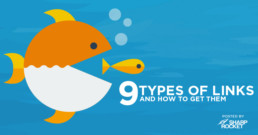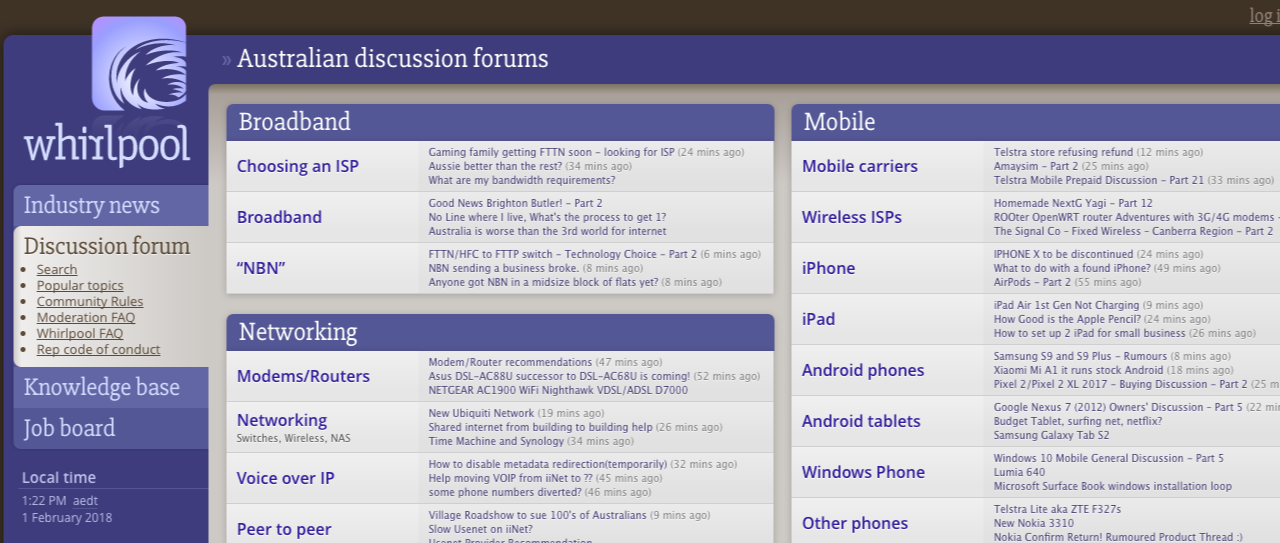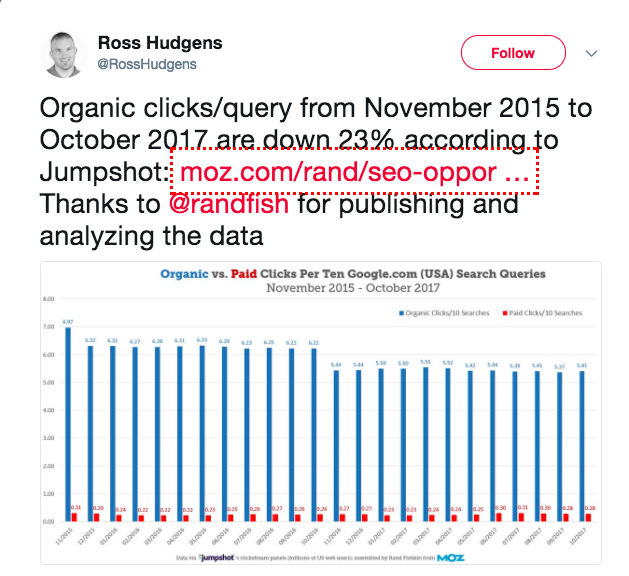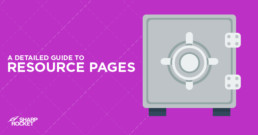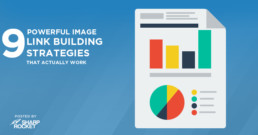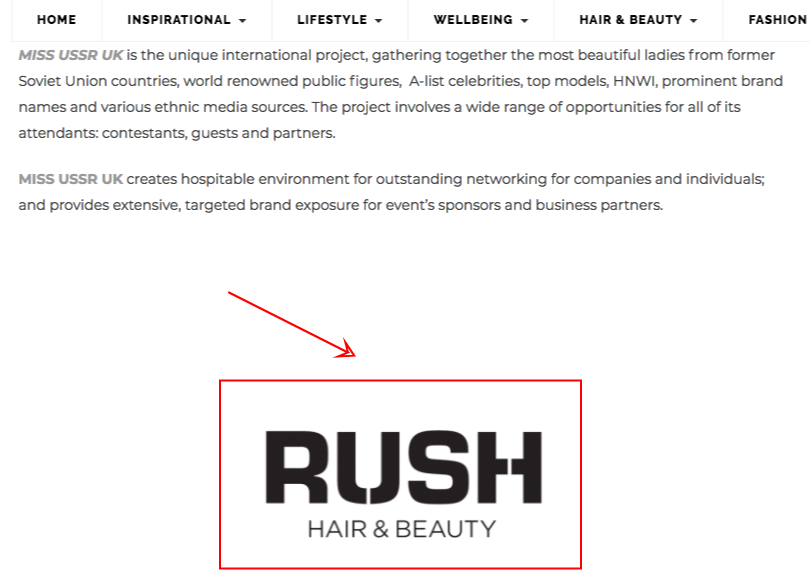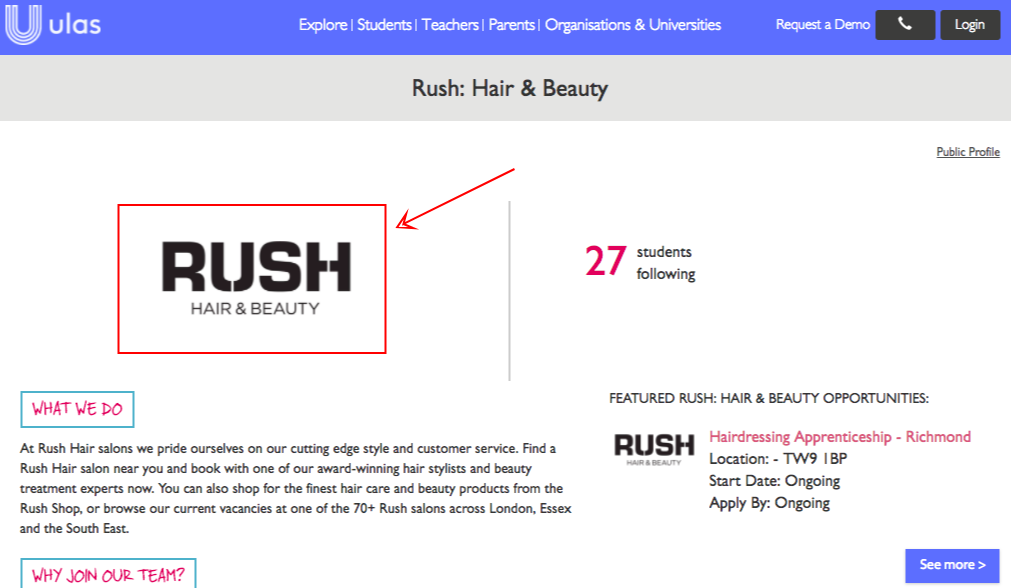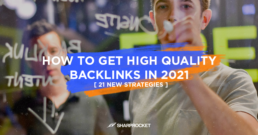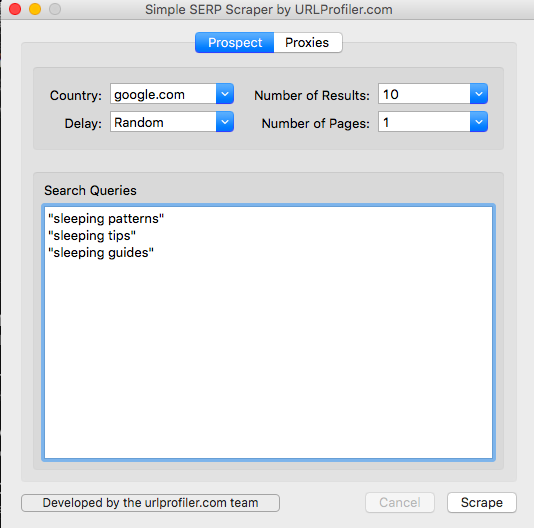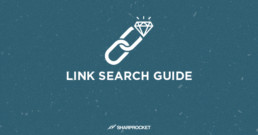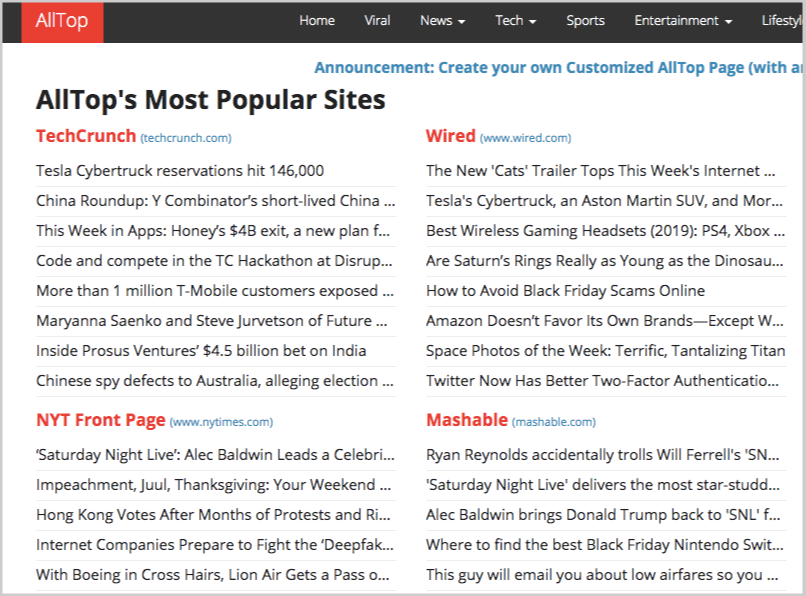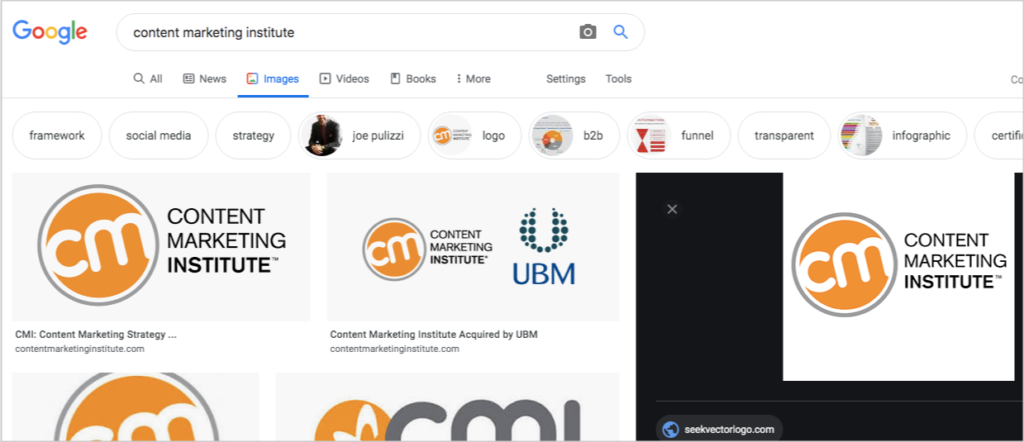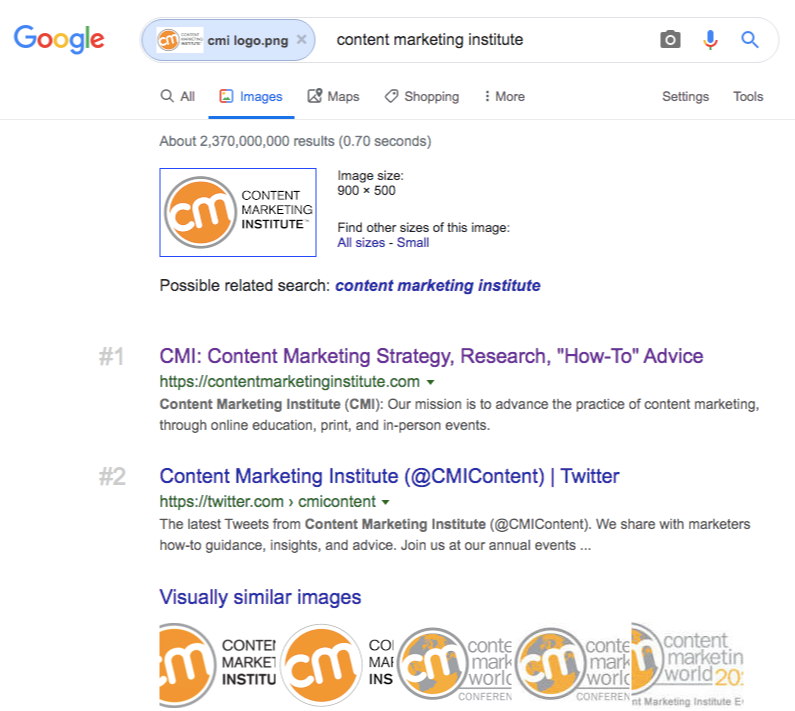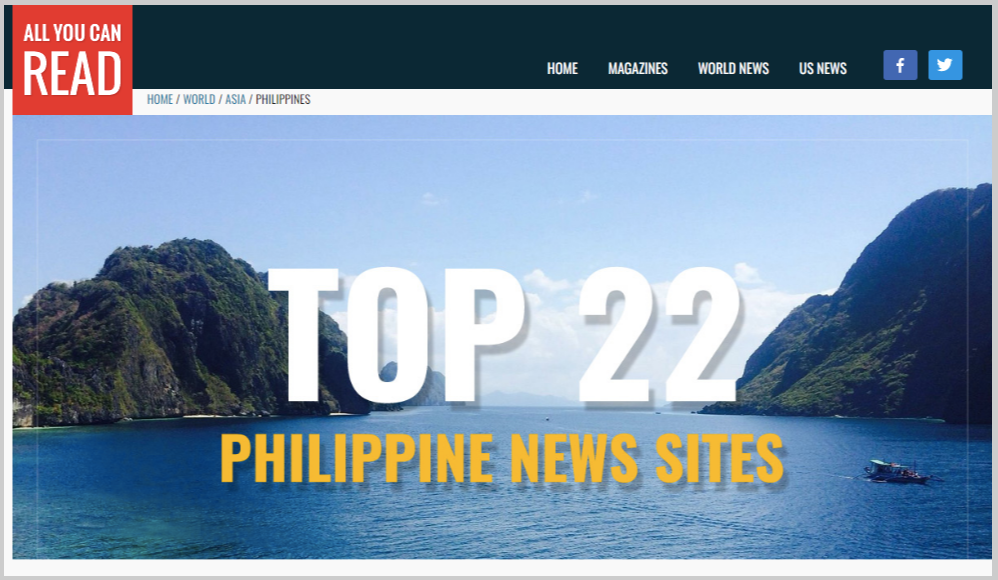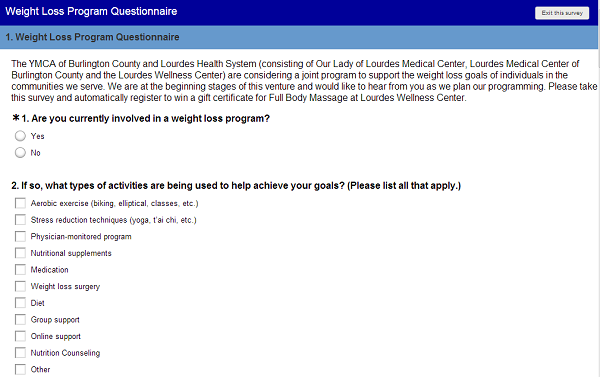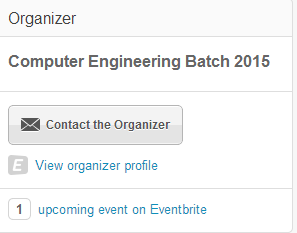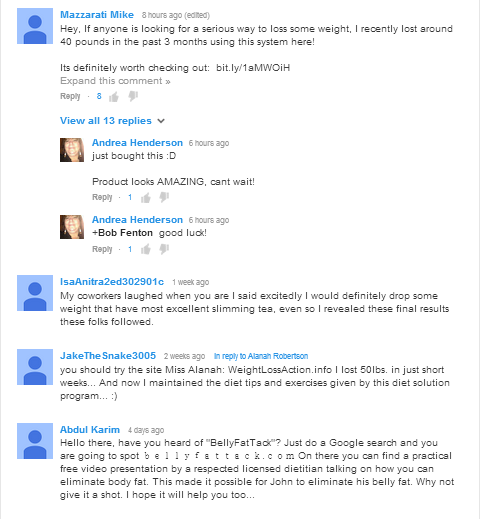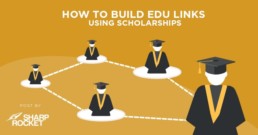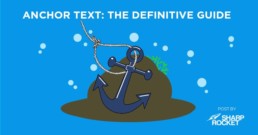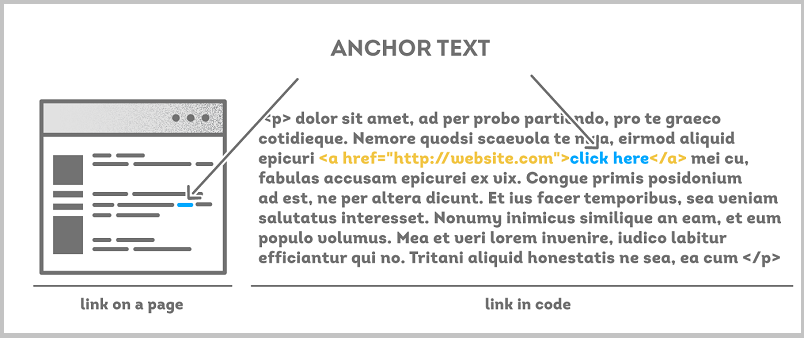9 Types of Links That Matter in SEO And How to Get Them
The types of links that you build matter as much as you execute your link building strategies and tactics.
Just like knowing what kind of salt and pepper to use for your recipe, your cooking becomes more effective when you know what ingredients to use and why you need to use them.
So, to be an effective link builder, you need to understand link types.
Types of Links That Matter in SEO
Here are nine types of links that matter in SEO:
- Natural editorial links (content)
- Manual outreach links (content)
- Self-created non-editorial links
- Discussion-based links
- Sponsorship-based links
- Membership-based links
- Edu and Gov links
- Event-based links
- Natural-editorial links (relationships)
Read below to learn how to get each of them.
1. Natural Editorial Links (Content)
Natural-editorial links are by-products of link earning.
This type of link is acquired organically - meaning there isn't any form of outreach initiative from the side of the person who gets the link. The webmaster or publisher initiates linking to a certain piece of content.
Link-wise, it's nearly impossible to get a similar link type unless there's a high-level reason why a particular person would link to your website.
In my experience, there are three primary factors in how you can earn natural-editorial links:
A. Content Ranked For Referential Keywords
Not all keywords you target can get people to search for it and link to the top-ranking piece (or whatever ranking page they'd find worth referencing).
For example, if you search for what is link building, you'll find that most people would end up typing the exact question, getting the answer, and leaving the page right away.
But there are keywords people search for and link to as a reference for their own content works. These are called "referential keywords".
Here are some examples of referential keywords:
A.1. Topic Templates
Any niche template is highly searchable and is worth linking to. The reason is simple - it makes life easier. If you can have a template to create your own resume without having to write the whole thing from scratch, it saves you minutes (if not hours).
Therefore, the template keyword is one content type worth referencing in a blog post because it gives value worth finding.
Popular examples of this niche-type keyword are job search templates and web design templates (CSS and HTML).
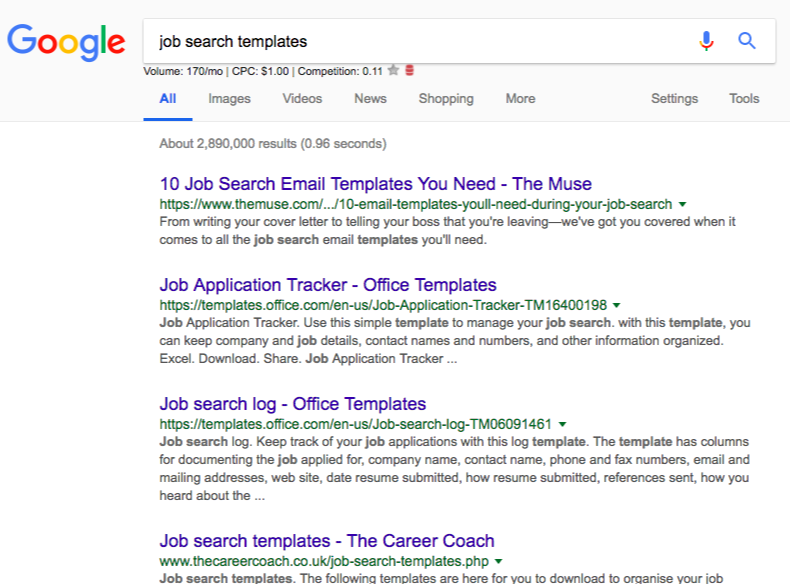
Other template keywords you may also create content around that can fit your industry are the following:
- Christmas tree template
- meal plan template
- door hanger template
- macaron template
- travel itinerary template
- weekly lesson plan template
- wedding seating chart template
- real estate flyer template
- family budget template
Pro tip: Use Ahrefs or SEMRush to search for a specific type of template you could invest a content piece around in your space.
You can use the tool's search volume to type in a keyword + "template" to find niche template terms.
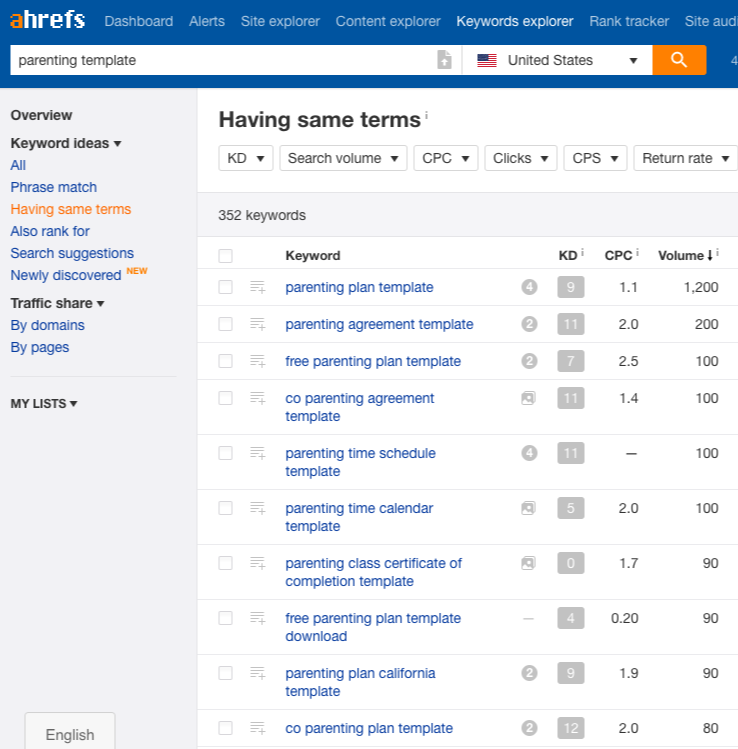
A.2. Tips, Strategies & Hacks
A writer wants to include more tips in his content, so if you have an extensive guide on co-parenting tips, there's a good chance it could be used as a reference on other blog posts.
Example: photography tips, first date tips, rhetorical strategies, camping hacks
A.3. Data
Industry/topic data can be a credible source of information for your writing content. It builds trust from your readers; thus, this type of content has a high likelihood of being linked to by publishers as a reference.
Example: real estate data, snapchat data usage
Exception:
There are niche-type keywords one wouldn't ever think of being referenced by potential linkers. Such is the case with question keywords.
Normally, a question keyword, what is a watchdog? for example, can be easily answered and doesn't require you to refer to a post about that specific topic.
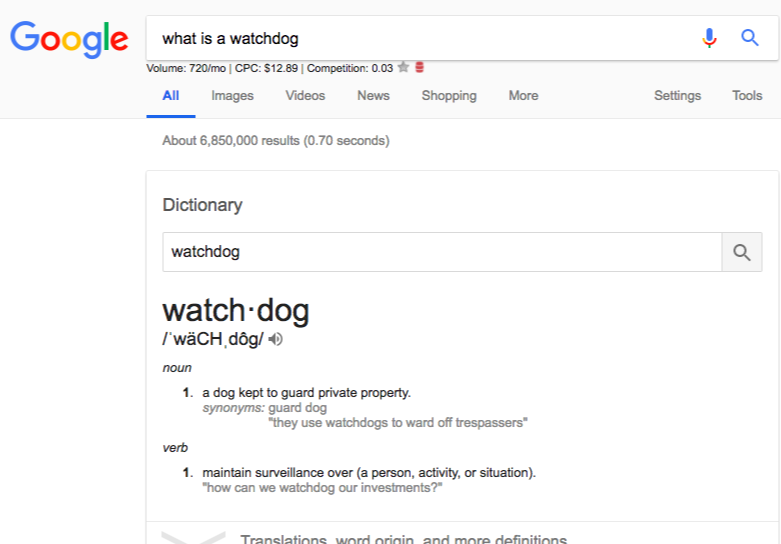
If you're the writer, you think it's only bit-sized information, and you could either list it down or use your opinion if you can answer the question properly.
However, some cases require expertise to answer a question and, thus, allow content creators to create content that doesn't just serve the need but has data/facts to support the answer.
You'll see this happen in health niches. One should have a scientific/medical background before he/she can answer a question.
For example, the search query, "Is snoring a hereditary?", requires content written by a person with a strong health background (Ph.D. graduate).
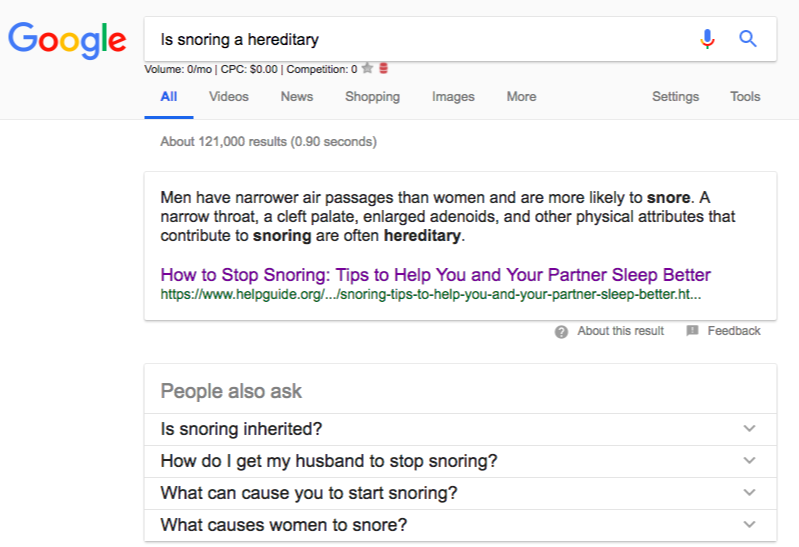
With these niche questions best served with expertise-based content, there are cases when a question keyword can also be a referential keyword. This means that content ranking for such keywords can also be used as a reference by other publishers in their posts.
B. Word-Of-Mouth Bottom Of The Funnel Pages
Another factor that could help you earn links is when your community users, brand evangelists, and those people who know your brand link to you naturally from discussion websites.
What makes it worth earning is the number of conversions you can get from those discussion sites - not just links.
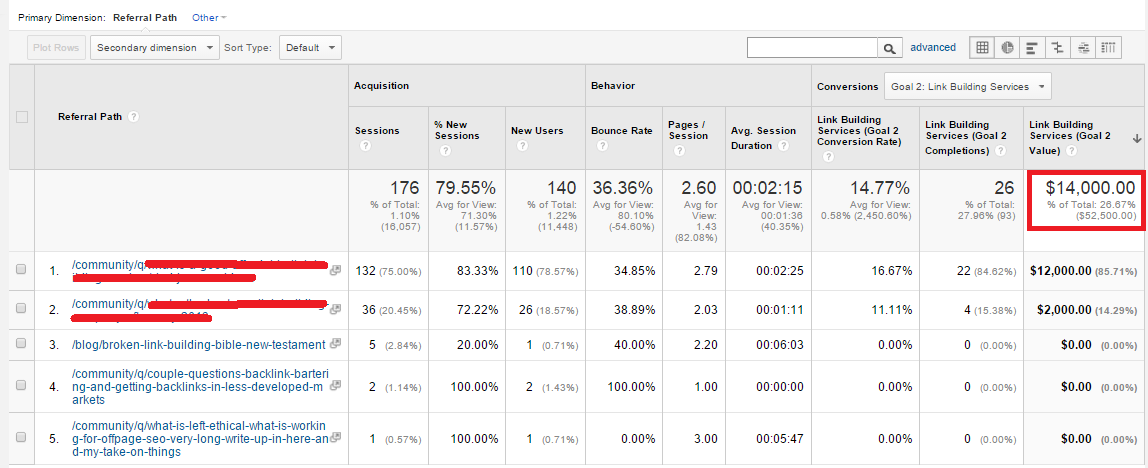
Forum links that point to your bottom-of-the-funnel pages, i.e., your product pages, are valuable from a business perspective - as they can generate sales over time.
C. Strong Brand Authority
Building your brand authority in your space requires consistent messaging and delivery of high-quality offerings.
Whether that's a great product/service, a great brand ambassador, or the length of company existence (with a strong brand presence), the more you could establish any of those factors consistently on your site, the higher the possibility of earning links these way.
For example, Tim Soulo recently published a post on how they grow exponentially at Ahrefs from an MRR/ARR metric perspective.
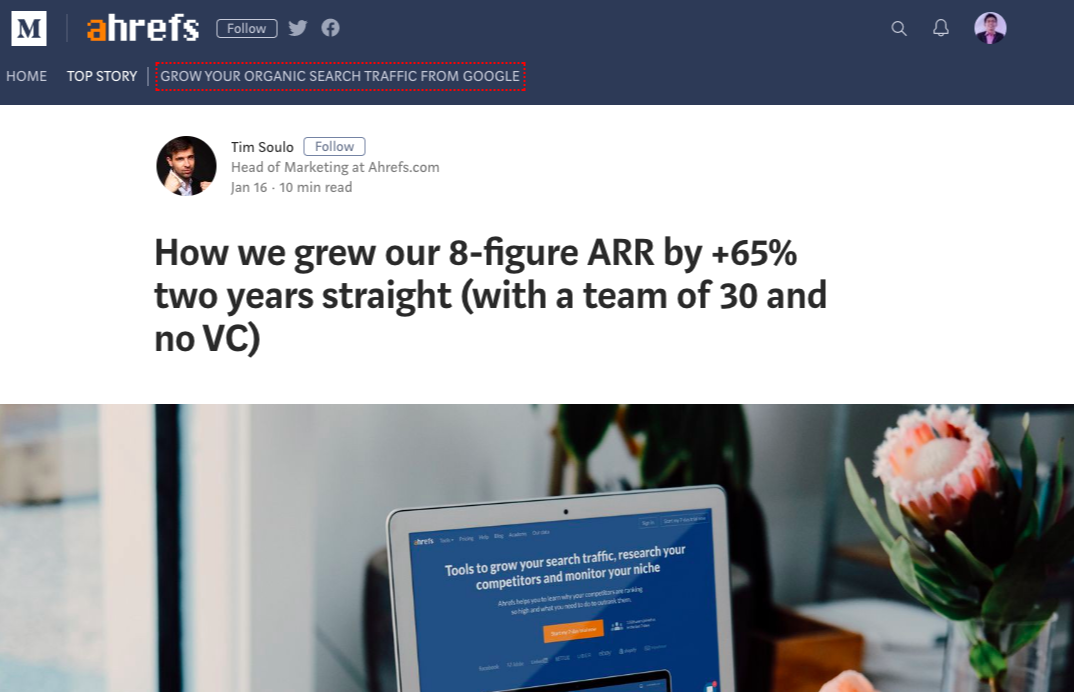
How that possible is their ability to focus on one thing - to improve their product best. The product allows them to earn links from SEO or internet marketing publishers.
(If you've been reading this blog for a long time, you see that I've been linking to them almost all the time when I want to share a tool that can be used for certain link building activities).
This isn't scalable in nature, and the market decides if you have the great/best offering.
But if you're choosing clients to cater to your SEO or link building services, it's something that you have to consider. A brand authority could easily help earn links because it's the community themselves - publishers and products' existing users linking to the organization naturally.
2. Manual Outreach Links (Content)
As implied, manual outreach links are executed with manual efforts - from finding relevant link opportunities to identifying an irresistible offer (valuable to end-users) and sending emails to appropriate contact persons.
This is the most common type of links on the web, given that not everyone has the ability and authority to earn links when starting out.
That being said, manual outreach link building can bring a guaranteed range of the number of links per month (e.g. 6 to 10 links per month) if done right and consistently throughout a period of time.
There are a lot of ways how you can build manual outreach links, and here are some resources that can help you get started:
For this post, I'd like to share with you something that's been overlooked when doing manual outreach link building.
First:
Picking Up New Competitors
If there are only a few inches away from beating up the competition, knowing what your competitors are working on based on their new links being acquired is essential to maneuver your website to better links.
For this reason, you can use Ahrefs to check your competitors' new links.
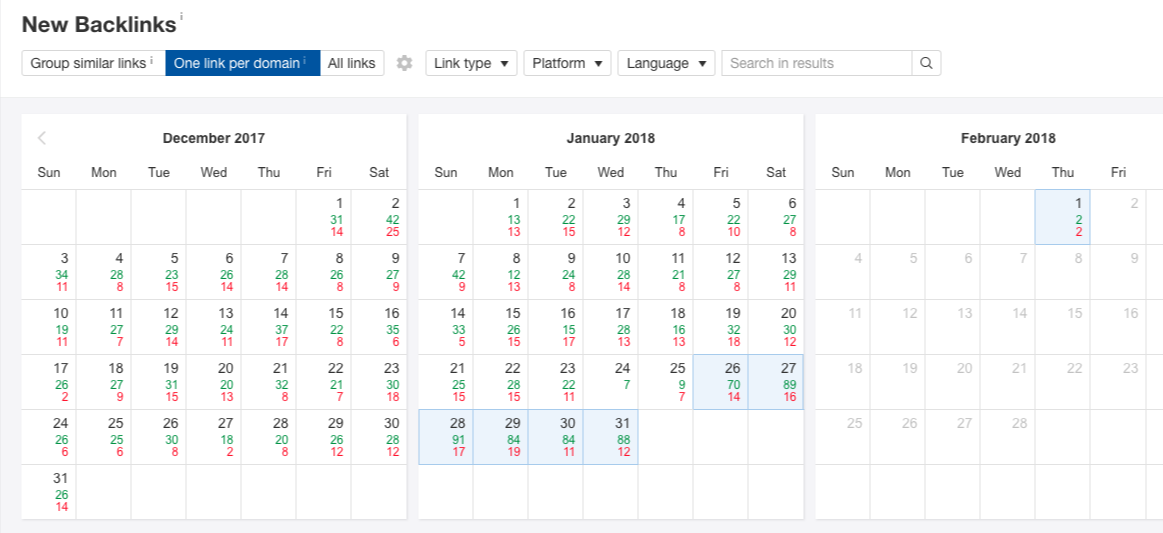
You can even filter indexed links based on a specific period of time (past month, past week, or past day).
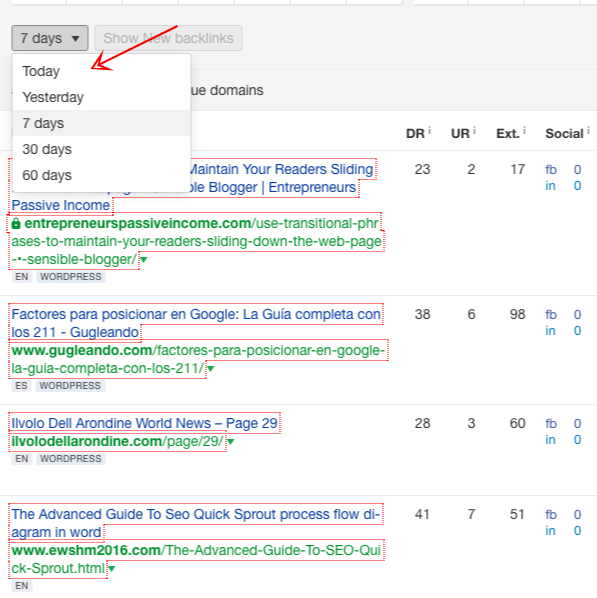
Picking up new links of your competitors, will you give insights as to which link building tactic they're currently focusing on (either niche scholarships or discount programs, for example) and if they are pursuing blogs/sites from other verticals (but still relevant to their brand).
Given their recency of linking, new links acquired by your competitors have high chances of converting into links when pitched since they are more receptive to link pitches.
Linkable Markets For Certain Content Types
A certain type of content serves a particular linkable audience.
For example, an educational guide caters to resource linkers, while bloggers are more receptive to infographics and entertainment-driven articles.
Meanwhile, news editors are looking for more data-studies type of content.
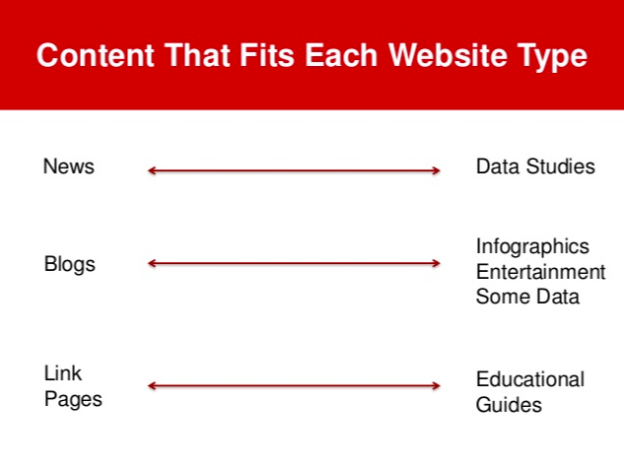
via SiegeMedia
In essence, if you're manually reaching out to a certain linkable audience and not giving them a suitable content type, you're less likely to acquire a link from an editorial perspective.
That's not to say there's no chance of linking. But for every content type, it serves a specific linkable audience.
3. Self-Created Non-Editorial Links
Not being editorially given, self-created non-editorial links tend to carry less weight than other link types. They get fewer clicks to their referring pages than links placed within the body of content. Therefore, from a lead generation perspective, putting all your efforts into self-created non-editorial links is not worthwhile.
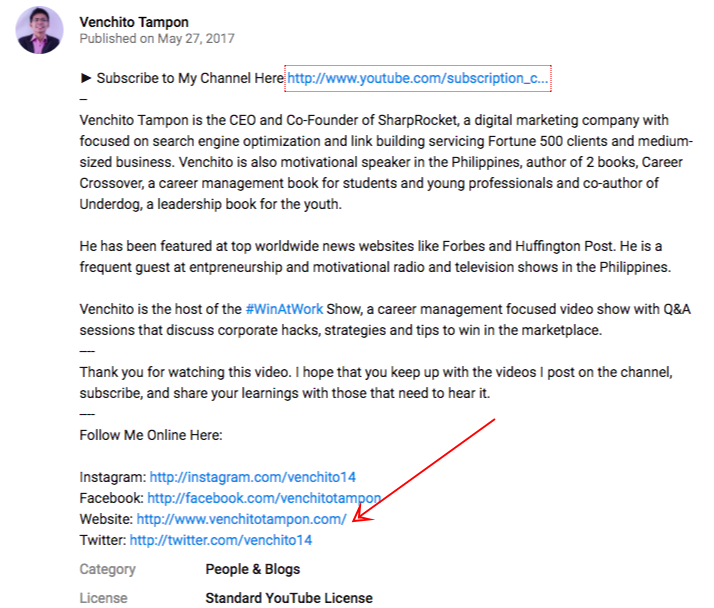
Here are some examples of this link type that I've seen still being built up to this date:
- Not moderated blog comments
- User profile pages
- Forum signatures/profile links
- Not moderated directories
Get this type of links to diversify your link profile, but not too many, given that they don't provide as much link value as compared to editorial links.
The type of self-created non-editorial links you should get is social links.
Here are a few social sites where you can build free backlinks:
4. Discussion-Based Backlinks
Links coming from discussion websites and online boards are proved to be valuable in terms of driving referral traffic and assisted conversions to a website.
Both benefits prove how powerful that link type is, as you're hitting two birds with one stone: traffic and conversions.
To benefit much from discussion-based links, one must consider the following:
- Identify sub-niche boards from community discussion and niche-specific forum sites.
- Consider more quality than quantity (e.g. if you own an eCommerce guitar website, a brand presence on a guitar forum with 5000-ish users is better than a music forum with almost 50,000 users).
- Participate in discussion boards/threads where you can provide value with your expertise. Take note that your goal is to drive traffic through clicks from links. If your participation doesn't engage the users well, driving traffic to your website is more difficult.
- Don't insert links pointing to your commercial pages without relevance to threads. You may be flagged as spam or be banned from the community site.
- Add hyper-relevant links to discussions. If you think a category page is more suitable than a product page, consider adding more.
Here are a few examples of websites where you can build discussion-based links:
Quora
Quora is a question-and-answer site where people benefit from answers to specific queries.
Search for Quora-sub threads that you can follow and find questions from them. Spend 10 minutes providing genuine and valuable answers or solutions to niche-relevant questions.
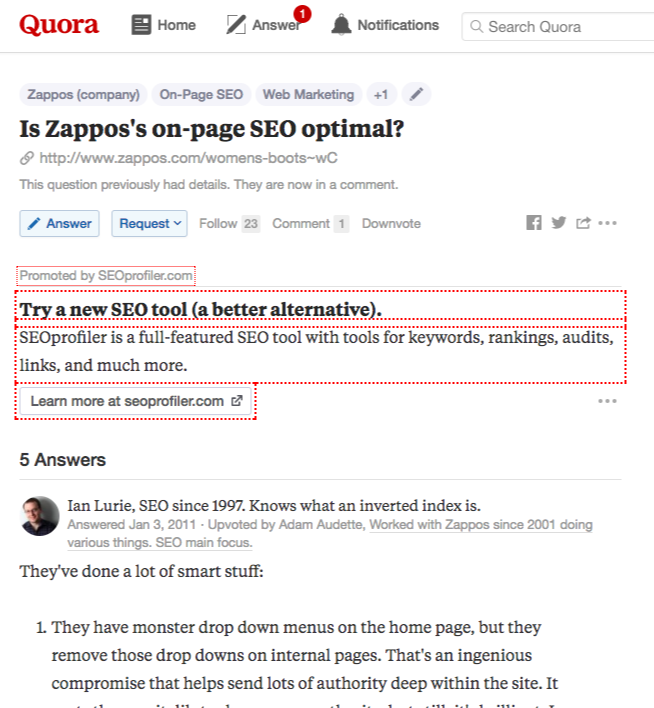
Last year, I put a daily practice to answer one relevant question every single day. It drove not just traffic but potential clients to our agency.
Country And Local-Specific Forums
If you're doing local link building, it's important not just to get relevant discussion-based links, but also hyper-local.
For example, if you're targeting Aussies, Whirlpool is a forum site in Australia you’ll love the most as users (mostly from the tech niche) are highly engaged.
Identifying a forum site like this is worth spending minutes, if not hours, of your time. Genuinely provide solutions to recent questions that will lead to more traffic and leads to your website.
Niche-Relevant Forums
Don Rhoades shared a credible idea on penetrating niche forums for traffic.
He coined the term "forum participating rubric", a method of using criteria to make decisions on participating in forums and online conversations that mention a need for your products.
Here's what it looks like:

Here's what each row means:
Timely: I like to try and stay current, as sales opportunities can go from hot to cold very quickly. Online conversations can change focus just as instantly. As an online retail salesman, you must be ubiquitous in “the showroom,” which any good salesman knows is everywhere he is. You can use this method for current press hits as well.
Collaborative: Agree or disagree, supporting another user’s statement helps you build a relationship, and that’s what link building all boils down to. Remember that your first few interactions will most likely not be a good time to drop a link. This situation calls for patience and being genuine in your responses. Remember, this is not about ranking sites and scaling the shit out of a process. This is about adding value to a community.
Education: This is most likely the best facet of this approach. Every product, no matter how much like other products it may be, has unique features, advantages, and benefits. These are the selling points of your product over others. Your on-site content should communicate these FAB’s and offer the G, which stands for Grabber (ask for the sale, without asking).
Clarity: This is one of the most common 4’s on the scale. The opportunity to address a misprint or correct an opinion formed by the reader is a blessing in disguise. This is also where it pays to have assessed all of your press mentions and link profile. I have often found opportunities to place links to other sites with links that generate sales. BOO-YAH! Some press hits from 2 years ago had no inbound links in the body, but after giving a clarifying statement (with an informational page link), they still bring in significant monthly sales.
by Don Rhoades
5. Sponsorship Links
Getting this type of link isn't groundbreaking. You only need to sponsor an event, organization, charity, or any cause, and in return, you'll receive a link from a specific page.
Here are steps on how you can build sponsorship-based links.
First is to identify niche-specific sponsorship link opportunities.
If you're targeting a local city, it is best to filter opportunities based on its locality.
You can use this search query (inurl:sponsor "INDUSTRY") or (inurl:sponsor "INDUSTRY" "CITY") to look for sponsorship pages in your industry.
The more hyper-relevant your opportunities are, the better link value you can get from them.
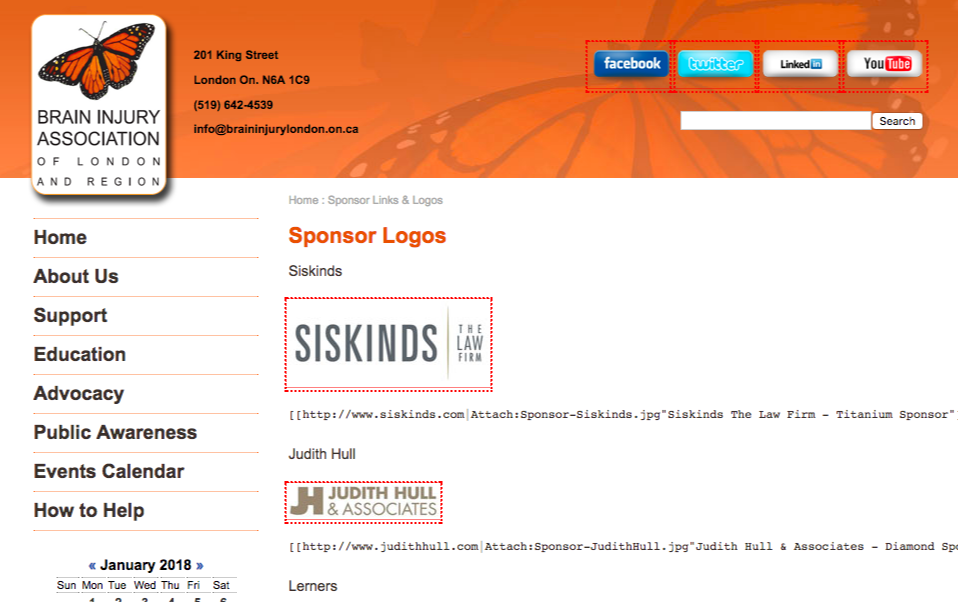
Next is to create a list of these sponsorship opportunities in a spreadsheet.
This way, you'll be able to check each page later on and prioritize which sponsorship opportunity is more suitable to your website and your budget.
Finally, reach out to each contact person on the website/organization with a value offer that suits them.
6. Membership Backlinks
This type of link is a by-product of being part of an affiliate within an organization.
Acquiring membership-based links is based on the idea that if you have joined an organization, whether you're coming off as a personal or corporate, you can get a link from a specific page of that organization's website.
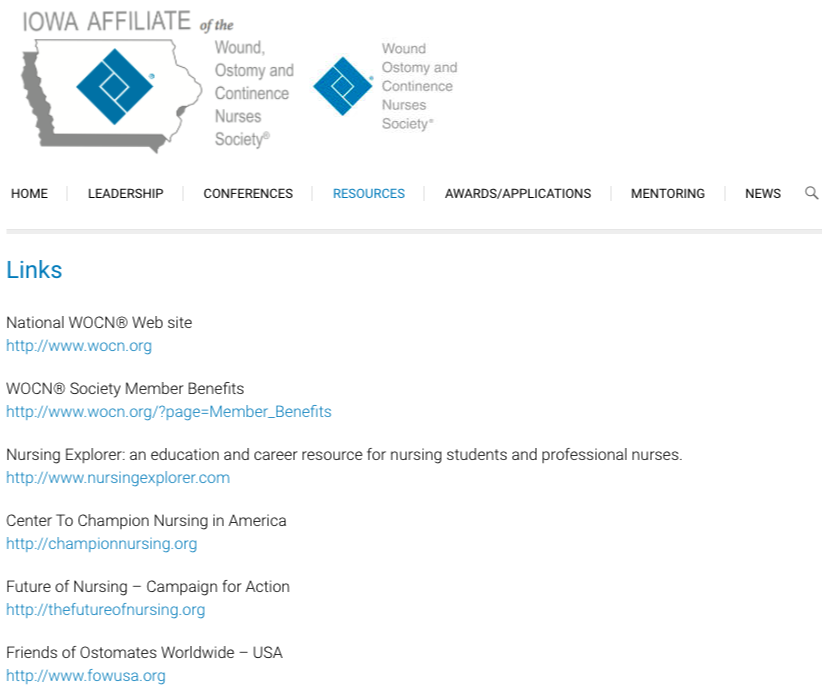
If you're working for a client for link building, it is best to check your company's existing collaborations, partners, or affiliated organizations.
Research if there is an existing membership/affiliate/partnership page in that organization.
See if other companies have links to their respective sites. This is important as you won't be able to get a link from them if, in the first place, they haven't given links to other companies.
When you see one, reach out to the particular organization and ask if you can give you a link from that specific page.
7. Edu & .Gov Links
Search engines highly trust links from .edu and .gov links; therefore, it is a high-quality link type you should aim to get for your website.
These links are difficult to acquire, but certainly, there are many ways how you can score them. Below are some tips on how to get .edu and .gov links.
- Provide a scholarship opportunity for students, and make it more relevant to your brand (e.g. scholarship for disability students if you're selling medical supplies).
- Offer educational content to .edu and .gov sites worth linking to from a relevant resource page.
- Get links from summer housing, internship, and off-housing pages of .edu sites (best fit if you're a real estate site - apartment).
- Acquire links from the "new to an area" page of .edu sites (things to do, local attractions in [CITY], quality schools in [CITY], moving and relocation in [CITY], etc..).
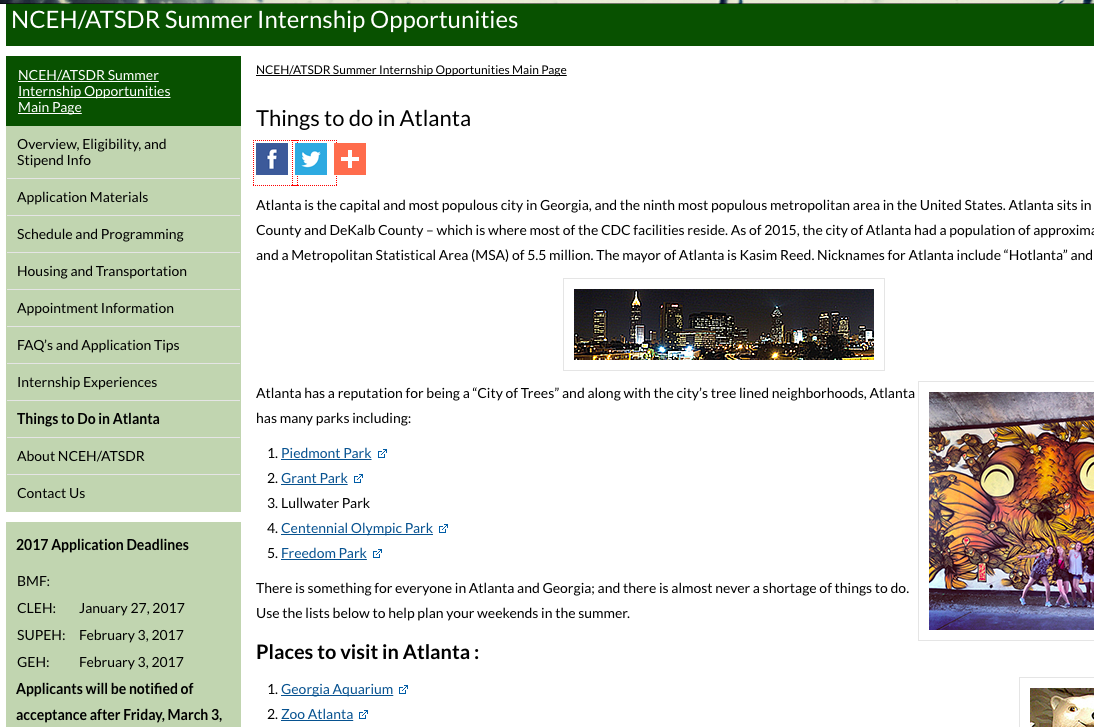
Here are some more resources you can read on building .edu and .gov links:
- Quicksprout's Guide to .Edu and .Gov Link Building
- 4 Ideas for Safely Getting Mentioned by .Gov Websites
- How to Get .Edu Backlinks Using Scholarships
8. Event Backlinks
As implied, these links are acquired using events - either you create your own or just participate.
Here are some ways to maximize events to build links to your website.
Host your own event (whether local or niche-specific).
This requires you to have a set of brand followers (offline or event, much better if it's both) or have built expertise around a certain niche/industry. This way, it'll be easier for you to sell tickets or get people to book slots for the event.

Invite people with linking intent, i.e. publishers of a local media team, bloggers, influencers, or content creators/PR of different companies, to attend your event. Give some free passes or reduce their sponsorship fees if they're a huge win for you (i.e. a big local media site).
If your event is to provide information/content to your audience, it's also important to invite industry experts to speak. This will give you some links, as some may also promote your event from their blogs.
Get your event listed on local or event listing websites/directories. Here are some search queries you can use to find these low-hanging link opportunities:
- [CITY] inurl:event inurl:submit
- [KEYWORD] inurl:event inurl:submit
- [CITY] [KEYWORD] inurl:event inurl:submit
- [CITY] inurl:event inurl:add
- [KEYWORD] inurl:event inurl:add
- [CITY] [KEYWORD] inurl:event inurl:add
- [KEYWORD] [CITY] "submit event"
- [KEYWORD] [CITY] "submit an event"
- [KEYWORD] [CITY] "submit your event"
- [KEYWORD] [CITY] "add event"
- [KEYWORD] [CITY] "add an event"
- [KEYWORD] [CITY] "add your event"
- [KEYWORD] [CITY] "submit your workshop"
- [KEYWORD] [CITY] "submit your course"
- [KEYWORD] [CITY] "submit your class"
- [KEYWORD] [CITY] "submit your conference"
Pitch to become a speaker at an event
Companies hosting events normally have pages on their sites dedicated to that purpose. By pitching yourself to become a speaker at a local or industry event, you may ask organizers to include a link to your website from their event page.
Look at this contextual link I got from a local events page.

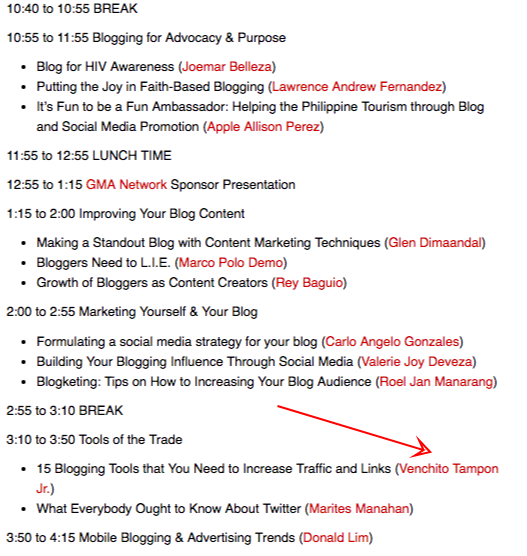
To find speaking opportunities within your region, this newly built platform by Bryan Harris is a great help.
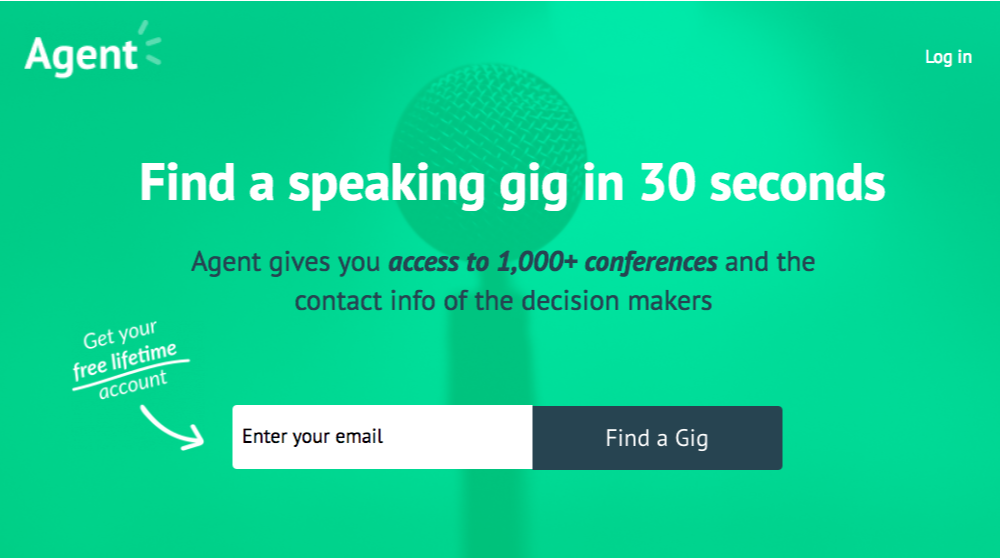
The platform has a filter function that helps you sort out speaking pitch opportunities that are only relevant to your expertise/industry.
Moreover, here are some websites where you can create events, list your events, participate, or even pitch to be a speaker:
And down to our last type of link - relationship-driven links.
9. Natural Editorial Links (Relationships)
Another kind of natural-editorial links is a link that is built through relationships.
Relationships, if started and strengthened through authentic and continuous links can really help someone acquire a natural link.
There is one attribute that allows relationships to result in links.
Reciprocity.
The principle is that when you offer value to a person, it's natural for that other person to give back something in return.
The question now is not how to build relationships, because that is natural for every person, but how to know what value to offer to a person.
Here are some tips on how you can identify and bring that value to a targeted audience in your space (which give you a ton of opportunities to earn natural links in return):
- Make a list of people who you can help and who can also help you strengthen your brand.
- Build conversations with them around industry communities (forums/community sites) and social networking sites. Don't come off as spammy by sending out generic Tweet DMs.
- You can start by sharing their latest content (best if you can customize your tweets to make them unique and enticing for clicks from your followers).
 Promote your best content to them (by giving so, you let them see resources they can use to reference their works).
Promote your best content to them (by giving so, you let them see resources they can use to reference their works). - Influence other influencers. By doing so, you can capture audiences of other influencers when they start sharing content, and you've built strong connections with them as well.
Overall, those are the 9 types of links that you need to remember. Not all of them you will build, but the links you should prioritize can drive traffic and conversions to your website.
Types of Links Frequently Asked Questions
What are examples of links?
Examples of links include hyperlinks within website content that direct users to other web pages and URLs that take you to external websites. Links connect web pages and enable website navigation.
What is the most common type of link?
The most common type of link is the <a> link. This HTML link is essential for content development on your website, as it creates internal and external links for text and images. It is crawlable by search engines, making it highly valuable for SEO purposes.
What is link and type of link?
Links are crucial elements in HTML that allow users to connect to different web resources. They are used to create hyperlinks to various content, including HTML documents, external webpages, multimedia content such as images, videos, audio, animations, or even specific sections within the current document. Understanding the different types of links helps in navigating online content effectively.
What are the different types of external links?
The different types of external links are nofollow and dofollow. Nofollow links don't pass authority to the linked website, while dofollow links do. By understanding and strategically using each type of external link, you can better optimize your website's SEO and guide readers to relevant resources.
A Detailed Guide to Resource Pages
What is a resource page?
A resource page is a carefully curated collection of links to valuable tools, services, products, or websites that can benefit your target audience. Commonly referred to as a "recommended tools" page, an affiliate links page, or a brand "toolbox," resource pages serve as a go-to destination for relevant and useful resources. They help users easily access and find high-quality information.
For example, a resource page about sleeping has subsections for sleep disorders, for sleep forums and discussion boards, and for sleeping best practices. See the image below.
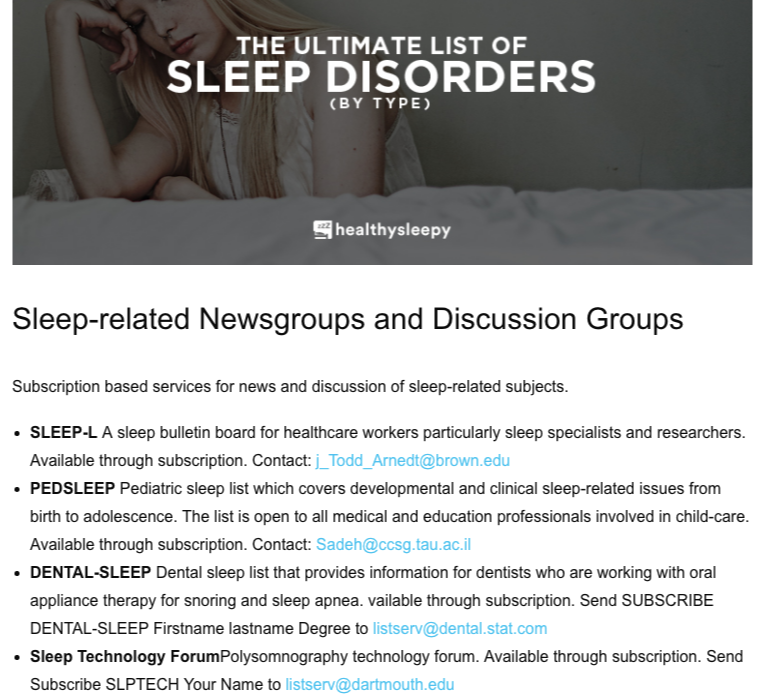

There are many resource pages on different topics in various industries. These pages are curated so people don't have to search for other websites to see these resources. And so it allows people to save time researching the best content on a given subject. All they have to do is to click on each hyperlink on the resource page, and they will land on each resource.
Resource Page VS Blog Post
A resource page is different from a typical blog post.
A typical blog post contains multiple texts, videos, and images. While a resource page only has a list of links (internal and external backlinks) pointing to resources. Though you'll sometimes see a resource page with brief descriptions for each resource link.
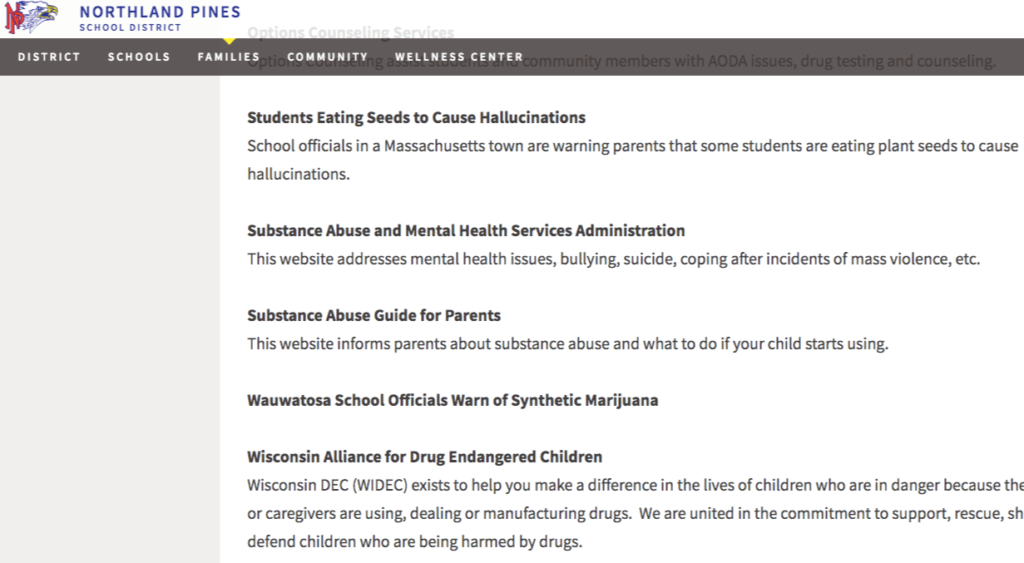
What is resource page link building?
Resource page link building is a link building tactic where a person contacts a webmaster and suggests recommended content assets to be added to a resource page.
This link building technique isn't new. It has been around for decades and popularized by link building experts like Jon Cooper and Garrett French. With their new creative ways to improve the process of building links from resource pages, many SEO professionals have started using it for their marketing campaigns.
Before we proceed to the "how-to" of resource page link building, let's start with more information about resource pages.
1. Resource pages are being updated from time to time.
Though not all resource pages are getting updated, there are many of these types that owners want to change links. Either they remove any broken links they've found or add links to any new relevant content.
The beauty of doing resource page link building is that you don't have to force the owner of the resource page to link to you. Link curators (as we call it) add a link to your content if they find it relevant and valuable enough for their audience.
2. Resource pages can bring traffic (and assisted conversions) to your client's site.
The best types of links are contextual links that drive traffic to your website.
Getting a link from a resource page can help generate additional traffic (referral traffic) to the page it was linked to. This referral traffic is visitors absorbed from another website.
The traffic includes potential customers (assisted conversions) you may convert later in your sales process. If the audience on the linking from the page is part of your target customers, there's a higher chance of a conversion from a visitor into a customer.
Building links from resource pages isn't just for rankings and assisted conversions.
3. A link builder can get 1 to 3 links (pointing to different content assets of your client) from the same resource page.
Resource page link building is a scalable link building campaign that allows you to get one link and multiple links to different content pieces of your site - all from the same resource page.
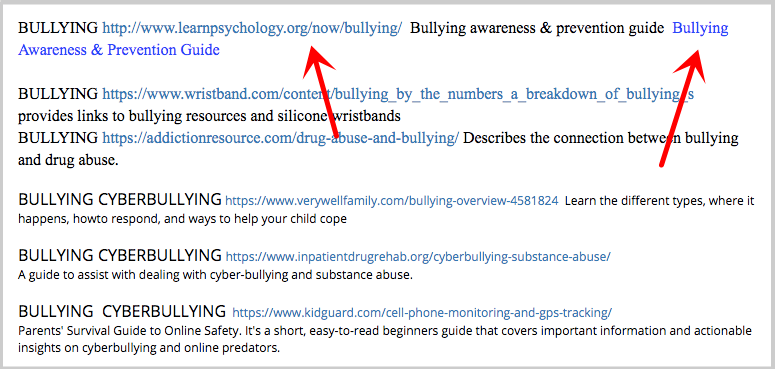

Imagine if you can build relationships with owners of many niche-specific resource pages, and you can scale the promotion of every new content asset published on your site.
Resource Page Link Building Process
Every successful resource page link building campaign starts with a plan. You don't pursue your link targets without any resources to show them. And even before you start your prospecting process, you initially identify whether they are your target audience.
So in building links from resource pages, I have a 5-step process to guide you in making your execution successful.
1. Strategize
If you're an agency, you have a team of link builders. One of which must be a strategist. And if you're doing a solo link building campaign, you don't have a choice but take the role of strategizing the campaign.


So what does a link strategist do?
A link strategist loves the research process.
It takes hours, days, and even years to master the link prospecting methodology for resource pages. It's not the same outreach with bloggers and publishers; you're dealing with link curators.
When you strategize a campaign, you must be diligent enough to do some additional research, not only for the target audience but for discovering specific search queries and other niche-specific approaches your team might be using for link discovery.
A link strategist defines the mission of the campaign.
You're not just building resource page backlinks for rankings; you're doing it because you serve a specific linkable audience. They have a need, and you must serve it with your resource.
A mission-driven resource page link building campaign helps your team to set expectations for themselves and the campaign, even before it even gets started.
When your team has a mission, they'll take the campaign seriously. If the prospect for backlink targets, they don't look for generic sites but try to find ones that will fit the campaign's standards. If they reach out to link curators, they craft email pitches that will engage those people and not just send them a resource for link inclusion.
It's different when a mission is included right at the start of the campaign. It sets the team's mood, ensuring you work on the same page.
A link strategist understands “linkable audience."
Garrett French has created a list of 601 linkable audiences. Coming from his experience with hundreds of resource page link building campaigns, he knew which groups of link curators tend to link out to resources most often than not.


Linkable audiences are link curators who belong to communities with high academic, medical, or government interest levels.
The visiting resource pages are likely to be publishers and ordinary people who do research for their projects.
Understanding that gives you the idea that linkable audiences need a certain type of content that isn't just a 5000-word-ish page but a page that addresses an academic need of a particular audience group.
One note is that these linkable audiences will differ from your target customer personas.
Truth to tell, there is a tendency to go too far away from your brand's customer audience to make a resource page that suits your preferred audience. So be cautious of picking a linkable audience that no longer aligns with your brand's primary and secondary audiences.
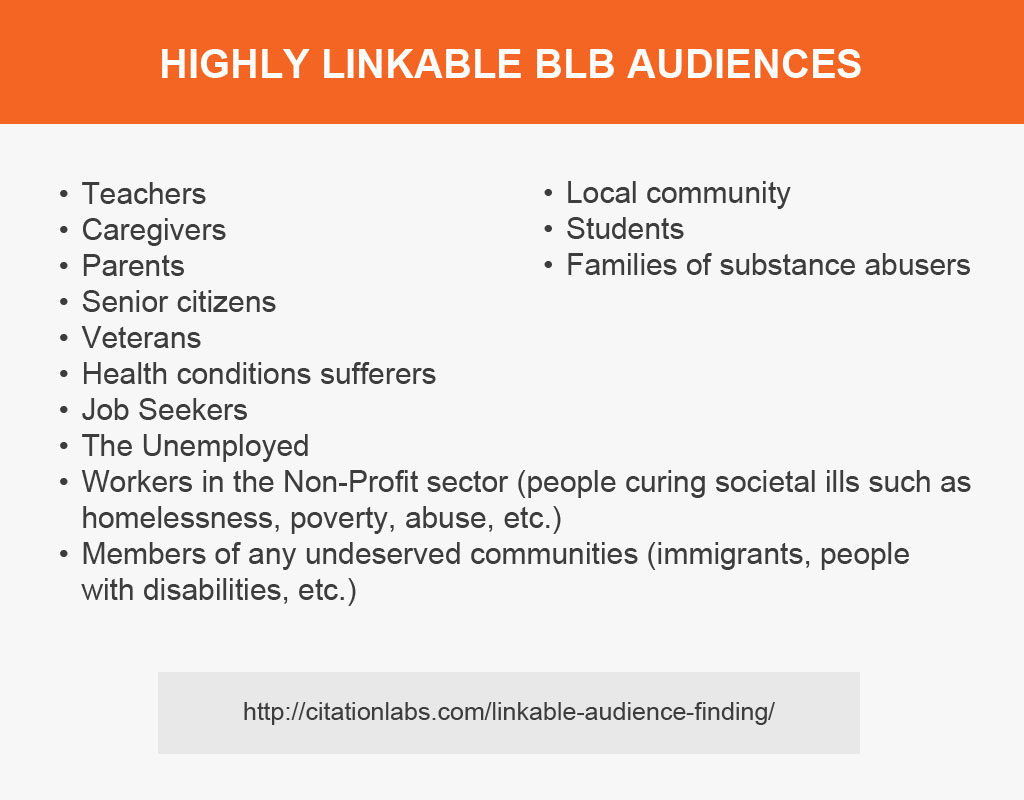
A link strategist suggests linkable content ideas for writers.
Ideation is different from drafting. A person who researches topic ideas differs from the one who crafts the content.
A link strategist helps generate topic ideas that suit a particular audience but are still relevant to a customer audience, to one brand's category, or to the brand's niche.
A link strategist shifts the mindset from sales content to linkable content.
Link curators (linkers from resource pages) are not looking for sales/landing pages or event products/services; they are looking for academic content.
2. Prospect
Once the linkable audience and linkable content topic have been determined, the next phase is to start link discovery.
A link prospecting team can be composed of two or more researchers. Their task is to fill in a given spreadsheet or a given database with relevant resource pages.


What does a link prospector do?
A link prospector finds who linked to similar content guides.
You don't have to start from scratch to make your initial list of backlink prospects. You may go to similar content guides and collect links pages pointing to them.
You can use Ahrefs to check a page's existing links.


The more similar content assets you could reverse engineer for your topic, the more resource pages you could find and reverse engineer for your resource page link building campaign.
A link prospector bookmarks similar content assets while looking for link opportunities.
You'll often find a resource page that links out to similar content topics you could never find simply through Google research. In that case, bookmark them and reverse engineer them to discover more link opportunities.
A link prospector uses different methods to discover resource page link opportunities.
There are many ways to prospect for resource pages. You can start with Google search using advanced search opportunities; here are some search queries you can use:
- intitle:links “KEYWORD” ~guide ~resource
- intitle:sites “KEYWORD” ~guide ~resource
- intitle:resources “KEYWORD” ~guide ~resource
- intitle:“useful links” “KEYWORD” ~guide ~resource
- intitle:“useful sites” “KEYWORD” ~guide ~resource
- intitle:“useful resources” “KEYWORD” ~guide ~resource
- intitle:“suggested links” “KEYWORD” ~guide ~resource
- intitle:“suggested sites” “KEYWORD” ~guide ~resource
- intitle:“suggested resources” “KEYWORD” ~guide ~resource
- intitle:“recommended links” “KEYWORD” ~guide ~resource
- intitle:“recommended sites” “KEYWORD” ~guide ~resource
- intitle:“recommended resources” “KEYWORD” ~guide ~resource
- intitle:“more links” “KEYWORD” ~guide ~resource
- intitle:“more sites” “KEYWORD” ~guide ~resource
- intitle:“more resources” “KEYWORD” ~guide ~resource
- intitle:“favorite links” “KEYWORD” ~guide ~resource
- intitle:“favorite sites” “KEYWORD” ~guide ~resource
- intitle:“favorite resources” “KEYWORD” ~guide ~resource
- intitle:“related links” “KEYWORD” ~guide ~resource
- intitle:“related sites” “KEYWORD” ~guide ~resource
- intitle:“related resources” “KEYWORD” ~guide ~resource
- inurl:links “KEYWORD” ~guide ~resource
- inurl:sites “KEYWORD” ~guide ~resource
- inurl:resources “KEYWORD” ~guide ~resource
- inurl:“useful links” “KEYWORD” ~guide ~resource
- inurl:“useful sites” “KEYWORD” ~guide ~resource
- inurl:“useful resources” “KEYWORD” ~guide ~resource
- inurl:“suggested links” “KEYWORD” ~guide ~resource
- inurl:“suggested sites” “KEYWORD” ~guide ~resource
- inurl:“suggested resources” “KEYWORD” ~guide ~resource
- inurl:“recommended links” “KEYWORD” ~guide ~resource
- inurl:“recommended sites” “KEYWORD” ~guide ~resource
- inurl:“recommended resources” “KEYWORD” ~guide ~resource
- inurl:“more links” “KEYWORD” ~guide ~resource
- inurl:“more sites” “KEYWORD” ~guide ~resource
- inurl:“more resources” “KEYWORD” ~guide ~resource
- inurl:“favorite links” “KEYWORD” ~guide ~resource
- inurl:“favorite sites” “KEYWORD” ~guide ~resource
- inurl:“favorite resources” “KEYWORD” ~guide ~resource
- inurl:“related links” “KEYWORD” ~guide ~resource
- inurl:“related sites” “KEYWORD” ~guide ~resource
- inurl:“related resources” “KEYWORD” ~guide ~resource
- “list of resources” “KEYWORD” ~guide ~resource
- “list of sites” “KEYWORD” ~guide ~resource
- “list of websites” “KEYWORD” ~guide ~resource
- “list of links” “KEYWORD” ~guide ~resource
For agencies, you can use Citation Labs Link Prospector. Here's a video tutorial from the product creator, Garrett French — on how to use CLP for resource page discovery.
LEARN MORE:
A link prospector organizes link opportunities in a spreadsheet
A link prospector must know how to organize every detail of a resource page needed for an outreach campaign.
If you're not using Buzzstream, Pitchbox, Ninja Outreach, or other outreach tools like Gmail with Gmail extensions, a Google spreadsheet is enough to organize your resource page link opportunities.
Here are the column inputs you will provide on a spreadsheet:
- URL (of the resource page)
- Domain (where the resource page is hosted)
- Duplicate (an Excel function to check if a URL/domain has a duplicate in another row)
- Broken Links (inputs if there are any broken links found on a resource page)
- Anchor texts (anchor texts used by the link curator on links to broken resources)
- First name (contact person)
- Email address / Contact form
- Pitch and follow-up dates (more on this one later)
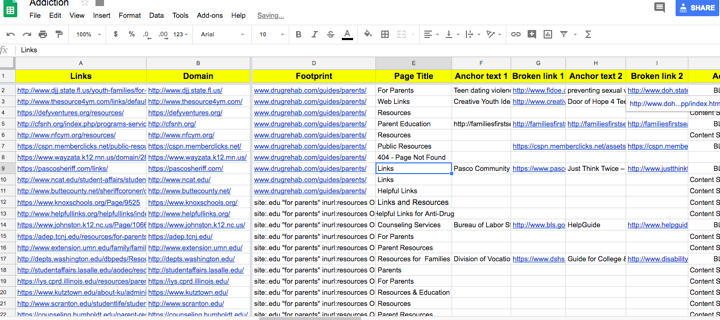

Given that you'll be collecting hundreds, if not thousands, of resource pages, you have to ensure you have a strict input gathering process for your link prospectors.
A link prospector checks resource pages for any broken links.
Oftentimes, resource pages have broken external links. By pointing these defunct backlinks to the page's owner, you can initiate the email conversation.
You can use LinkMiner to manually check if the resource page has any broken links. For one links page, the tool will take 15 to 30 seconds to check all of the external links for any broken links.
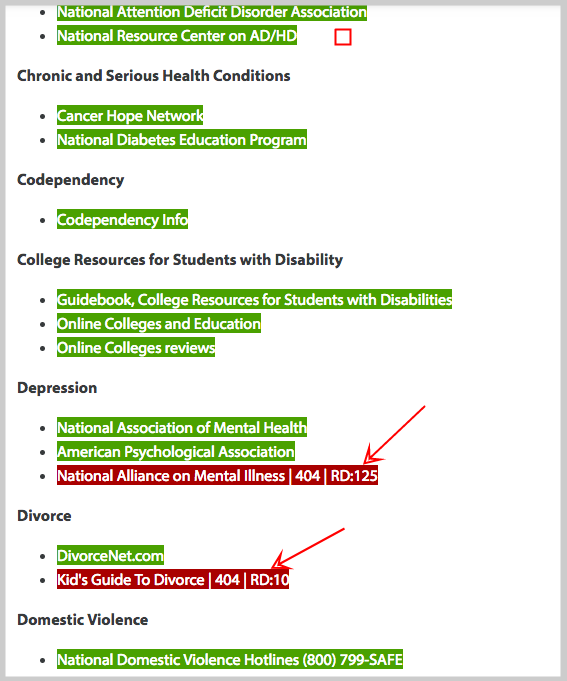
3. Create
The linkable content piece is the bridge between an outreach specialist and a linker.
You can only get a link from a resource page if you have a good content asset to offer. You are not selling your commercial product/service but a content asset that provides value to their audience.
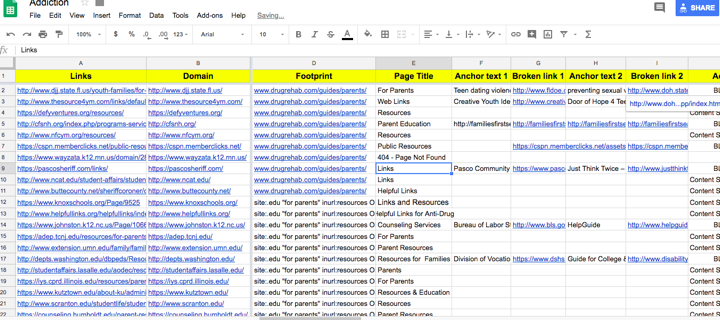

A great content asset requires the role of a content developer — from its planning to actual publishing.
When creating the content piece, a content developer thinks of his/her audience.
The content developer begins creating when the link strategist submits the list of linkable topic ideas. From the introduction to the conclusion of the piece, the content developer must have a linkable audience in mind, as it is who he/she is writing for.
A content developer fills key knowledge gaps.
The way to make your content asset more comprehensive than other similar assets is to identify what gaps in terms of information others haven't yet fulfilled in their own content that you can fill in yours.
A good question to ask is this:
Can you add something about the topic that hasn’t been written or mentioned from their content, or better – elsewhere?
To solidify and emphasize certain information, look for content gaps like defining terms or relevant industry data/statistics. By giving your consumers a new blend of tastes they won't find anywhere else, you increase the comprehensiveness of your content and its potential to acquire links your competitors won't copy easily.
A content developer suggests a new format for the overall content asset.
Different people have different styles of learning. Adding elements like videos, images, audio, and other content formats to your content asset would make your content easy to consume for different people and increase its value to people looking for references for their content works.
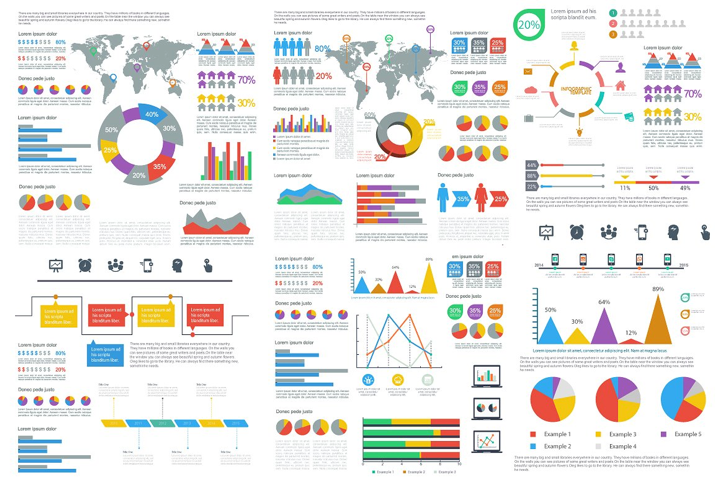

Always remember to aim at the highest level of utility and not just word count. You can create a 10,000-word page, but you may have wasted resources on additional unnecessary text if it doesn't satisfy its target audience's needs.
A content developer should be open to revision requests.
Big agencies normally have support systems for quality control of the content. They have a team of other content writers who check and balance information if it's updated and suited to particular industry standards.
The content developer must be patient to go back and forth with the content for any upgrades and revisions the team may have identified as they check the page.
Best Resource Pages Examples
Here are some websites to inspire you to create linkable content assets, specifically ones that are constantly producing pieces that get links. I also included below links to their best resource page examples:
DrugRehab.com
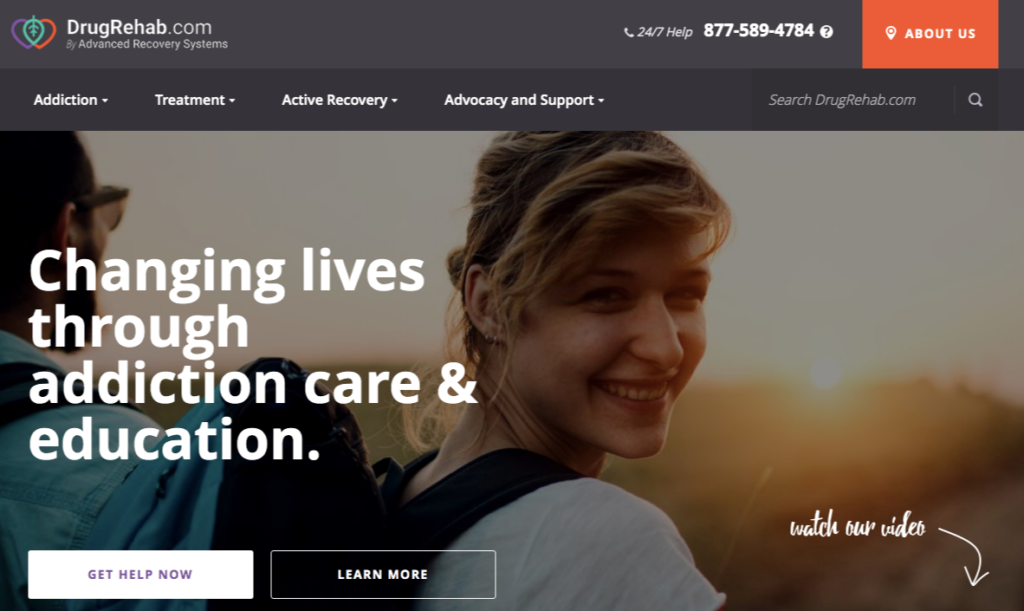

Resource page examples from DrugRehab:
- A Substance Abuse Guide for Parents (~500 referring domains)
- Teen Drug and Alcohol Abuse (~340 referring domains)
- Domestic Abuse, Sexual Violence, and Substance Use (~358 referring domains)
Accredited Online Schools
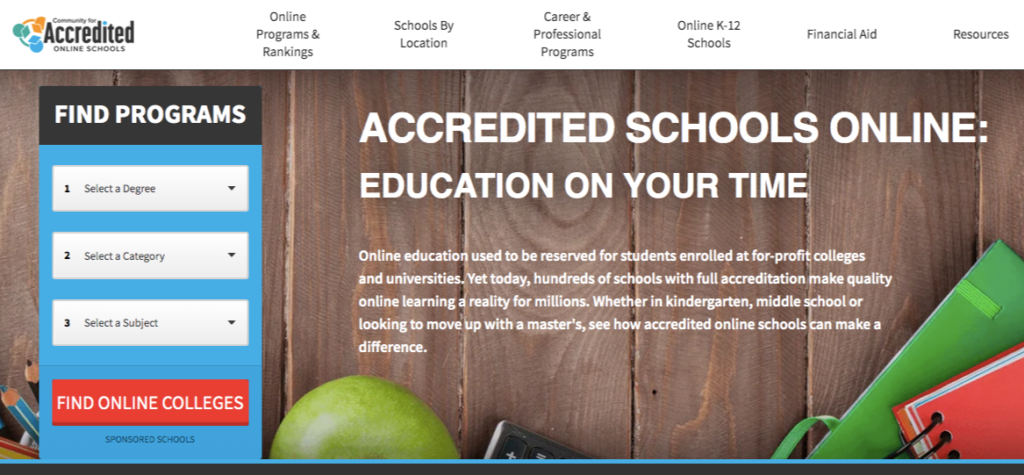

Resource page examples from Accredited Online Schools:
- Bullying Awareness and Prevention (~249 referring domains)
- College Resources for Veterans and Their Families (~262 referring domains)
- Understanding & Preventing Plagiarism (~276 referring domains)
4. Engage
Content creation is only half of the battle. The other 50% is promoting your brand asset.


Here comes the role of outreach specialists.
What does an outreach specialist do?
An outreach specialist crafts email copies.
When crafting email copies, consider these three Cs:
1. Clarity
Your email copy must be clear enough to understand your link curators. It should contain why you're reaching out to them and the description of your resource content.
A good tip for you is to send it to at least three team members to check if your email copy has clarity.
2. Captivity
Does your subject line capture the interest of your link curators? If it's too generic just like other email templates scattered on the different SEO articles — and does not personalize specifically to your target link curators, your email copy may lose one component - captivity.
3. Continuity
Here is a good email crafting tip from Dave Gerhardt, VP Of Marketing of Drift.
subject line & the first 2 lines of a sales (or marketing) email are everything.
Things to skip:
- “as [job title] you know that [pain]”
- “I know you’re busy, but.”Use the 1st line to get someone to read the 2nd.
2nd like to get them to the 3rd, etc.
— Dave Gerhardt (@davegerhardt) May 6, 2019
Your target link curator must be able to start opening your email and continue reading it until the end. It requires some copywriting skills, but as you constantly improve your email copies, you get a sense of what works and what does not.
An outreach specialist sends follow-up emails to non-respondents.
Follow-ups are needed for link curators who don't respond to your initial pitches. Write a short, non-aggressive follow-up email copy to inform them of your previous message, or include it in your follow-up email template.
An outreach specialist converses with respondents until he gets links.
There's no sure-fire way to create email templates when you're already talking to your target prospect.
Dynamics come to play in email conversations. An outreach specialist must be trained to answer different email copies in different contexts and linkable audiences being talked with.
You can check out this post on six email outreach tips.
Here are some tools you can use for doing outreach campaigns
- Voila Norbert
- Hunter
- Mailtrack
- Email Verification Tools
- Outreach platforms
5. Win
The last step on how to build links from resource pages is to win the link.


Often, there will be link curators who will not respond to your initial pitch, even your follow-up email, but will link to your content from their resource page.
Silence in response doesn't mean "no."
The link strategist or outreach specialist must learn to monitor any new links to the content asset you're promoting.
You can use Ahrefs to discover any new links to the page quickly.


So, that's how you build links from resource pages. Follow the 5-step process: Strategize, Prospect, Create, Engage, and Win.
Resource Pages Link Building Resources:
The No Non-Sense Guide to Broken Link Building: A super-detailed guide to broken link building with many real-life examples and techniques.
Four Reasons Why You Don't Get Resource Links: Failures are part of a resource page link building campaign. Learn why link builders don't get resource links in this article.
4 Advanced Link Prospecting Techniques for Increased Efficiency: Speed up your link-gathering process to collect more link opportunities for your campaign.
Getting Dofollow Backlinks from Primary Schools. Most links come from primary and secondary school websites, learn how to acquire do follow backlinks from this article quickly.
Resource Pages Frequently Asked Questions
How do you write a resource page?
To create a successful resource page, consider these 5 key tips:
- Organize your resources by category.
- Provide brief descriptions for each resource.
- Include high-quality and relevant resources.
- Regularly update your resource page.
- Make your resource page easily navigable.
By following these tips, you can create an effective and user-friendly resource page on your website.
What should a resource page look like?
A well-structured resource page should have valuable content, including links and keywords related to the topic. It provides a comprehensive overview of the subject, making it a go-to source for information. When optimizing a resource page, ensure it offers a macro view of the topic and covers relevant subtopics to enhance its value. Remember to include clear headings, descriptive titles, and properly formatted URLs for better SEO performance.
What is the importance of resource page?
Resource pages are crucial for SEO due to two main reasons. Firstly, they benefit publishers by generating social shares and backlinks from those featured on the page. Secondly, external resource pages can serve as valuable assets for link building efforts, boosting website authority and visibility.
9 Powerful Image Link Building Strategies (That Actually Work)
What is image link building?
Image link building refers to acquiring high-quality backlinks by creating and sharing relevant visual content. By strategically creating and distributing appealing images, you can generate organic links that drive traffic to your website. This approach helps increase online visibility and establish your site as an authority in your industry.
If there's one under-utilized content asset of any website today for link building, I'm sure it's images.
Most of you think it has lesser link acquisition value than other content types - probably for two reasons: One. It doesn't catch longevity. Unlike a typical 3500-word ultimate guide, normal images don't inform a lot of messages.
Two, it's plain, simple, and most of the time, it's commercial context. If a visual asset originates from your company, for example (i.e. branded team photos), you would think it's not usual for a blogger to link to such a particular piece. And your next problem is, how can I remove the commercial intent in these images?".
These examples of link builders' dilemmas cause you not to believe much in the power of image link building.
I hope that at the end of this post, you will have plenty of ideas on using images to build links for your site.
Below is a list of 9 image link building strategies that we had the most success with. They can be used in conjunction with others to increase the value of the proposition for outreach.
9 Image Link Building Strategies
1. Skyscrape Old Infographics
If the word "infographics" is for sale in the SEO market, I think it's sold out already (and perhaps a best seller).
Just kidding.
Infographics are abused in almost all industries. Try searching for your "industry" + "INFOGRAPHIC" as your keyword phrase in Google, and you'll start seeing tons of infographics published.
Not all of them give much value to users, of course.
One way to break the noise is to observe your industry's visual market and see which visuals previously gained success and which didn't work out well.
By doing that, you can start digging into old and most-linked images. When you see one, you start to strategize how to update it and give a revamp.
Skyscape is an old visual asset.
How can you do that at scale?
Use Buzzsumo and its "infographic filter" and search for a topic relevant to your industry.


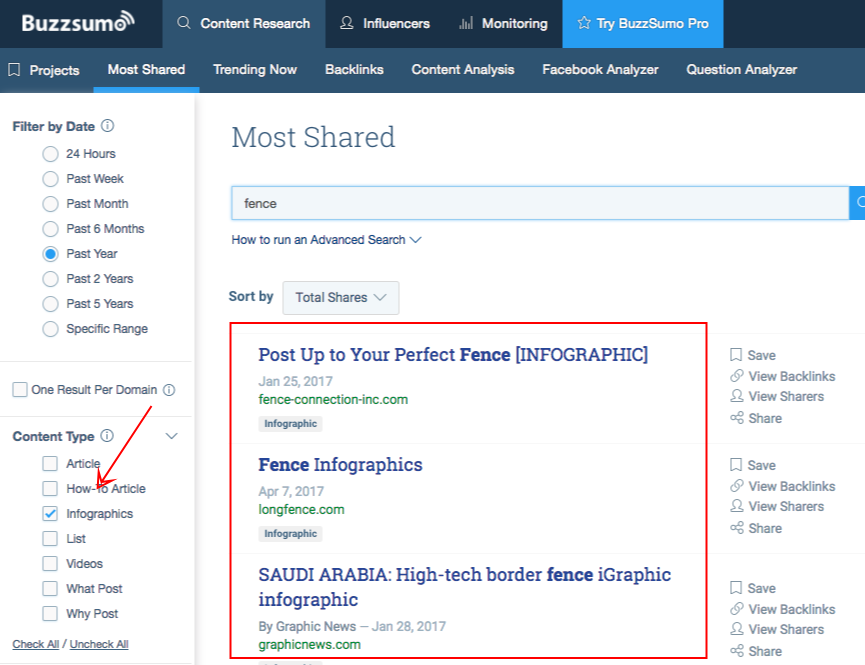

You enter industry keywords and look for previous infographics that got shares and links, some just earned shares, and it's okay. A neat probability share could result in a few links in visual marketing.
To promote infographics to get links, you can check out this blog post about guestographics.
2. Utilize Event Experiences Using Freelance Photography
Events become memorable because of great experiences. No one will deny that he wants to return to certain events where he had a great time on the same date and in the same place, if possible.
It's classic. And what would make someone remember those events?
Photos.
A huge link opportunity awaits you if you can utilize event experiences with freelance photos. Get someone to cover an event with freelance photography.
Instead of sponsoring bucks or free pizzas for after-event parties, hire a freelance photographer to cover that event.
Get those high-quality captures, upload them on a specific page on your website, and dedicate that page just for that event.
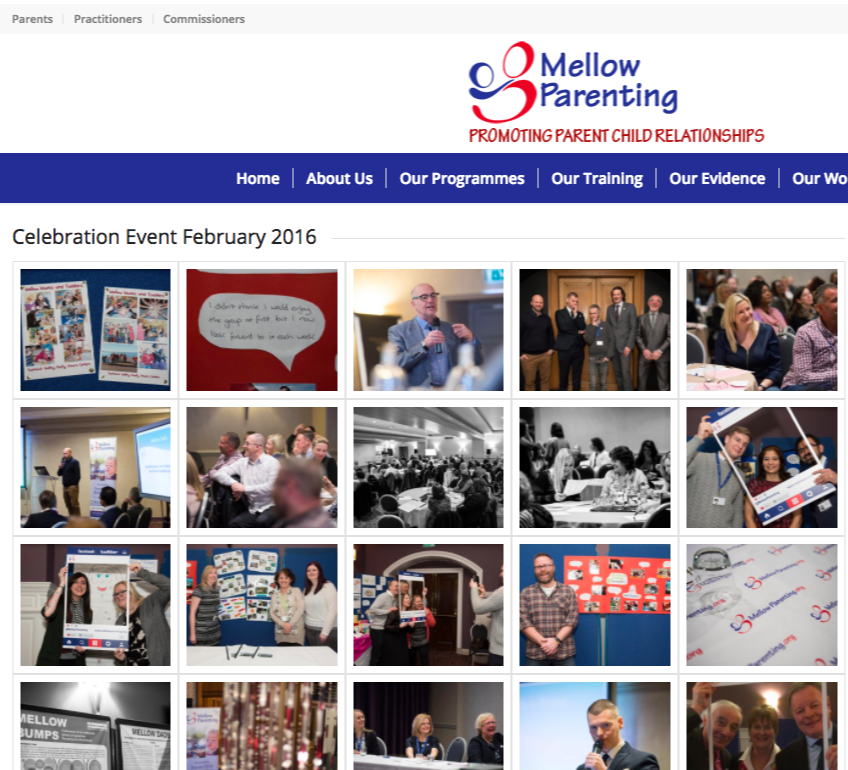

Reach out to event organizers and let them know that you have captured great experiences on your website, and these are publicly available for republishing/resourcing. Politely ask those who have used your photos to credit you as the original source.
Depending on vertical markets, if there are niche bloggers/marketers/PR professionals who may have attended the event, there are more link opportunities that you'd see coming from participants' own websites.
3. Create Content for "Quotes" Keyword
People love inspiration. And getting quotes from anywhere is one way to hype up one's day.
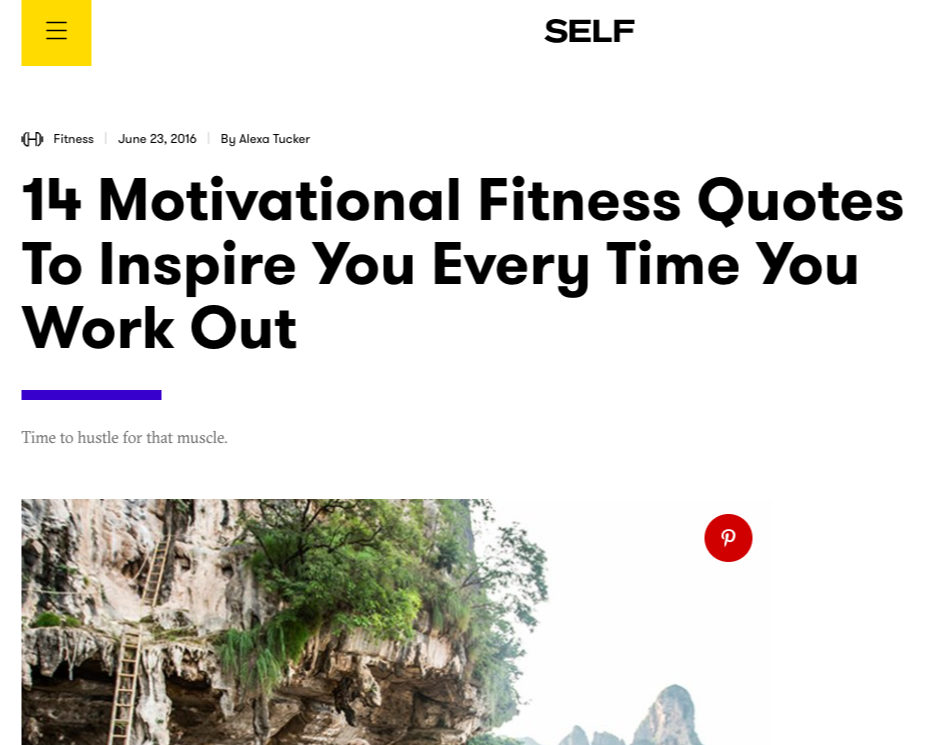

Knowing that, if you take industry quotes (e.g. parenting quotes) to a keyword research tool, you'll see an immense opportunity to cover content specific to that.
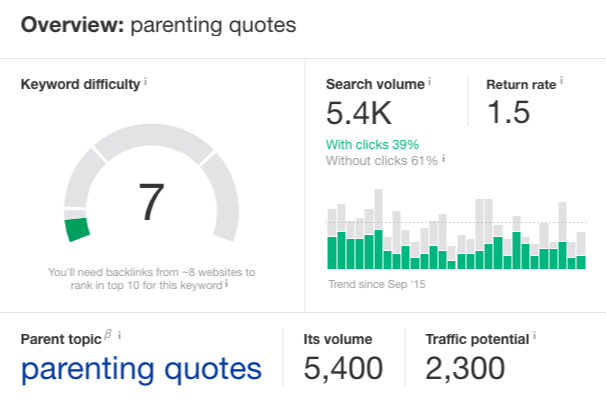

Though most industry quotes you'll see are just a compilation of all sayings/wordings from different sources or people, there are surefire ways to help your content get more visibility and help it rank on search.
Ross Hudgens shared that in a post on ranking for "quotes" keyword:
- Aim for the Most Quotes on the SERP - if you see 80 quotes, try to aim for 120 or 150, for example.
- Make Shareable Images for Some Quotes - shareability is important to get more visibility to the content.
- Use Longtail KWs as H2s or Filters - to rank for related keywords, like "parenting a child with disabilities" quotes". You can categorize quotes based on different audience intent.
- Add Share CTAs on Individual Quotes - add customized tweet-to-share buttons to individual quotes to increase social shares.
In addition, here are some more actionable tips to maximize quotes content for link building.
The first is to include sayings or statements of your industry influencers.
Having them in your blog spotlight gives them a reason to share your "quotes" page as you give them exposure upfront.
One way to find their best statements is to check their top-performing/best articles. Get one or two statements they said powerfully (and probably would be found valuable to other people in your industry).
Create an individual graphic just for that. Then, reach out to those influencers and share your content.
The second is to make it part of a big post.
If you're creating content you think one quote from your "quotes" page fits best, make it part of that content. By doing so and including a link to your "quotes" page, you increase its visibility - that more people will visit and check the page.
4. Repoint Slideshare Links To Your Website
Whether it's a personal brand or corporate profile, if your organization's brand ambassador, marketer, and industry practitioner gets invited to speak to different events, chances are you'll have a library of slide decks.
You may haven't uploaded them yet on your own website or public platforms like SlideShare.
But if you do, congrats! Otherwise, there's a missed opportunity there to get links. In fact, in industries where there is a huge demand for expert information, slides are strong assets for links.
If you have uploaded your slides in Slideshare, track how many links it organically receives. You can semi-automate this process by creating alerts to give you email notifications when a link to a specific page has been found.
Ahrefs can help you with this.


You can go deeper by tracking mentions of a popular slide you have uploaded (which you probably have the confidence that it'll get shared massively and earn links based on its initial visibility).
Say, if it has been viewed a thousand times without much promotion, you may expect it to be seen more organically, and if you boost it with manual promotion, there's a high chance it can receive some links.
Your next action is to email publishers who have embedded your slide/s in their content and ask if they could link to your website.
Nudge bloggers with specific anchor text that they may use, i.e., you can state lines like this in your email, "You may link to [domain.com] with texts like, via "Brand/Persona".
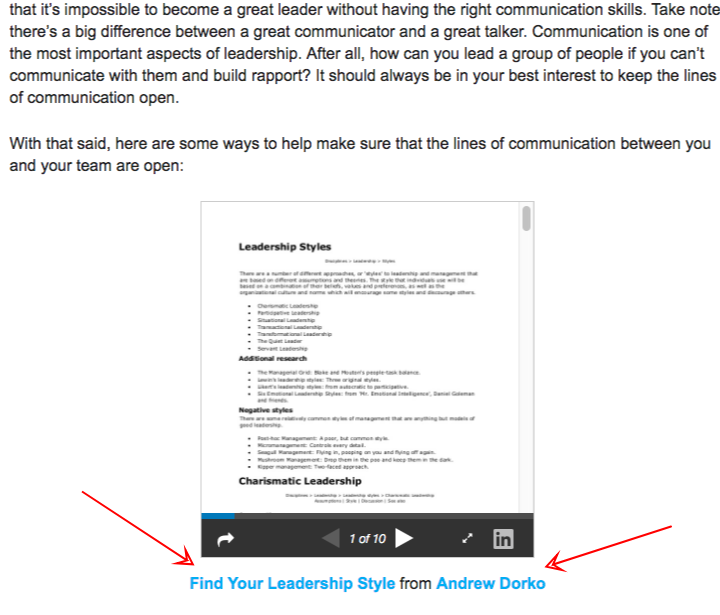

By doing so, you increase your conversion rate, as you remove the commerciality intent of your pitch.
This link building tactic is simple yet underutilized by link builders for clients with strong speaking portfolios.
Further Reading: The Definitive Guide to Link Reclamation
My fifth image link building tip is connected to the method above.
5. Curate Conference Slides
One clever way I've seen in company blogs to get more site visibility is publishing a curated list of slide presentations of all the speakers when they have organized an event.
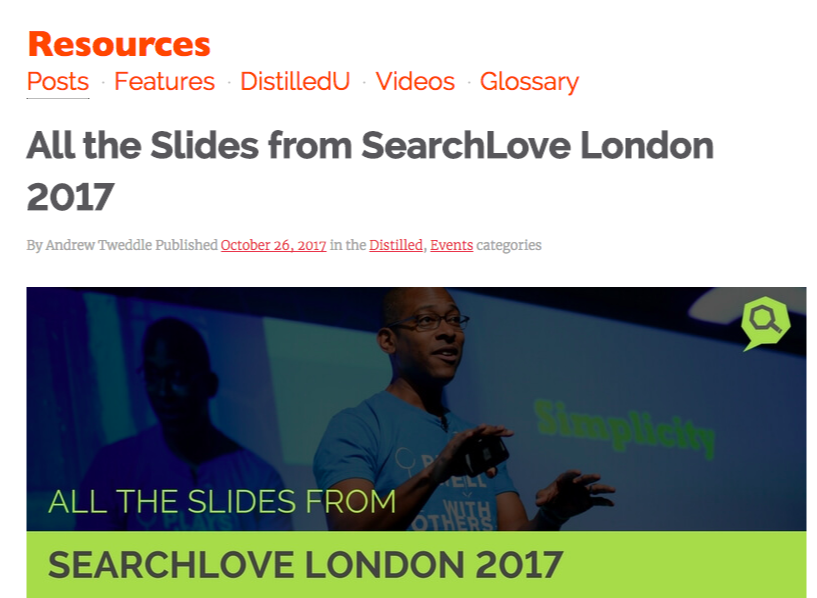

Some SEOs may just look at it as a simple marketing strategy, but it's a crafty newsjacking idea to list visuals that often have high demands for consumption.
How many people have asked speakers this question, "will you upload your slide presentation online?".
There are many of them - attendees who are always looking for speakers' decks.
And if they've found the organizer's blog that puts up a page for those resources, would they not be willing to share or link to it?
The essential here is that you have to be the organizer yourself and be able to publish slides first among every other else (because speakers tend to publish theirs on their own blogs as well).
Besides creating a page dedicated to those slides, uploading those pieces to your Slideshare account to get more organic visibility (as they have chances to rank for long-tail industry keywords) is also important.
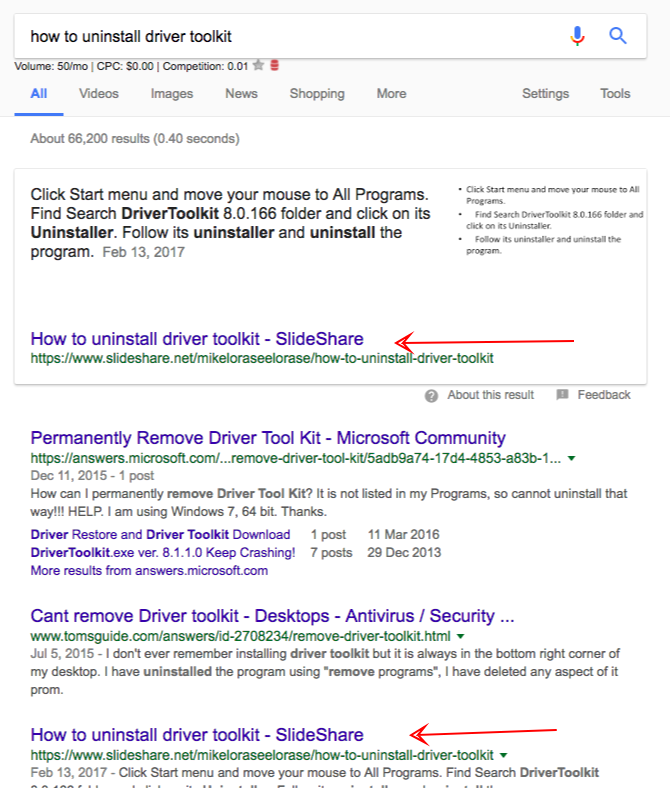

Imagine if there are 3 to 5 slides (just you curating it) that have earned links from blogs in your industry. It's 5 or 10 links acquired with just a simple method!
Just reaching out to them and reclaiming those links, asking if they can credit you as the source of those visual assets.
6. Track Mentions of Flickr Account
Flickr may be an old platform for people uploading photos online. But it can still be a gateway for links in respective industries where images are heavy-indexed, like travel, lifestyle, and home improvement.
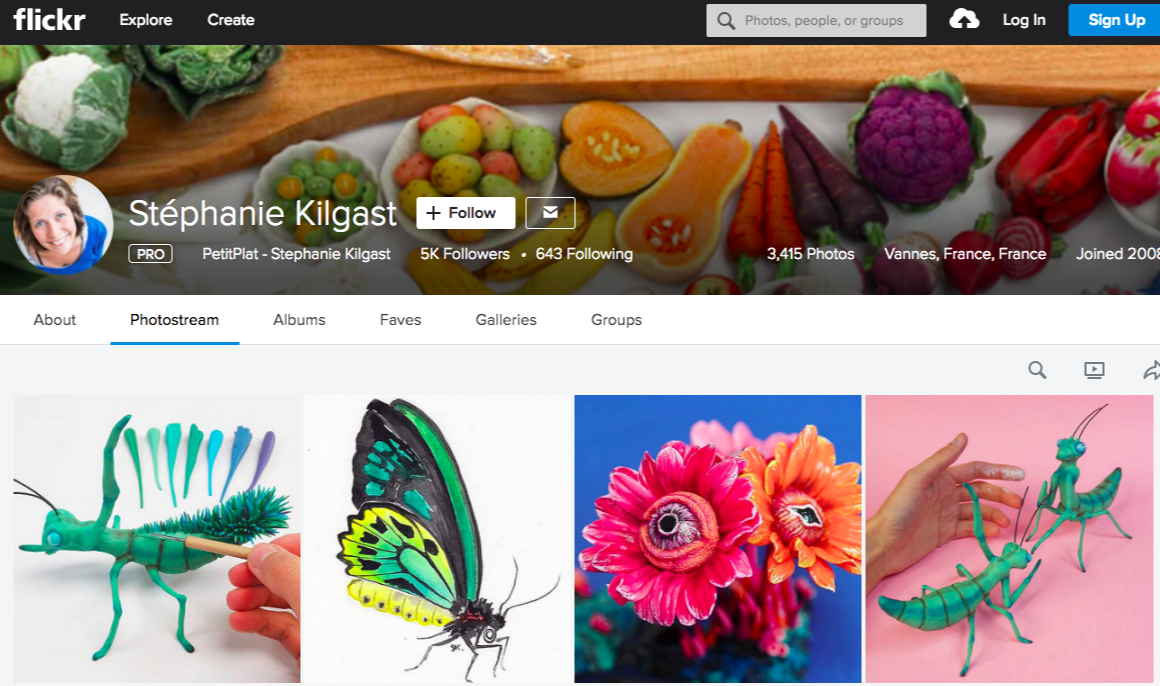

Flickr profiles with customized photos get links from time to time - and if you've got one, find out who used your images.
You email the contact person and ask if it is possible not to link to your Flickr profile but to your direct website.
There are strong signs of linking, such as links that have via [Name] or Photo captured by [Name] below the embedded slide deck.
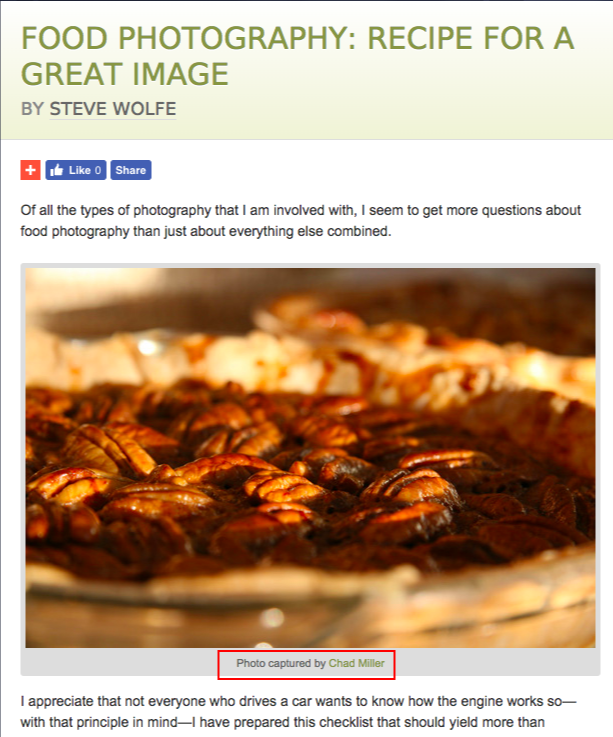

You can insert lines in your email that say, You may provide a source of link in your caption text (via domain.com).
If you got it right, that's a few homepage links you'll never easily get from other link building strategies.
7. Ranking Opportunities with Visual Content Using Pinterest
When ranking your website in Google, it's imperative to find low-hanging keywords you can easily rank without much due diligence in promotion, especially if you're a relatively new website.
Those keywords are goldmine opportunities that may only require you to put content that is only 2x better than other pages in search results.
And be mindful that you don't have to create 10x content just to rank. With an average DA of your domain, it's possible to steal that easy organic traffic.
One brilliant tip to find those visual ranking opportunities (h/t to @dan_shure) is using Pinterest.
Pinterest pages rank for keywords you may haven't thought are relevant to your industry. Some keyphrases even have high link intent, which gives you enough confidence for manual outreach.
How to start this content creation approach?
Put Pinterest into semrush.com. (I prefer SEMRush over Ahrefs when filtering millions of organic keywords straight on the platform without exporting CSV files).


Your next step is to filter keywords by your topic + "ideas" or "images".


Then filter again with keyword difficulty.
Do this method every month to find newly suggested or searched keywords, and you'll have endless visual keyword opportunities you can rank content with.
For example, the "backyard fence ideas" keyword has Pinterest pages with good link intent (20+ average linking root domains).
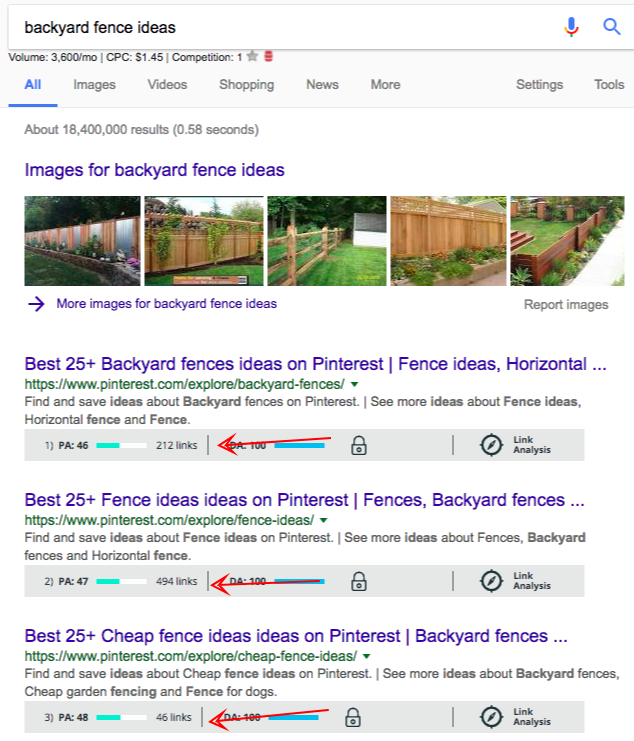

That keyword opportunity alike, given in your respective industry, is something you can grab and create 2x content with it, which passively helps you earn links when you rank.
8. Reverse Engineer Image Site Backlinks
For some of you who don't know, image links point to your site not with an anchor text but with an image.
Image links are acquired from different approaches. Here are some common examples:
Image directories
Loyalty cards
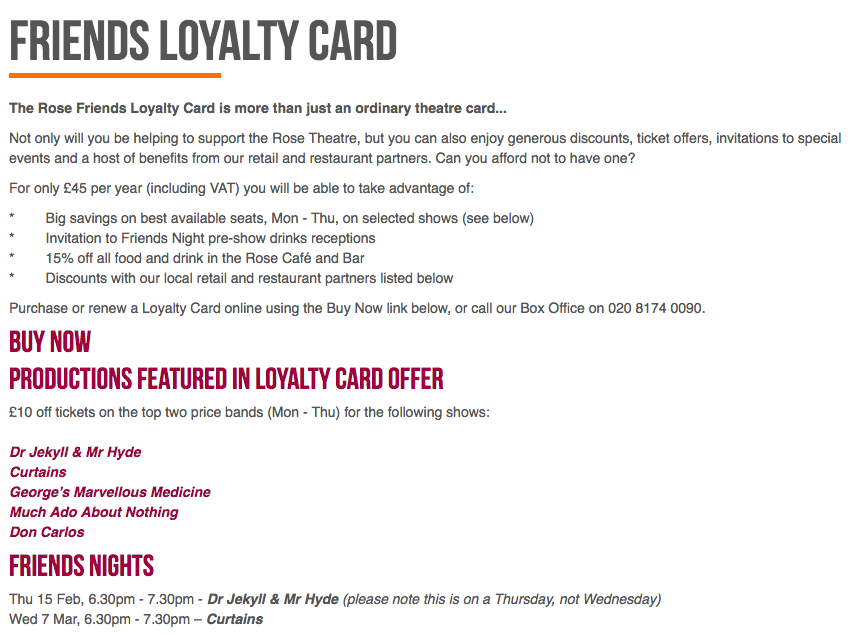

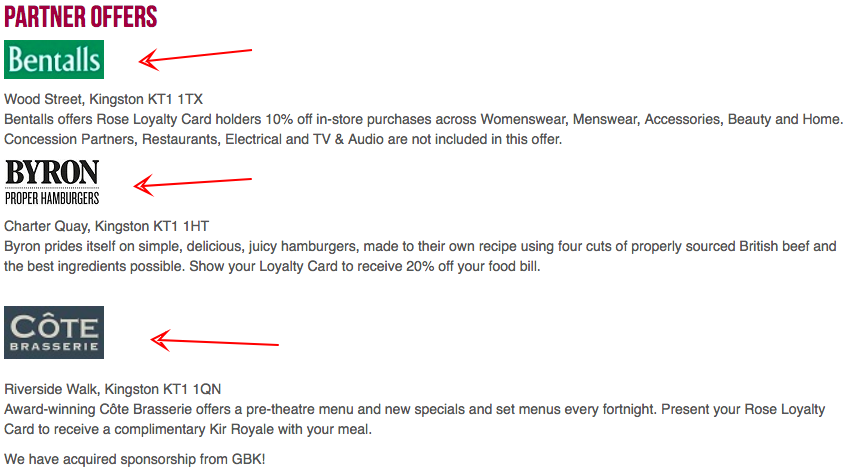

Partnerships or Sponsors
Professional Organization Links
As you can see, these are legitimate links mostly executed from a traditional partnership perspective, i.e. the case with a professional organization. You join a partner group, and they give you a link from their partners/association page.
Usually, these links are hard to get by just doing outreach and requesting a link.
You don't do that. for sure. These are gold mines. You think and plan how to acquire the link properly.
But with a good approach, and if your brand permits you to sponsor/partner/join or even create a loyalty card for customers, it's not only a branding opportunity. But along the way, you can create image links.
How did it start?
Put up a competitor's domain to a link prospecting tool.


Go to its Backlinks profile and export a backlink report (CSV).
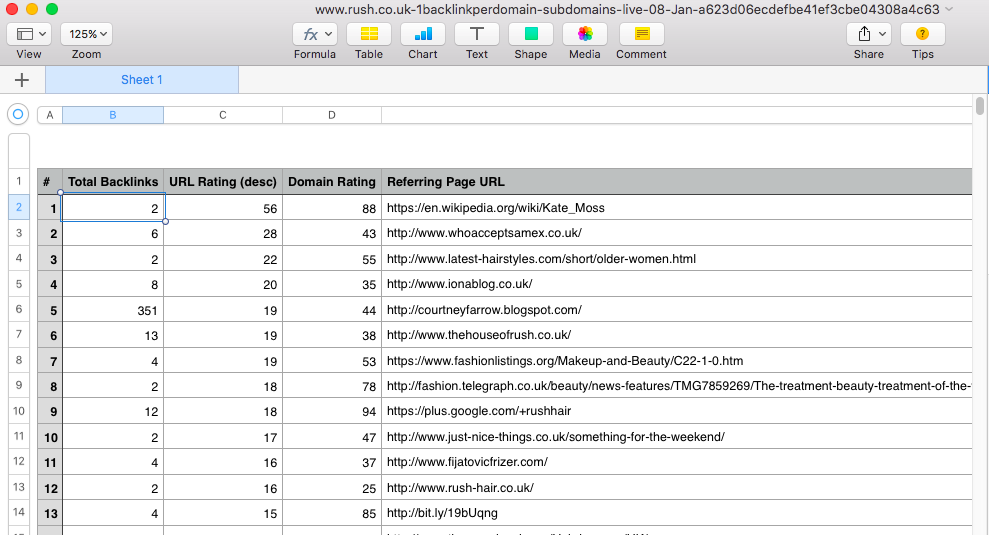

Filter the list with words containing "Image" only to find image links, either do-follow or un-follow.
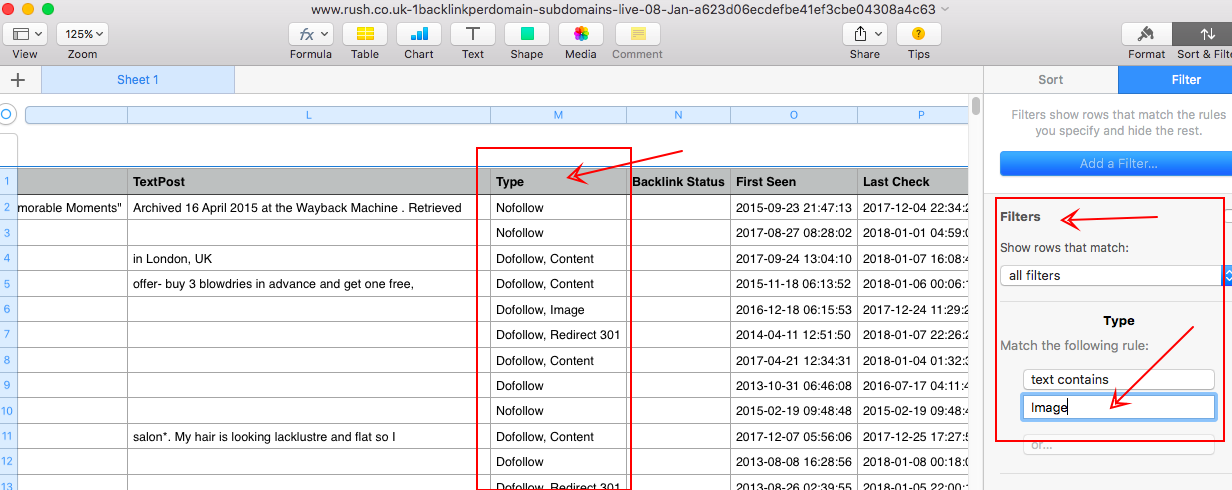

Search through potential link opportunities. Understand how your competitor acquired links. Some may take manual outreach. Others may take weeks to partner for a program. But there are a few that only require creating a profile and uploading images, just like this one.
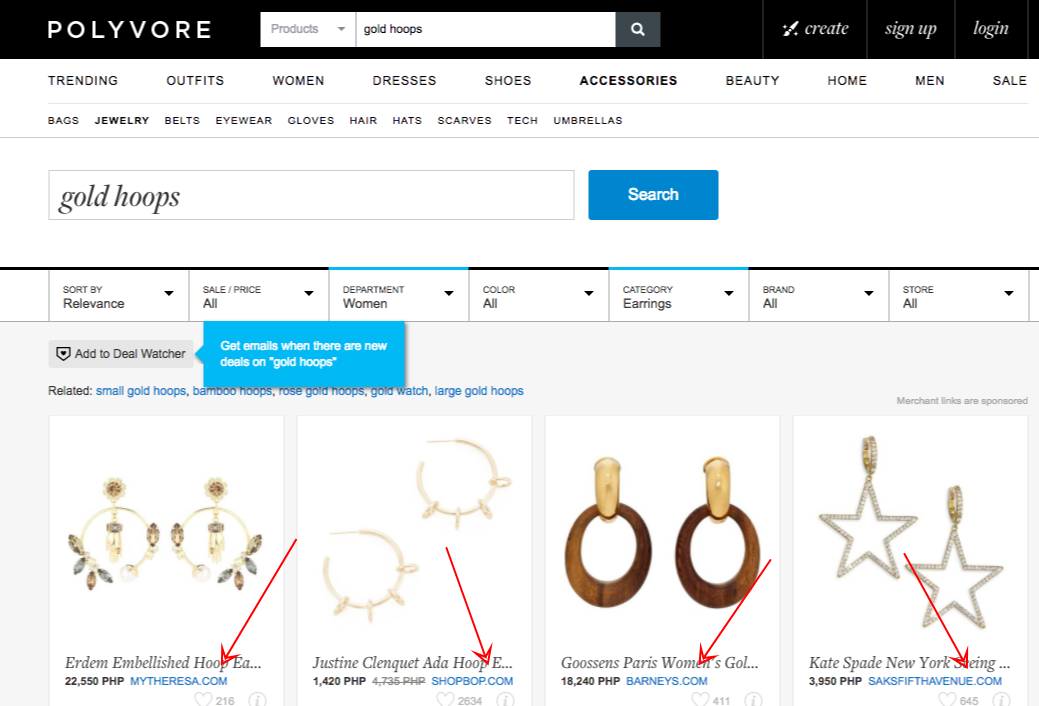
9. Image Share With Other Websites
Honestly, not all image link building tactics can best fit your website.
But if there's one tip that is very simple to do to build links through images, you approach publishers and give them permission to use any of your visuals.
By giving them permission, you provide value upfront that sets you apart from other link pitches that say, "give me a link".
Jason Acidre established a solid image link building strategy of creating a private gallery/library of images and cinema graphs and offering it to bloggers in exchange for links.


With more bloggers caring more about the design of their content, they'll likely perceive your pitch as highly valuable, especially if it's given to them intentionally and for free.
If you don’t have the time or inclination to do them, you should probably find someone who can. Learn more about our link building services.
Image Link Building Frequently Asked Questions
How do I make an image a link somewhere?
To make an image clickable and turn it into a link, you can add the <img> tag within an <a> tag. This HTML code works on WordPress too, just use the text view option in the page editor. Give your image a link by nesting the <img> tag inside the <a> tag.
What are image backlinks?
Image backlinks are links to websites, pages, or profiles embedded in images. These backlinks help improve a website's visibility and authority, as search engines consider them signals of relevance and trust. Including image backlinks in your SEO strategy can enhance your website's ranking and attract more organic traffic. Ensure your images are properly optimized and relevant to the linked content to maximize their SEO value.
Does link building still work?
Yes, link building is still effective for improving SEO rankings today. However, it is important to focus on quality links rather than quantity. Building high-quality, relevant backlinks from authoritative websites can greatly enhance your website's visibility and organic traffic.
Content Gap Analysis: Three Uncommon Ways to Fill The Gap
What is content gap analysis?
Content gap analysis is strategically understanding the needs of a targeted audience by looking at untapped content opportunities on competitors' website, in industry's content as a whole, and in several micro-niche communities.
There are many benefits to initiating a content gap analysis in your content marketing campaign. Let me give a few.
- Examine overlaps in your content topics with your competitors
- Discover new content opportunities your direct competitors haven't grabbed yet (where you can fill in the gap)
- Identify content formats your unique industry majorly consumes
In the latest post of Rand Fishkin at Sparktoro, he examines the current blogosphere and if there's still room for companies and other entities to leverage blogging in their online marketing strategy.
Regarding visibility, content formatting, and authority, not all brands can benefit much from blogging. Out of thousands of people who blog, a few only exist and do well.
Understanding that reality allows you to seek out topical opportunities driven by demands (needs) but with less content supply.
To start with content gap analysis, you can execute the most conventional approach: finding content gaps by plugging in competitors' domains in a content marketing tool.
With Ahrefs' Content Gap feature, you can discover keywords your competitors have ranked for but your brand hasn't yet targeted.
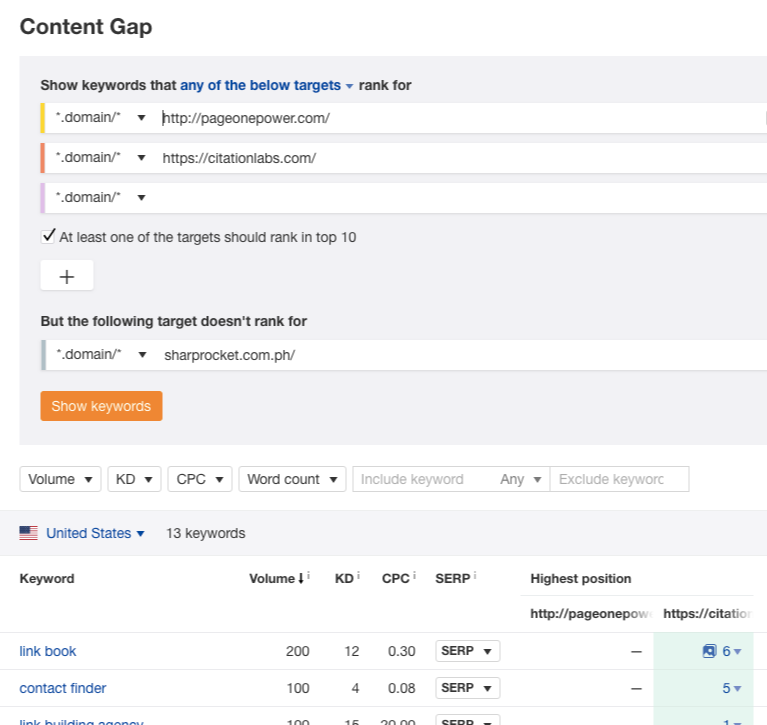

To get the most out of the results, it is best to include websites you're directly competing with from the highest relevance level. Go very specific with your competitor targeting.
Filter down keywords based on keyword difficulty level, search volume, and relevance. Create content assets that best suit your content marketing resources.
This is the most common way of doing content gap analysis, but there are three more methodologies I'd like to cover in this post.
How to Do Content Gap Analysis
Let me start with link-based audience overlap.
Link-Based Audience Overlap
One leading indicator of a growth-wise content marketing campaign is the number of links generated to a content asset. Though it's not the primary defining value of a successful campaign, it helps create expectations from a quantity perspective.
Knowing this, you must also see if the preferred topics have a probability of driving links to a page/site.
The 601 audiences spreadsheet from Citation Labs is not only a good list of potential linkable audiences to tap into in your content but also a good assessment tool if any audiences haven't been reached by your competitors through content.
Visit their resources section, or if the blog has massive content pieces, you can use Ahrefs' Top Pages or Best By Links feature to see their most-linked pages quickly.
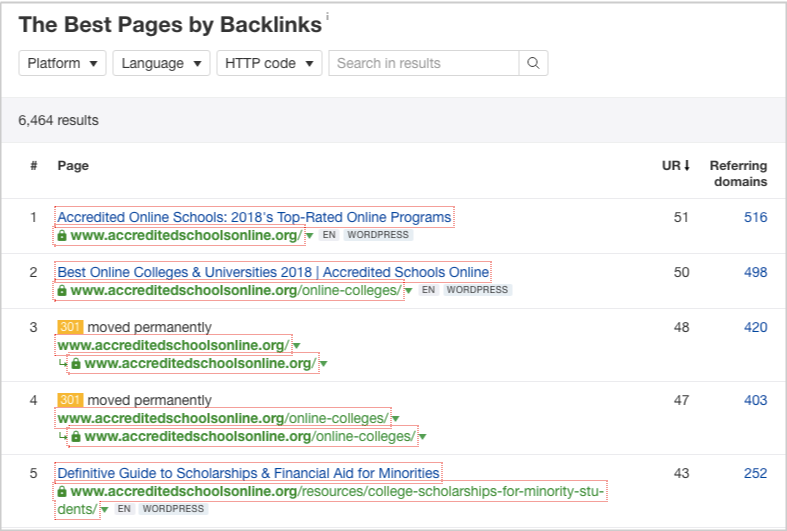

Check the 601 Audience spreadsheet alongside your competitors' resource pages. It is best to curate all resource pages of your competitors in one place so you don't have to switch to different tabs/sheets.
List down linkable audiences untargeted by your competitors. Check using any of these search queries to see if resource page link opportunities exist for that audience.
- intitle:links OR inurl:links "keyword"
- intitle:resources OR inurl:resources "keyword"
- inurl:links.html "keyword"
- inurl:links.htm "keyword"
- "links to resources" "keyword"
- "of links for" "keyword"
- intitle:”helpful links” "keyword"
- intitle:links "keyword"
- "other helpful links" "keyword"
- "links to websites" "keyword"
By considering not only keywords per se but the linkability potential of topics, you're better of hitting a good leading indicator - the highest links possibly generated for the page.
Micro-niche Communities (Gaps in the Industry)
You may find industry content gaps in platforms where your targeted people mostly engage. These include micro-niche communities where some blogs originated, given that they see a significant need for information in the market.
Subreddits are a popular example of a micro-niche community. Examples of targeted subreddits are Woodworking and StopGaming.
Given that the information is strictly on the most relevant topic, you would often find questions that are too deep and technical. Those questions will likely have a search volume that demands some content attention.
You can leverage these subreddits to pinpoint technical and niche-oriented keywords and questions by engaging in the community or plugging your subreddit into a link analysis tool.
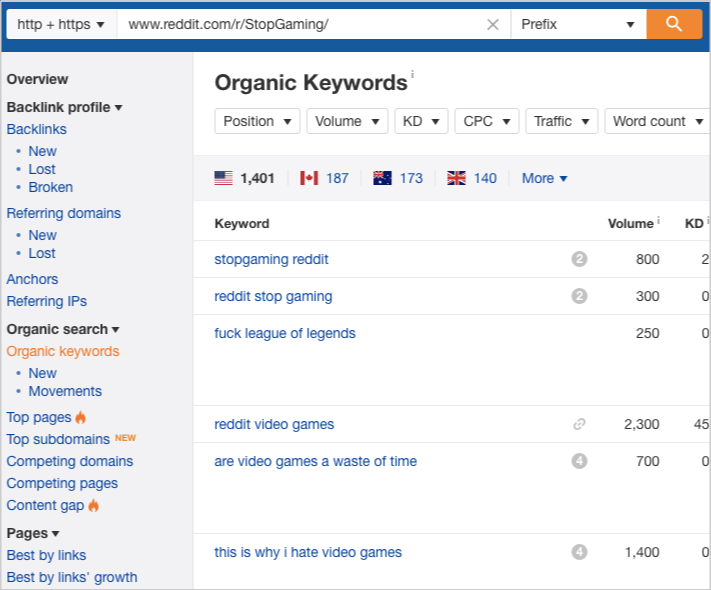

Another good approach is to create a singular page for the topic you've discovered. See if there's a gap other content creators haven't filled in yet. With the advanced search operator, "intitle:keyphrase", you can check if the topic is highly saturated with informational pieces.
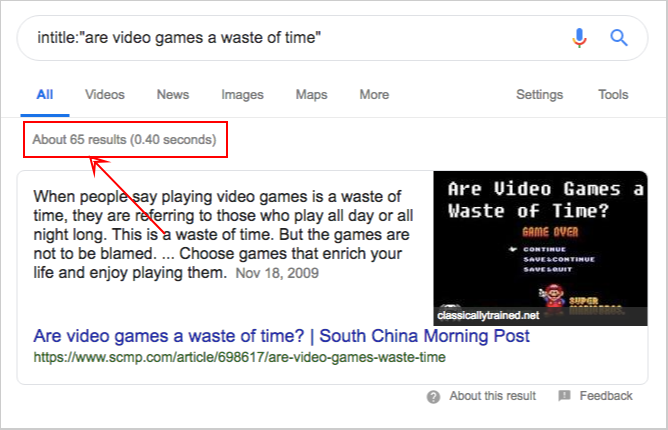

Pre-content Creation Link Jacking
One of the gaps every link-oriented content marketer has to fill is outdated content opportunities.
If a page has been linked to an outdated study, statistics, or article, it will be better off linked to a newly referenced content piece.
This may be overlooked by content creators and, more often than not, neglected by bloggers unless they do regular content audits of their websites.
It is a gap you can fill in right away.
If you have published interesting statistics, you can find earlier ones and articles with outdated statistics.
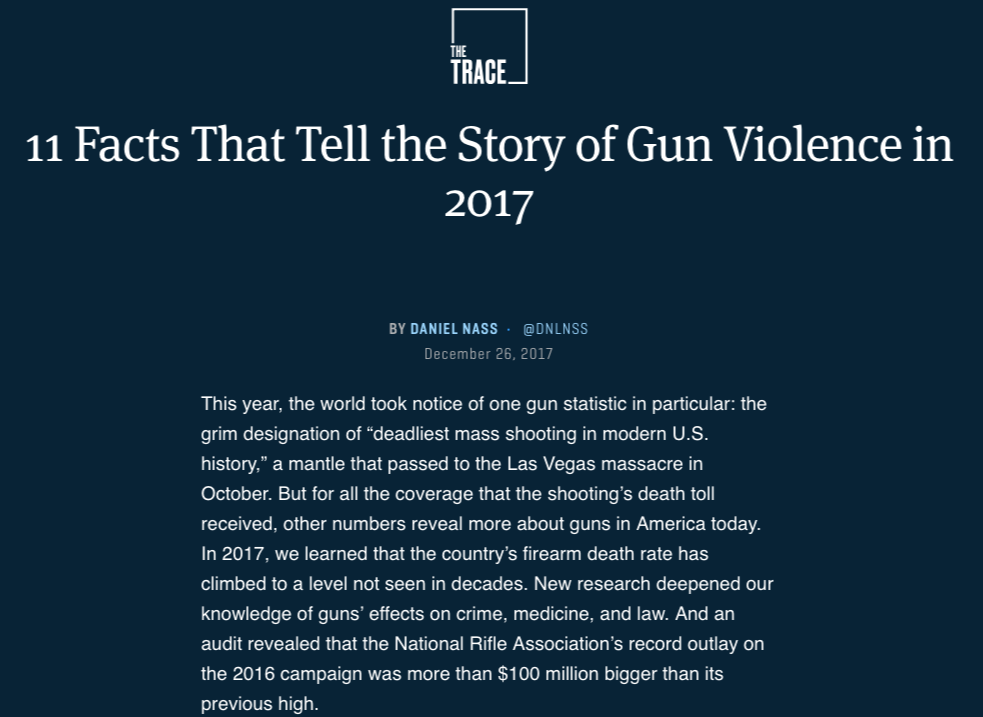

Find them and see the sites that are linked to them. Reach out to those sites and ask them to update their links to your new study.


Improving Your Content and Other Creators' Content
As soon as you update your content piece with new, relevant information and other content formats to make it comprehensive and unique for an intended audience, you'll find ways to fill in the gaps of other content creators. You meet a need in your market by providing them with new content assets to reference or by crafting content for a certain linkable audience untapped by your competitors.
Content Gap Analysis Frequently Asked Questions
What is an example of a content gap analysis?
One example of a content gap analysis is when you focus solely on creating decision-stage content without considering the other stages of your buyer's journey, resulting in a gap. This can manifest as missing content for your personas' buyer journeys or failing to cover keywords that your competitors are ranking for.
What are the three 3 fundamental components of a gap analysis?
The three essential components of a gap analysis include the current state, desired state, and the gap that exists between them. These components form the foundation for identifying areas of improvement and charting a course toward achieving organizational goals. A thorough analysis of these components helps businesses bridge the gap and improve performance.
What is the difference between keyword gap and content gap?
The main difference between keyword gap and content gap analysis is that keyword gap analysis focuses on identifying opportunities to improve overall search visibility, while content gap analysis identifies keywords you currently do not rank for. Keyword gap analysis looks at a broader scope, while content gap analysis is more specific to your existing keyword strategy and rankings.
How to Get Backlinks with Guestographics
Guestographics is publishing visual assets on external industry blogs with the hope of getting contextual links pointing to a website.
Coined by Brian Dean, the said link building strategy has been abused used in acquiring legitimate links to their sites. It's effective in industries where bloggers want to delight their audience with a new content type (visuals) or want to share data/story/message that deserves to be heard.
A lot of SEO case studies have been published about guestographics. Here's one article where a blogger used guestographics to grow his pet blog's organic traffic by 975% within 6 weeks.
To execute this link building strategy, Brian Dean shows a five-step process that you can run smoothly in your industry.
Step 1: Post an infographic on your site
Step 2: Find sites that write about your infographic’s topic
Step 3: Show them your infographic
Step 4: Offer them unique content (“the bribe”)
Step 5: Get your contextual backlinks
I recommend you read Brian's entire guide to get further details on how to execute each step above.
What is guestographics?
Guestographics, also known as infographic outreach, involve creating and sharing infographics with other websites for them to use as content. It's a visual approach to guest blogging. By leveraging the power of visual storytelling, guestographics can enhance brand exposure and generate high-quality backlinks for increased website traffic and SEO benefits.
How to do infographic outreach?
Here are four actionable tips to do infographic outreach:
- Utilize email fragments in visual content outreach.
- Leverage infographic promotion with embed boxes.
- Slice out infographics into micro visuals.
- Localize visual data
1. Utilize email fragments in visual content outreach
It's easy to copy and paste an outreach email template from an SEO blog and replicate it on your own outreach campaign. However, without knowing the principles of why it worked in the first place, it can only give you initial success.
Emails like I like your blog and found you on [insert link source] or I stumbled upon you on [source] and thought that you'll be interested in my infographic hammered many inboxes of industry bloggers and publishers. They mostly go to a spam folder and don't help get returns in email outreach.
The way to stand out in email is to use a compelling, short, and personalized subject line such as this SiegeMedia's subject line format:
[ASSET TYPE] for [WEBSITE]: [POST SUMMARY].
The reason it's effective is that publishers can easily glance at what content type you're trying to pitch to and what your asset contains by simply reading your subject line.
A one-punch line can help improve your emails' open rates.
But effective outreach doesn't stop there.
It's important to include specific details that only that website has (Ross calls it email fragments) which gives a personalized hook to your email that will make it look like a one-time sent-off email rather than a blast-off one.
To test how important email fragments are in linker outreach, I sent a bad outreach email to a high-authority industry publisher with their Website Name not correctly spelled out. Scheduled it to be sent at peak hours.
Then after an hour, I received a response from the editor.


Negative.
Five months later, I sent a similar pitch (but with the correct spelling of the website's name) to the same editor.
This time, I received a positive response wanting to publish the visual asset that we've created. They are asking for a custom intro and jpg/png version of the infographic.


That may be a lame test (just one email) but I believe there are hundreds (if not thousands) of publishers checking their email inbox and choosing which email deserves a response based on how the pitch is structured and personalized.
The more you include email fragments in your pitch, the better results you'll get.
2. Leverage infographic promotion with embed boxes.
Publishing your infographic is finishing the first half of the battle (content creation). You have to put more eyeballs to it in order to get traction and naturally earn links - that's the second half (content promotion).
As you know, people put embed boxes after infographics. This allows other bloggers to republish the exact visual asset on their own blogs without asking for permission from the original publisher.
This approach initiates the promotion of the visual asset.
Now take this step to the next level by giving a code to bloggers that'll allow them to put their own embed box on their blogs when republishing your visual asset. The publisher who then embeds the asset will also have an embed code with your details.
When bloggers look at your republished content and are interested to do the same on their own blogs, it's easy for them to republish it.
That way, it multiplies the promotion two times without having to reach out to bloggers who have read/connected with republishers.
When you pitch bloggers, you only give them an attachment of the image (png/jpg) for them to upload it on their sites. But it'd be much easier for them to publish the asset you just send them a code.
The code should contain not only the image but also an embed code after the image. The code should look like this:
Let bloggers share the opportunity of links with you in the embed code. It looks like they've partnered with you in the promotion (co-marketing) when the visual asset is republished on another blog.
Customize the code by replacing Blogger with the Brand Name of the blogger and Your Blog with Your Brand plus links back to respective sites.
It's a win-win situation. You get a link, the blogger acquires a link as well.
3. Slice out infographics into micro visuals.
I normally see long infographics that require several mouse scrolls to see the entire image. It's tiring to look at it on your screen, right?
While this denotes authority in some industries (because it's filled with a lot of data), what I've realized is that not all visitors will dare to check all the details inside the image. They only check the title and get the important facts.
One approach that you can do to not overwhelm your audience with too much content is to slice out a long infographic into two to even four micro images that won't break the entire message of the content, but rather help visitors pleasingly get each detail on a micro-level.
However, it may not be applicable to all types of infographics, such as the case with instructographics or how-to visual assets because it obviously breaks the process of how to complete/do a "thing" (e.g. how to choose a bottle of wine).
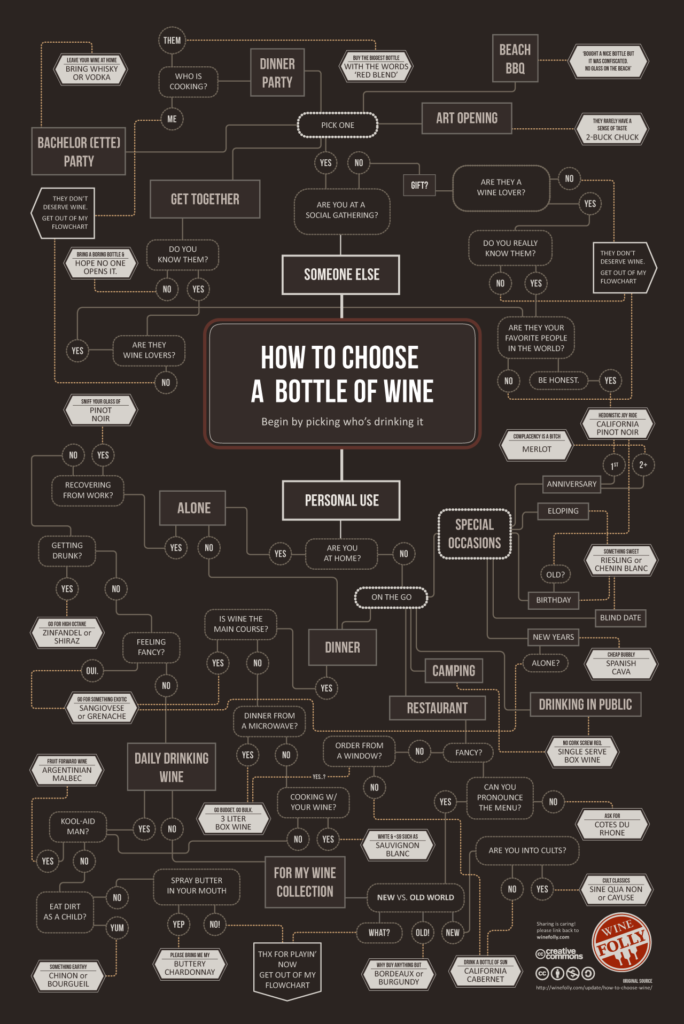

Nonetheless, there are infographics that you can break down into micro pieces, like those with five or more data points, that are contextually related but can be divided into two. For example, "How Technology in City1, City2 and City3 Impacts Teen Dating and Women Violence", you can create microimages for Teen Dating and Women Violence. This is the case when both these two main data points can stand out independently in messaging.
4. Localize visual data
Local links still play a huge role in ranking a local website for city-specific keywords.
There are a lot of link building strategies out there that help you build local backlinks, such as local sponsorships (events, local clubs, schools), local alumni, student, and employee discount programs.
I’ll let you in on a secret. There's one link building tactic that is underrated in the SEO community - that is, local infographics creation and promotion.
It's common to see an industry-specific infographic, but having both industry-specific and local-targeted visuals is rare.
Now the question is, how you can localize industry-specific visual data?
The first step is to find a local content source. You can use your company's internal data if you have one. But if you're looking for an external source, you may search for available content in public data sites below:
- https://www.data.gov/
- https://socrata.com/resources/
- https://datahub.io/
- http://data.worldbank.org/
- https://www.reddit.com/r/datasets/
Scour out these sites using local and industry keywords and see if there's a local and relevant public data source.
As an example, we've sourced out a research study about teen dating, abuse, and bullying in New York, New Jersey, and Pennsylvania by using the keyword, "bullying".


The next step is to assess the relevance and credibility of the public data piece by looking at the version history. This helps you check whether the information is updated for the current year.
Lastly, transform the public data into visual data either by hiring a freelance infographic designer or designing it yourself.
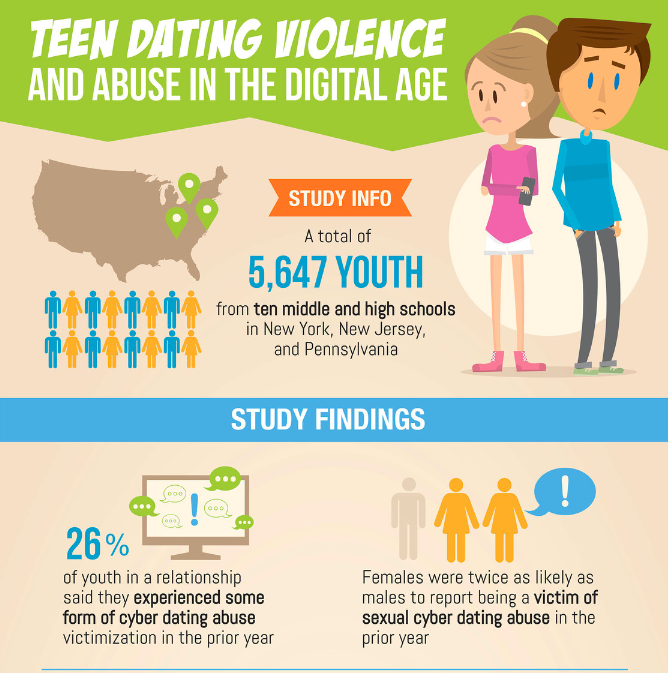

I hope this four-tips article gives you some spark in using guestographics effectively as one of your main-go link building strategies.
If you liked this post, subscribe to our newsletter and follow me on @venchito14.
Need help with your link building campaigns? Check out our link building services here.
Guestographics Frequently Asked Questions
How do I get backlinks from infographics?
To get backlinks from infographics, create visually appealing and informative infographics related to your industry. Embed the infographic on your website and allowed others to easily share it by providing an embed code. Reach out to relevant websites and bloggers in your niche, offering the infographic as valuable content they can share on their own sites while attributing credit back to your website. This approach can help generate high-quality backlinks.
What is the backlinks in SEO?
In SEO, backlinks are when one website links to another using anchor text. For example, you might find an article that references and links to another source. You can easily find examples of website backlinks all over the internet, particularly on popular blog sites that link to relevant content. Backlinks are crucial in improving search engine rankings and increasing website visibility.
What are the 7 common types of infographics?
There are 7 common types of infographics: timeline, data visualization, anatomy, process/how-to, comparison, list, and map. Incorporating the right type of infographic into your content is crucial for successful and effective content marketing. Infographics can visually communicate complex information concisely and engagingly, making them an invaluable tool for businesses and marketers.
What are the 3 types of infographics?
The three types of infographics you should use are statistical, informational, and process-based. Statistical infographics are based on data and numbers, while informational infographics use text-based information. Process infographics illustrate step-by-step processes. These types of infographics are popular and effective for conveying information visually.
What are the 7 parts of infographics?
The seven key components of an infographic include story, style, simplicity, size, stats, shareability, and sources. Our infographic provides a detailed breakdown of these essential parts and outlines a three-step process for developing a successful infographic (storyboarding, design, and promotion). It also highlights the importance of accompanying blog posts in maximizing the impact of your infographic.
What is the best free infographic maker?
Canva, Snappa, and Venngage are among the best free infographic makers in 2022. These tools offer user-friendly interfaces, a wide range of templates, and design options to create visually appealing infographics.
How to Get Backlinks in 2024 [21 New Strategies]
Looking for new ways on how to get backlinks and boost your site's Google ranking?
Great!
This post contains 21 new link building tips and strategies that are working in 2024.
Let's dive in.
How to Get Backlinks in 2024
1. Create An Image Library
When people use your images, you can ask them to credit you with links.
The more images you produce, the more links you can reclaim for your website.
How can you start with this?
First, analyze what images are linkable.
Start with any of these sources to know what images get the most links:
You want to look for images likely to be used by publications and blogs.
The reasons why bloggers would use it are very simple:
They want to show how a person behaves the way they mentioned in their articles or how things are used.
And if you can give them images that portray that, then you're hitting their needs.
It must be any of these themes:
Places:


Objects:


Events:


People:


Actions:


Emotions:


Go look for them on a photo source website by typing your niche keywords.
For example, "work from home":
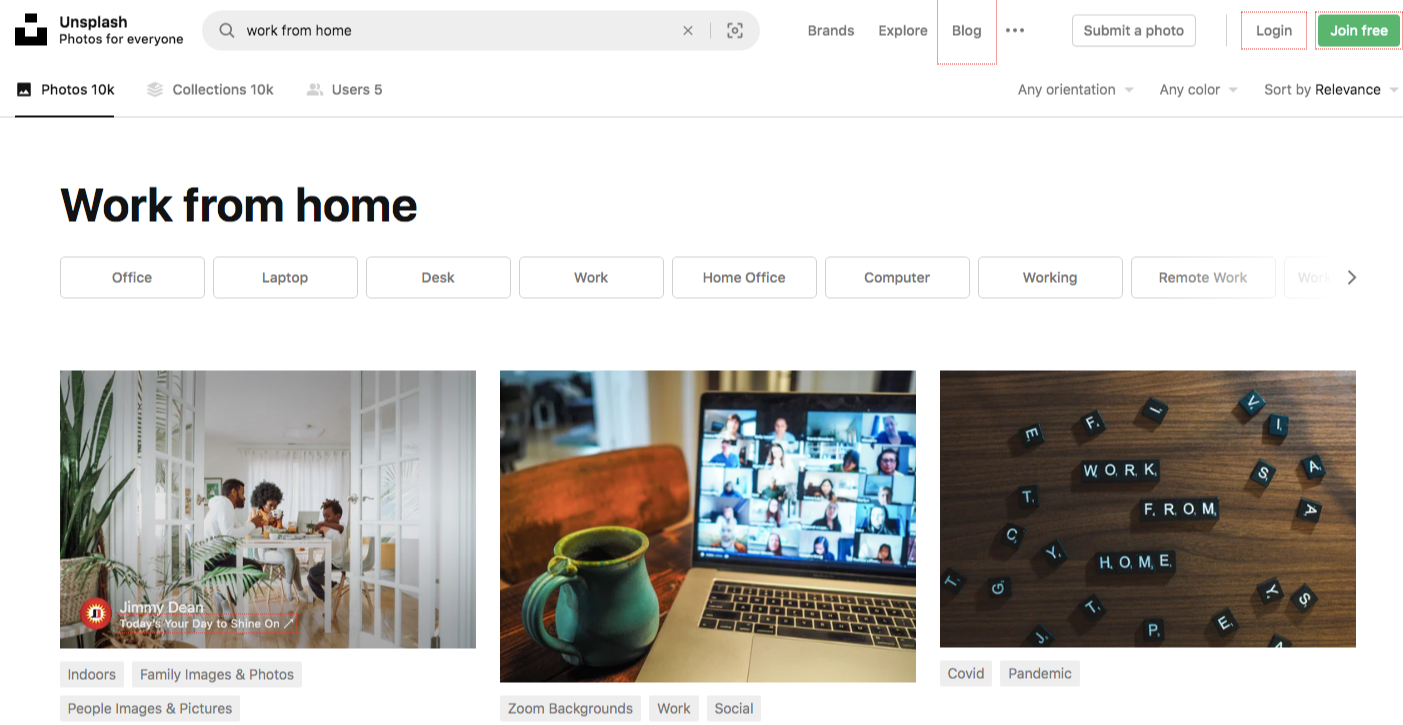

Or go to the Popular section to see what photos individuals and businesses are paying for.
Grab any image and plug it into Tineye to see how many sites have used it.
Once you analyze what images are often used by bloggers and publishers, go to your blog and publish an image library.
Create an image library that you can license under "creative commons distribute".
Get these images uploaded on Flickr and other websites mentioned above.
What you input in Flickr as a title and description will be your page title and meta description box.
Make sure you add your attribution request in your description.
Start with 30 images.
Then as you get results, add 5 to 10 more each month.
Monitor who uses your images using Tineye Reverse Image Search.
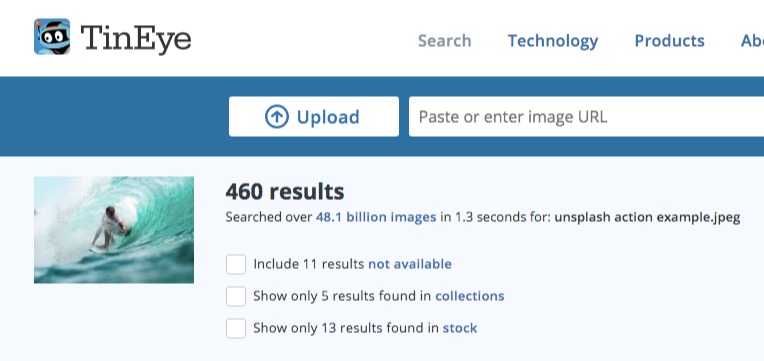

Or using Copytrack.
Or Picmatch.
Spot use of your images without links.
Reach out to them and ask for attribution.
Another effective strategy is this:
If you have a big library of images, maximize it to the fullest.
How?
Besides uploading these photos on photo-sourcing sites:
You can offer it exclusively to publishers.
Here is an email outreach template that you can use:
Subject Line: Save [Website]'s time and money on images you use
Hi [Name],
For [Website]'s editorial team, a crucial part of work is to find images, relevant to the content.
What do you think of an alternative source of images in the form of a free subscription to more than [number of] images: [link to your page]?
We can give you [number of] images per month for a [X]-month period (with a possibility of extension). In return, we would like you to credit our images with clickable links.
Please let me know what do you think of our offer.
Thanks,
[Your Name]
2. Apply 'Linkedin Reclamation' Technique
One of the easiest types of backlinks you can get is:
From people who mentioned you on their sites but without attribution of links.
Well, you can simply reach out to them and ask to get credited with links.
And you're probably familiar with this technique:
The good thing is you can do it with any type of page you own.
Including your Linkedin page.
If you have someone in your organization who is getting attention from the press, either they are an authority on a technical topic.
Sharing tips, quotes, or any value-added advice to the community.
Or because they have a remarkable story worth sharing.
Do a quick backlink check on their Linkedin profile page.
Find some potential link opportunities in there.
Reach out to blogs and ask them to link to their profile page on your website.
If you don't have a dedicated page for that person, create one for this strategy.
Then, get links.
3. Initiate Reciprocal Linking
You're probably familiar with link exchange.
That's the activity of two websites linking to each other web pages.
The SEO community has a heavy discussion about whether link exchange is good or bad.
But think about it:
Two websites can link to each other reciprocally without even the intention of manipulating search result rankings.
For example:
If I'm a product manufacturer and you're a reseller, would it be logical to link to your page because I want my potential customers to know where they can purchase the product?
Or vice versa.
Another example:
Two niche bloggers were attending a conference. They grabbed some coffee and talked.


They are in different niches. But happen to find each other's new articles useful for their readers.
One linked to his friend’s blog post. And vice versa.
You see:
These two examples are natural reciprocal linking.
Link exchange is okay.
As long as it is done in a manageable manner.
Not scalable. But if initiated for targeted people you've built relationships with, then it becomes more effective.
4. Use "Bank For Buck" Guest Posting Strategy
Not all guest posting campaigns are effective.
Why?
When people send guest posting ideas, they come from the lines of:
"Here are my guest posting ideas. Choose one that fits your blog."
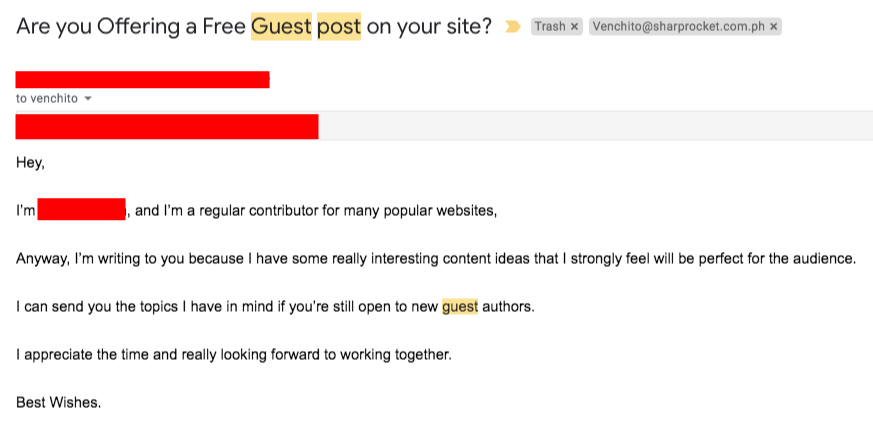

Or:
"topics I'm thinking about and hoping to include a link in your article pointing to my website"
It is a one-sided benefit on the part of the guest blogger.
Sad truth:
But this is why a guest posting campaign doesn't work for many businesses.
So how can you stand out among them?
Instead of thinking about just “links”, why not ask these questions:
What do they want?
What do they care about?
Some answers you can arrive at may be:
They want to rank for their target keywords to get new blog readers.
They want to monetize their blogs.
And so, if all these benefit your target publication, you want a new level of guest posting strategy.
Insert:
"Bank For Buck" strategy.
It's a guest posting strategy that is simple to apply.
The idea is:
You submit guest posting topics that your target guest publication/blog would benefit from:
Either because they can monetize from it.
Or they can potentially gain new search visitors by ranking your content for target keywords.
Now:
Here's how you can do it.
The first is to find affiliate programs in your industry.
And the reason is:
These affiliate programs may help your target niche bloggers earn a commission whenever someone clicks on their affiliate links and buy the products they're selling.
It’s a win for them!
How can you find these affiliate programs?
You can do a Google search for "[INDUSTRY] affiliate programme" OR "[INDUSTRY] affiliate program".
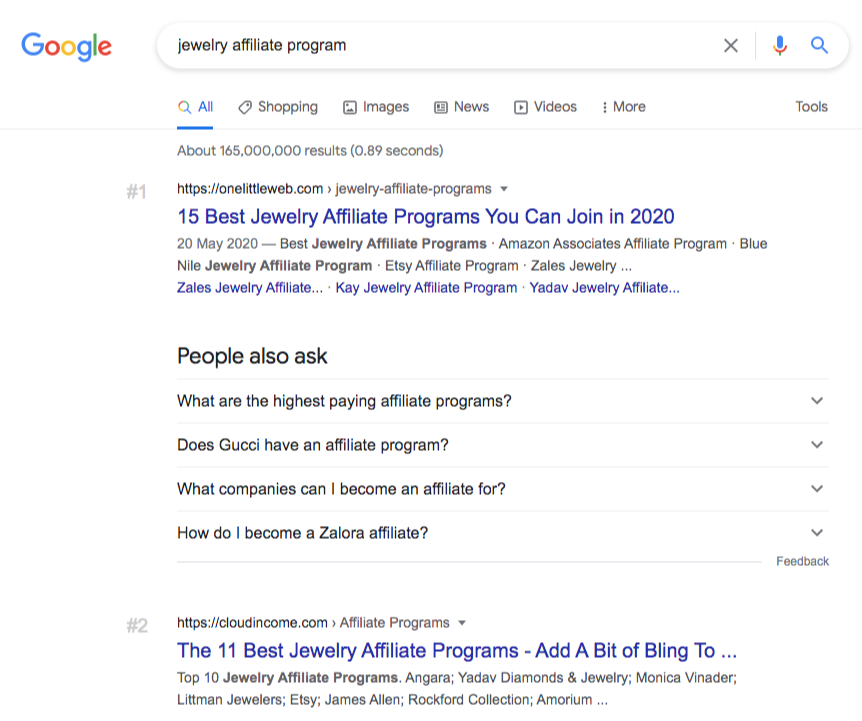

Here you'll see different brands looking for affiliate partners.
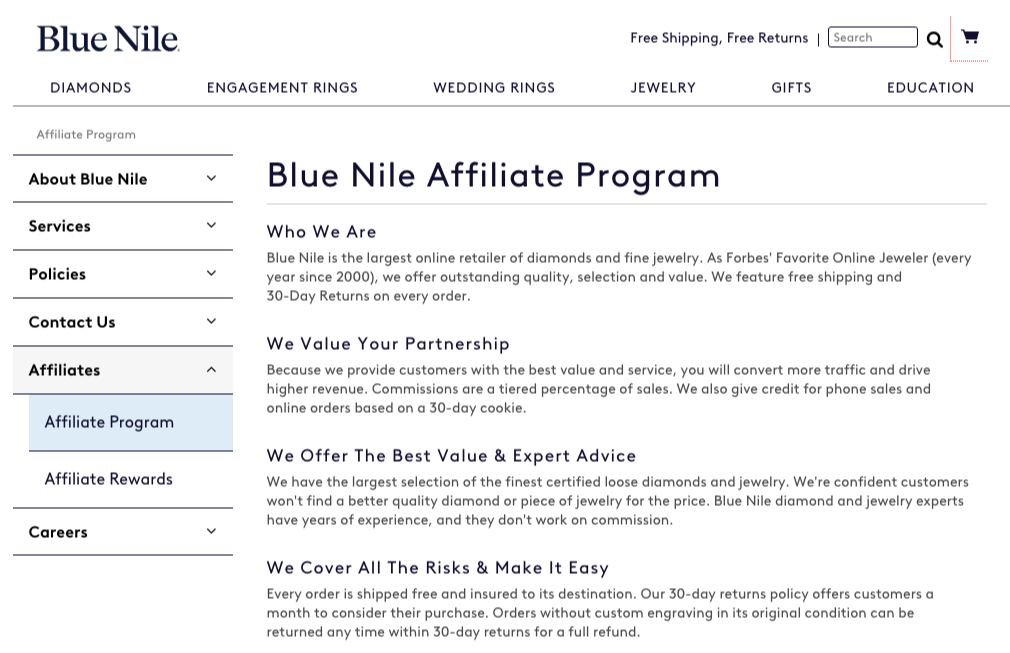

Make a list of these affiliate programs.
Next step:
Look for bloggers who are likely to participate in the program.
And the easy way is to find people who've done it before.
These are bloggers who've written product reviews.
And because they're into affiliate marketing, they will be more receptive to email pitches that would give them more affiliate commissions.
How to find them?
Use Ahrefs to check blogs linking to the affiliate programs you listed earlier.


Another way:
Look for authoritative blogs you can reach out to for guest posting.
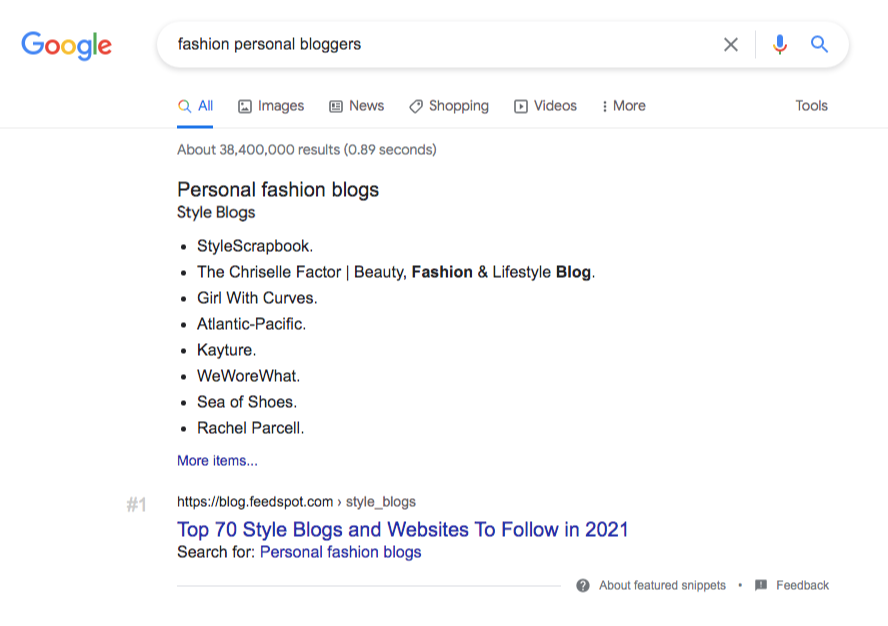

In other words, these are your prospective guest blogs.
Then the next step:
Research for their best-performing content.
And find what topics you can write for them to help them rank for some industry keywords.
You can use Ahrefs for this:
Either use Top Pages to get a good sense of their top-performing content.
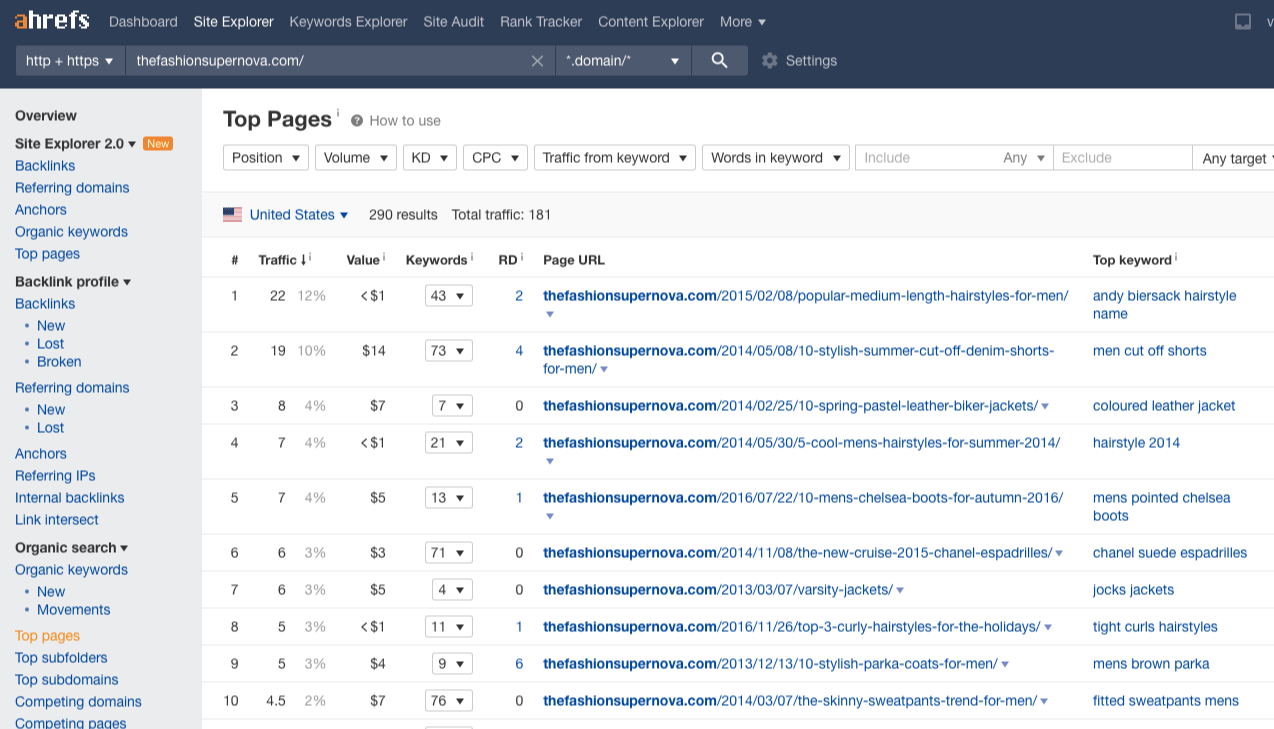

Or Content Gap Analysis to discover keywords they don't rank for yet (but their competitors are currently ranking).
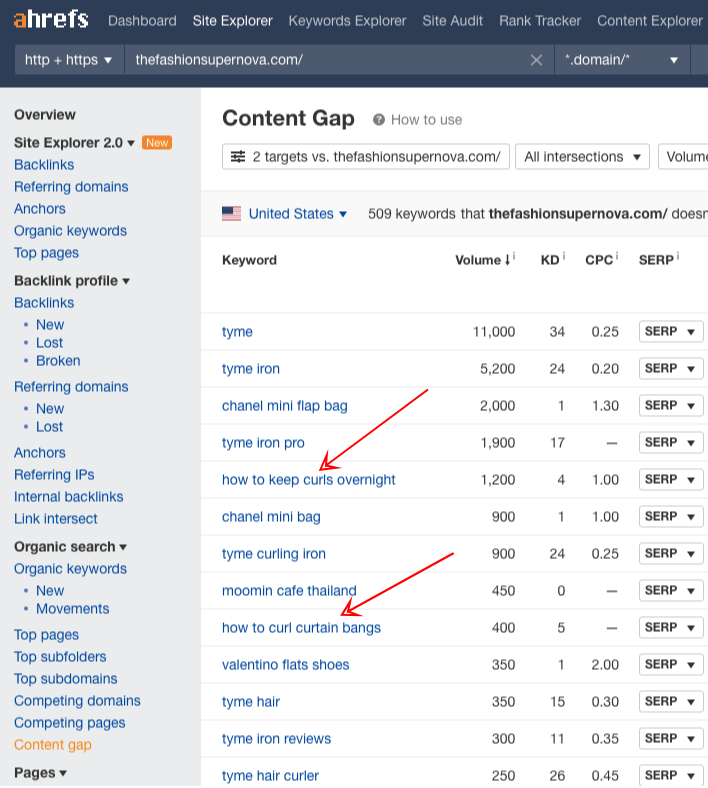

Now, as you assess, these are the topics you can suggest to write for the blog.
Two things:
You write the content and link to one of the affiliate programs you found related to their niche.
And you write the content that gets to rank for some keywords they haven't targeted yet.
So, in summary, here's how to apply the "Bank for Buck" strategy:
- Find affiliate programs in your industry.
- Look for niche bloggers who are linked to affiliate programs.
- Find authoritative blogs in your list.
- Send a list of guest posting ideas (with target keywords to rank and related affiliate programs to target).
- Write the content for them and get links to your site.
5. Get Infographics Inspiration From Visual Capitalist
It's challenging to make infographics stand out in your industry.
Not only:
Thousands (if not hundreds) of businesses publish various visual content assets daily.
But there is nothing new with most infographics.
So how can you make your infographics stand out in your industry?
The key is to model what already works.
That is to get inspiration from proven and tested infographics that have gotten links from authoritative blogs and publications.
One website producing solid visual content assets is:
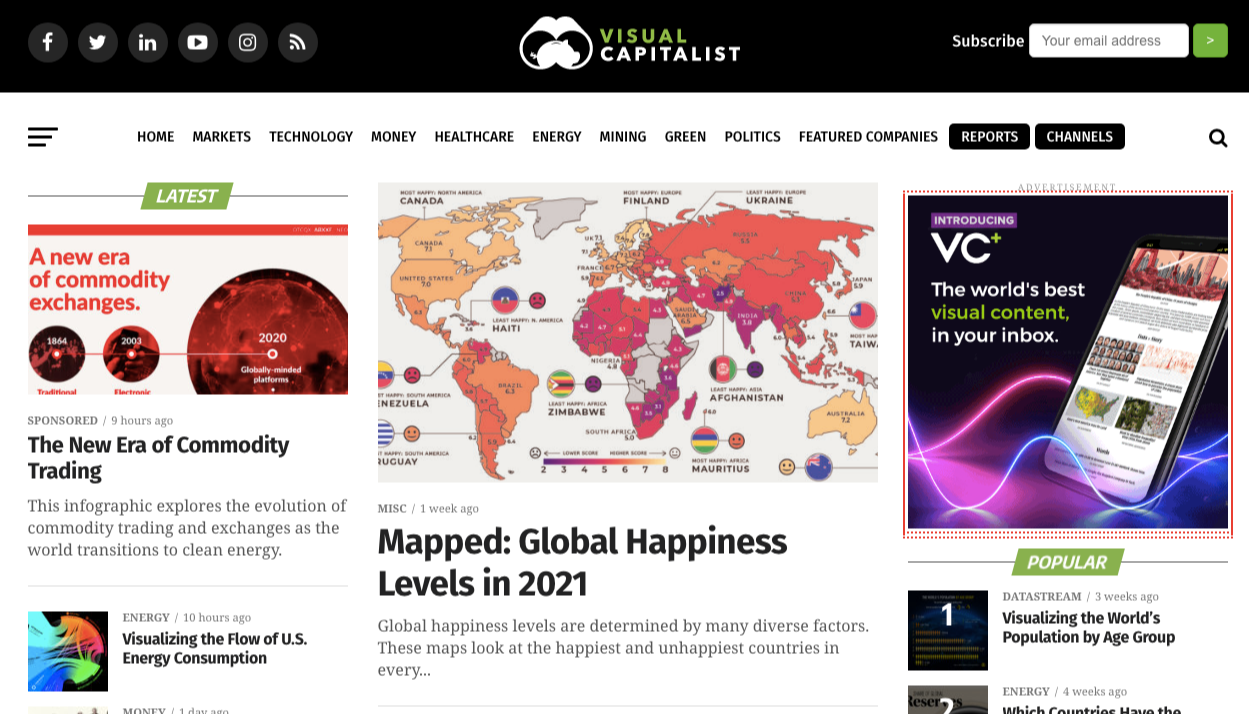

If you experience creative block when thinking of what infographics to create for your brand, check out what Visual Capitalist do.
Some examples are:
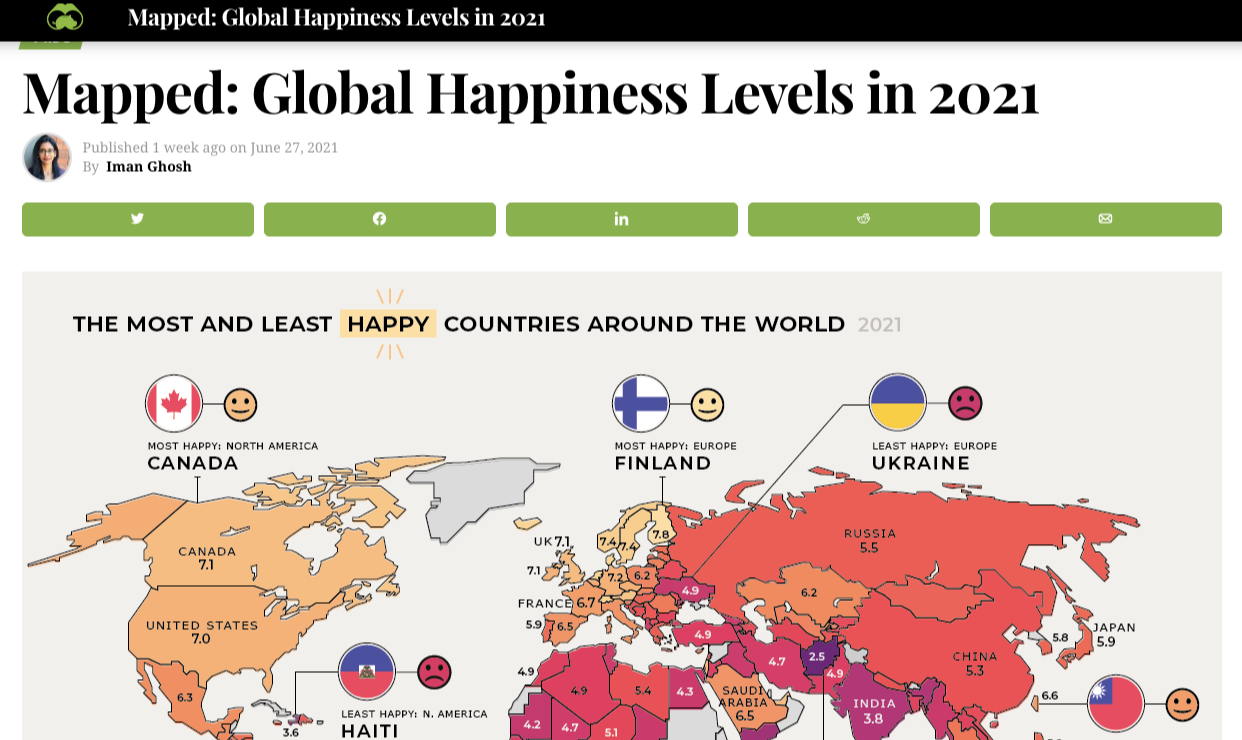

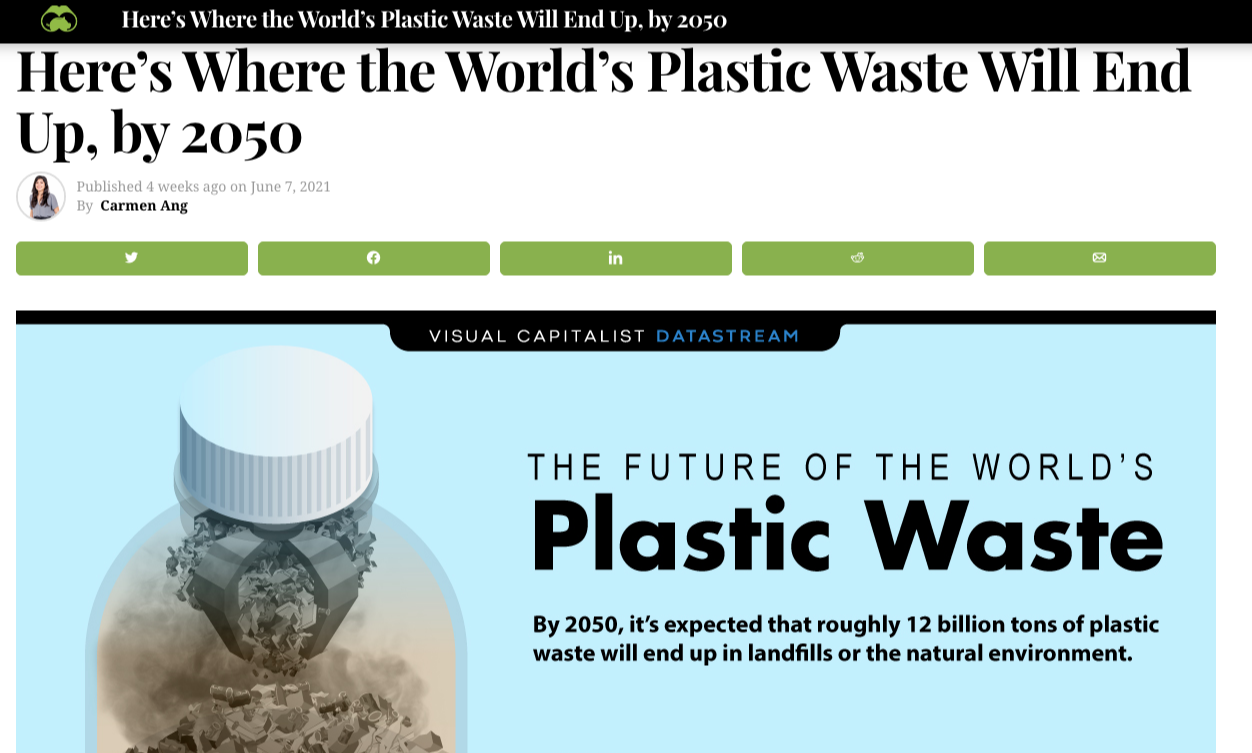

Now, you don't have to worry about where to start with infographics.
Check out our other link building strategies.
6. Use Thought Leadership For Content Collaboration
It's not that easy to create content.
But if you're working with other industry practitioners, you can produce more and higher quality content assets.
That's co-marketing.
How can you apply this?
Simple.
Find any thought leaders in your company.


And get them to be involved in your content distribution strategy.
The idea is that the more authoritative a person is in an industry, the easier it is for you to secure opportunities with online publications.
Now:
Do you have any subject matter experts in your company?
How about professors who've done any solid research at school?
The great thing here is:
You can partner with other institutions and entities where each guest posts on each other's website.
7. Apply Advanced Stats Round-up Strategy
You're probably familiar with round-up posts.
A round-up post is an article containing insider tips from industry experts on a specific topic.
Most content marketers abused this technique.
And it affects how the marketing industry perceives the value of a round-up post.
The thing is:
Round-up posts still work.
But instead of just asking thought leaders to share their "most actionable tip", you can go deep with data.
For example:
You can survey at least 30 people.
Or try to get statistics about the topic.
Let's say you're targeting business owners.
You can research on:
"Percentage of business owners who would create the same business (industry) VS other business owners who prefer to venture into a different niche"
"The average number of employees, team size, or revenue VS the years in business"
These are just some examples.
The thing is:
Statistics are referential topics.
Publishers, bloggers, and content creators often link to statistics to validate their points and make their content more comprehensive than others.
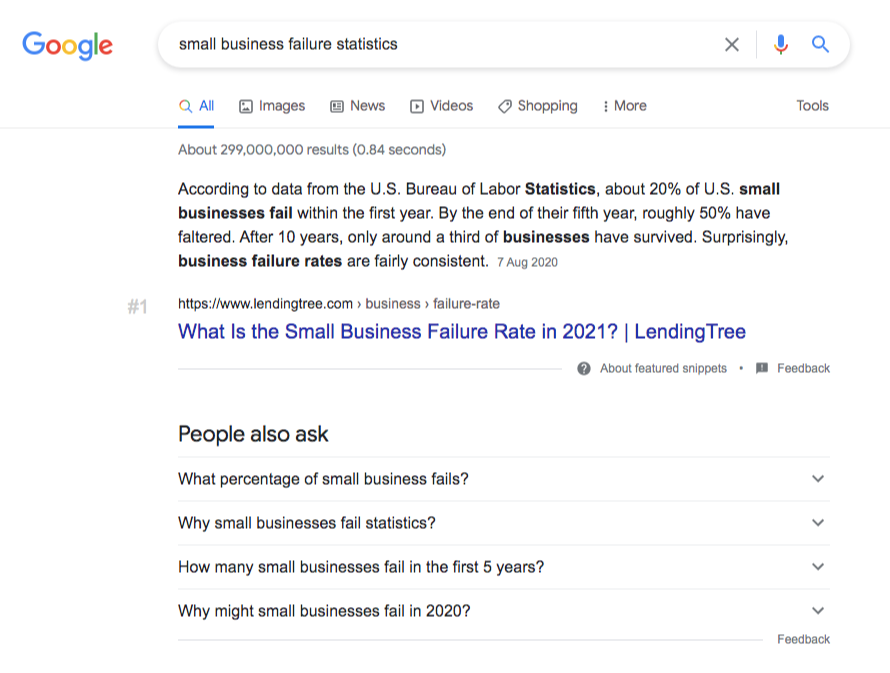

This means you have a high chance of getting links when you rank for target keywords (e.g. "small business owners statistics").
So do not just publish a 'best tips' round-up article. Go beyond that.
8. Do "Reduce, Re-use & Recycle" For Links
You can do wonders out of garbage.
if you know how to recycle properly…
What if recycling is also applicable for link building on your site?
How?
With old, seemingly useless content, you can create an entire content distribution program without even creating new content.
What are the steps?
First, find old content that you can prune.
These are pages that bring heaviness to your website (in terms of wordcount), but don't gain or contain any of the following:
Not generating backlinks (0 referring domains).
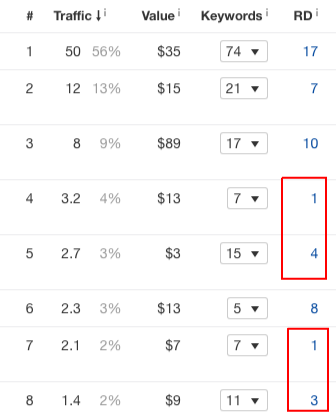

Receiving <100 organic visits per month (lower relative to your site's overall search traffic).
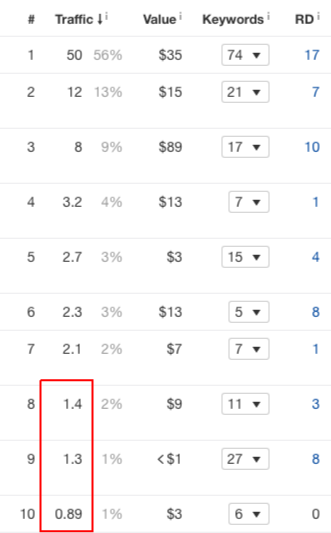

Not related to your blog's overall topic theme.
The next thing you'll do is:
Offer the content as guest posts to third-party industry publications.
Or you can rewrite the content first to fit the blog's content guidelines.
Then submit it once you see "green signals" from blog editors.
While doing this strategy, you'll find that not all your pruned content is worth submitting as guest posts…
And that's okay.
If there's a huge volume of well-written content, those are good articles still relevant for other sites.
The last step is to serve 410 response codes on the old URLs.
Or no-index via Search Console for those articles to no longer be indexed.
So if you have a hard time creating content for link building, recycle what you already have by turning old content into guest posts.
9. Reverse Engineer Author Footprints Of Competitors
You know, competitor research.
Finding patterns, behaviors, and people connected to your competitors.
In link building, it understands who is linked to your competitors.
Why did they link to their sites...
And what specific patterns you can model for your own site.
If you know competitors, who are heavily involved in link building with authors or bio names.
One link building technique you can do is:
Crawl their domain in a link building analysis tool like Ahrefs.
Outgoing links - Anchors
Scan through anchors and check names. Some of which are contributors to the publications.
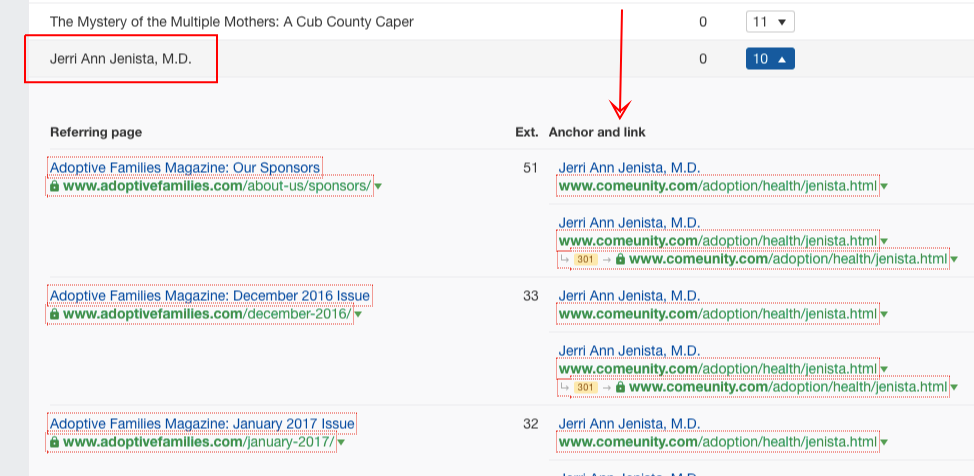

Locate the websites and social media profiles of those authors.
Collaborate.
Either:
Offer content partnerships (pay-per-content partnership).
Where they'll create the content and submit it to an industry publication.
And because they are already contributors to these industry blogs, it would be easy for them to publish the content.
10. Approach eCommerce or Shopping Editors
Ecommerce link building isn't that easy.
Webmasters must have a good reason to link to your product pages.
Many reasons, but one is:
Niche bloggers write "The best gifts for X" articles.
And if your product is relevant to their topics, you can get direct links to your product/category pages.
Besides bloggers:
You can also reach out to Shopping editors.
These are news writers, content creators, and editors from top eCommerce publications.
Let me give you a few names.
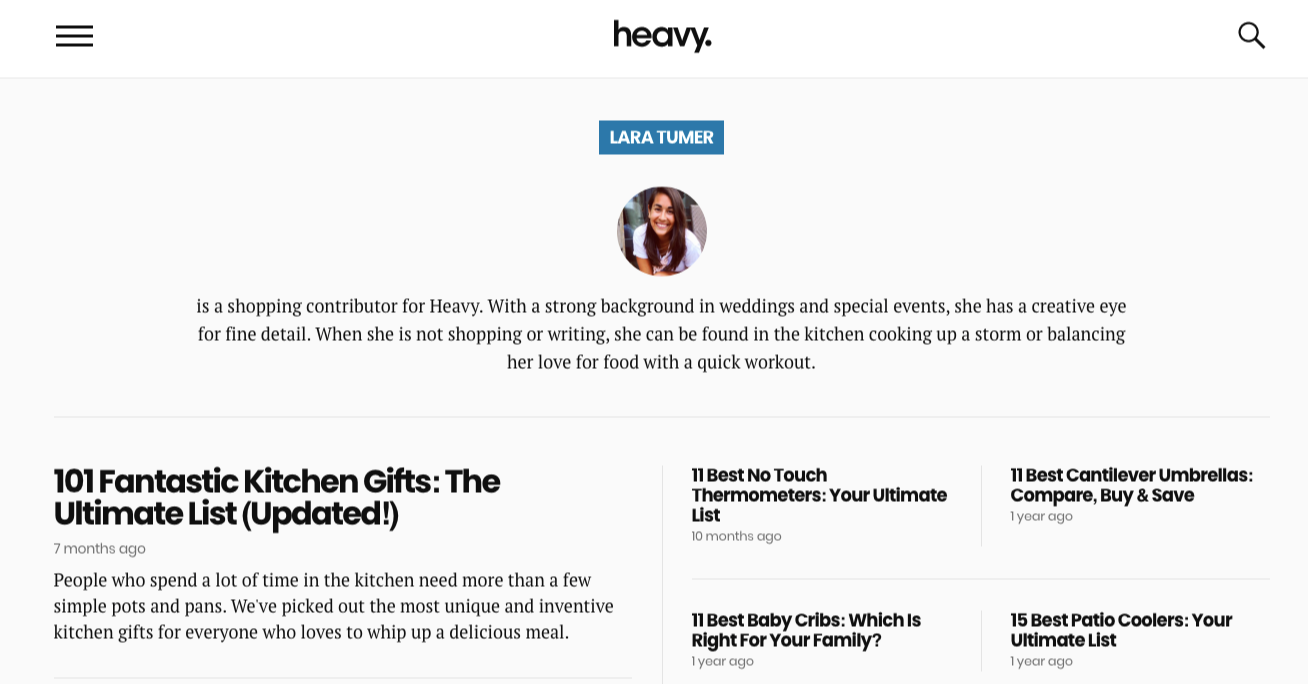

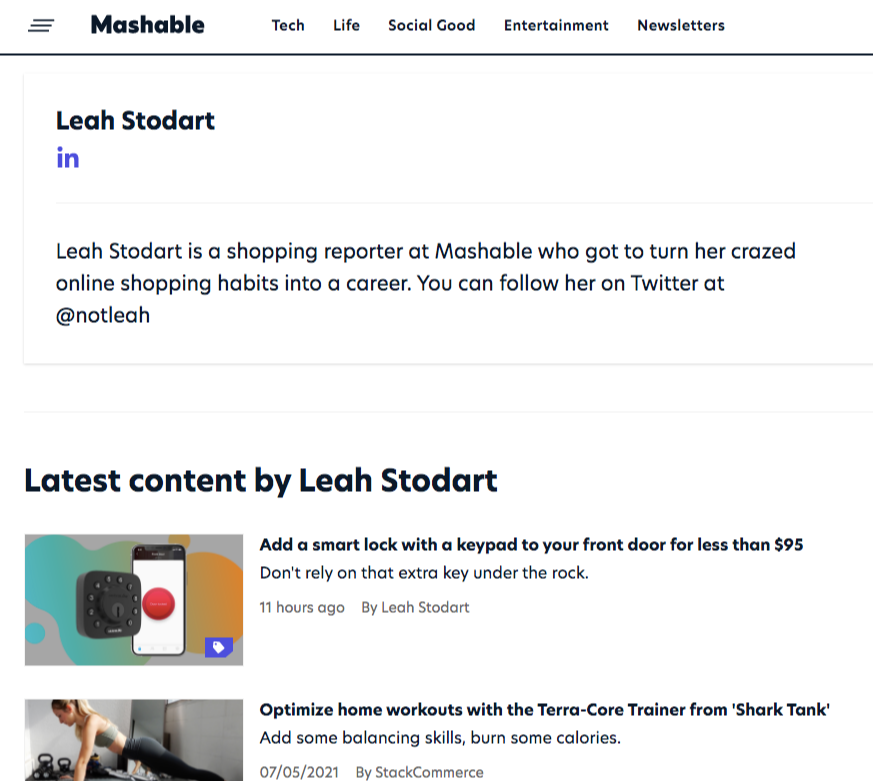

Then go from here. Prospect for more opportunities by discovering other publications that they're writing for.
Through Google search.
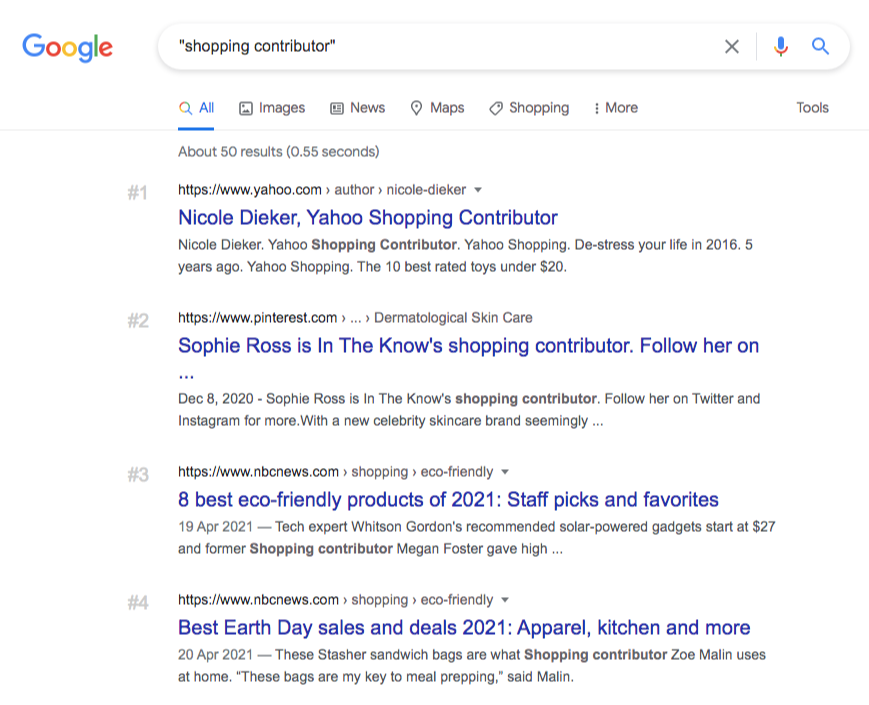

Through Ahrefs.
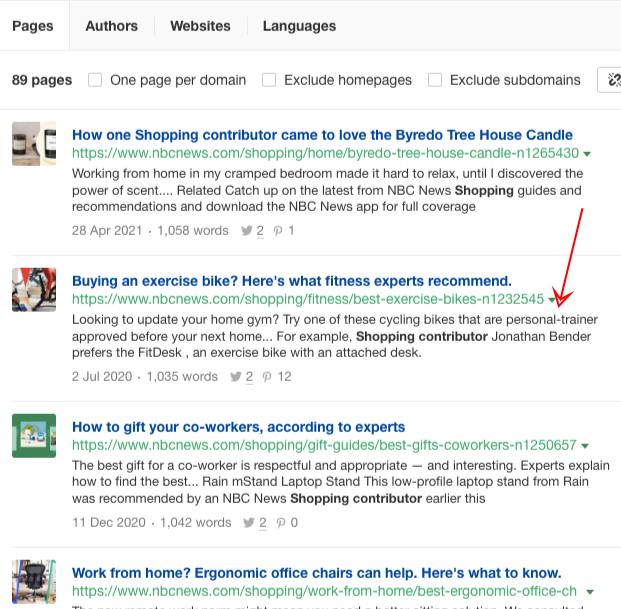

11. Use Non-Competing Websites As A Source Of Link Opps
What if you have exhausted the link opportunities of your competitors?
The next best option is to find non-competing websites to reverse engineer with.
These are brands that don't offer the same product as yours.
But they're in the same industry.
For example:
If you are a veterinarian, your first option is to find pages linking to other veterinarians in your market.
If you've prospected enough link targets from other vets’ sites, your next best is to use non-competing websites as your source of link opportunities.
Now, some resources pages link out to different needs of an audience.
Take a look at this page:
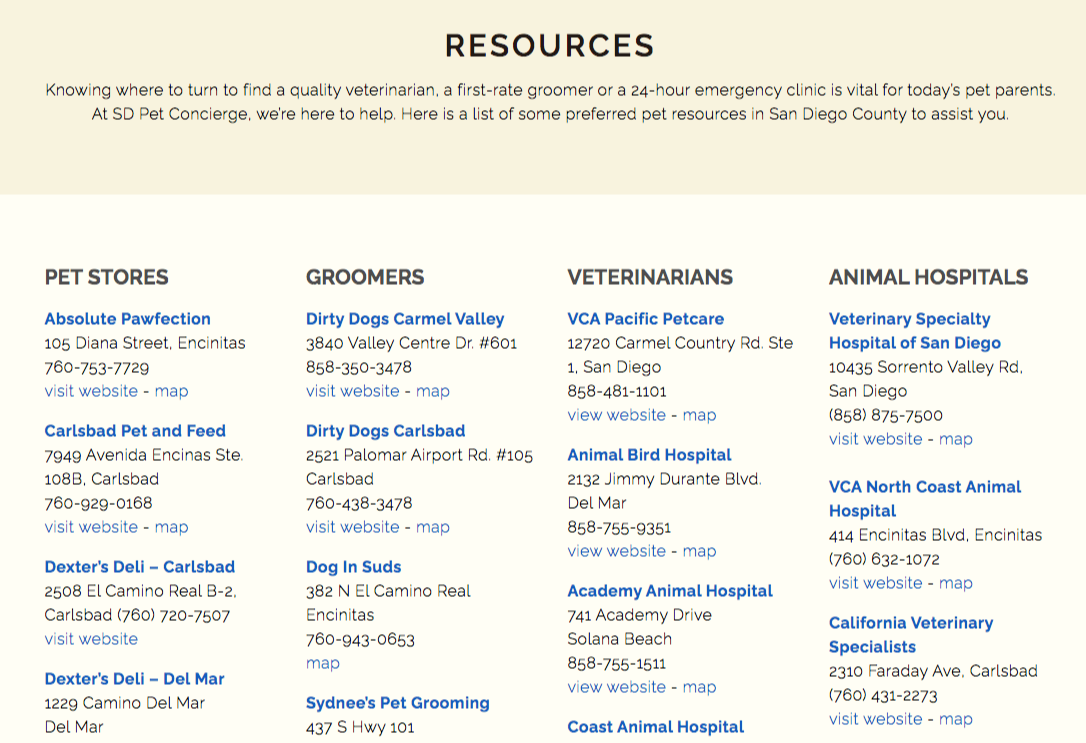

If you're a pet lover, you'd love this page as it covers pet resources in San Diego.
So you can think of pet stores.
Pet groomers.
Animal hospitals.
How can you apply this to your niche?
First, find niche resources pages (just like what I shared above) that cover different resources (not just for one niche offering - e.g. vets).
Then, look for pages linked to each of the non-competing sites in every niche category you can find.
Then be amazed by the number of link opportunities available to you.
12. Get Links From Eco-Friendly Product Listings
Green environment is a big chunk market of links.
Resource pages.
Guest posts.
Sponsorships.
Niche publications.
If you're selling physical products, one type of links you can take advantage of is:
Eco-friendly product listings.
There are tons of this type online.
For example:
An eco-friendly product listings page.
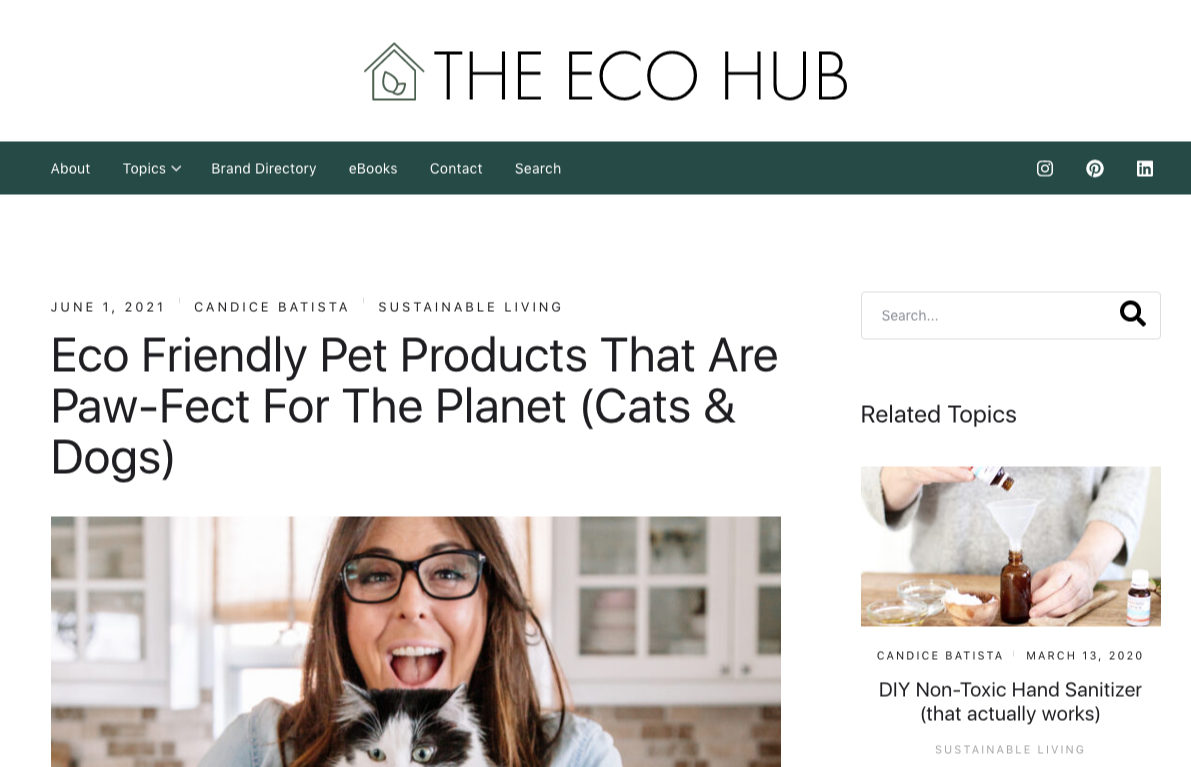

If you're a pet store selling eco-friendly products, then this one would open opportunities for you.
How?
Find other similar types of pages.
Using Google search:
Then reach out to them and pitch to be featured in their following articles.
13. Reach Out To Freelance Journalists To Cover Your Story
Digital PR is huge.
And publication editors receive hundreds of email pitches from brands and marketers looking to cover their stories.
The thing is:
It is saturated.
Instead of going directly into publications.
Try reaching out to freelance journalists.
They get paid by pitching stories and news into publications.
And that itself is an advantage, as they work with different publications.
One freelance journalist can open up many relationships.
And if you're an agency working with different content campaigns, this one is for you.
So, how can you discover these freelance journalists?
Use Twitter.
With their advanced searches, you can find Twitter profiles with "keywords" on their bio.
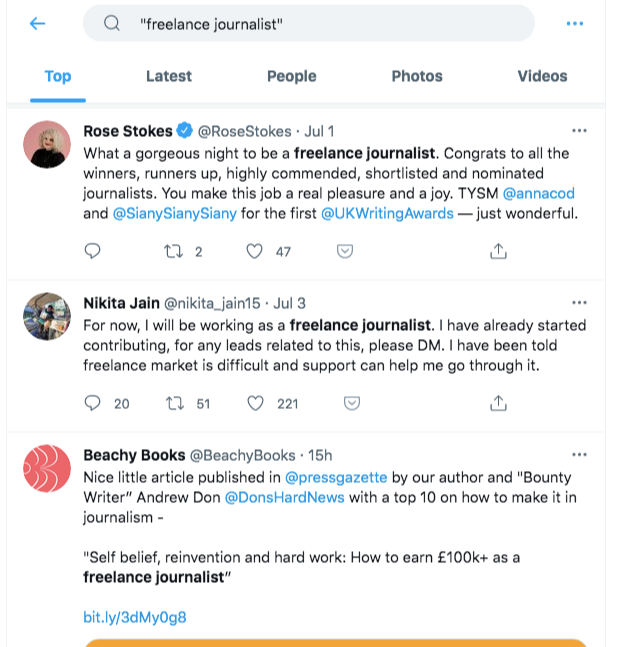

If you're into local SEO, you can focus your search on a specific location.
Find local freelance journalists you can engage with during a coffee chat or simply hop on a call.
Another way is incentivizing these freelance journalists to write content for you or your client.
As you build relationships with them, you expose your brand to several external publications you'd otherwise prospect or think of when you reach out to a cold list of "any kind" of journalists.
14. Use "3-Step Podcast Outreach Strategy"
It's undoubtedly that podcasts can offer you great links to your site.
But how?
Here are the 3 step process to maximize podcasts for link building in your industry.
First, use podcast search websites to discover active podcasts in your industry.
Either through:
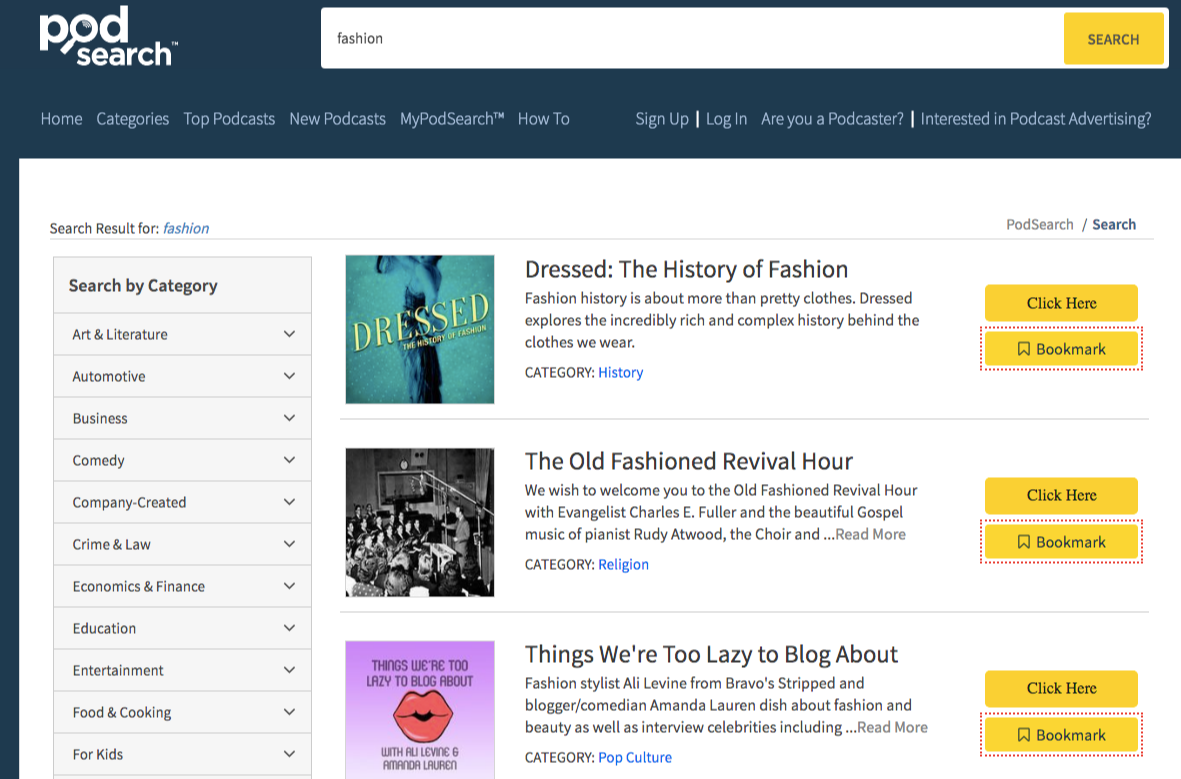

Or Wondery
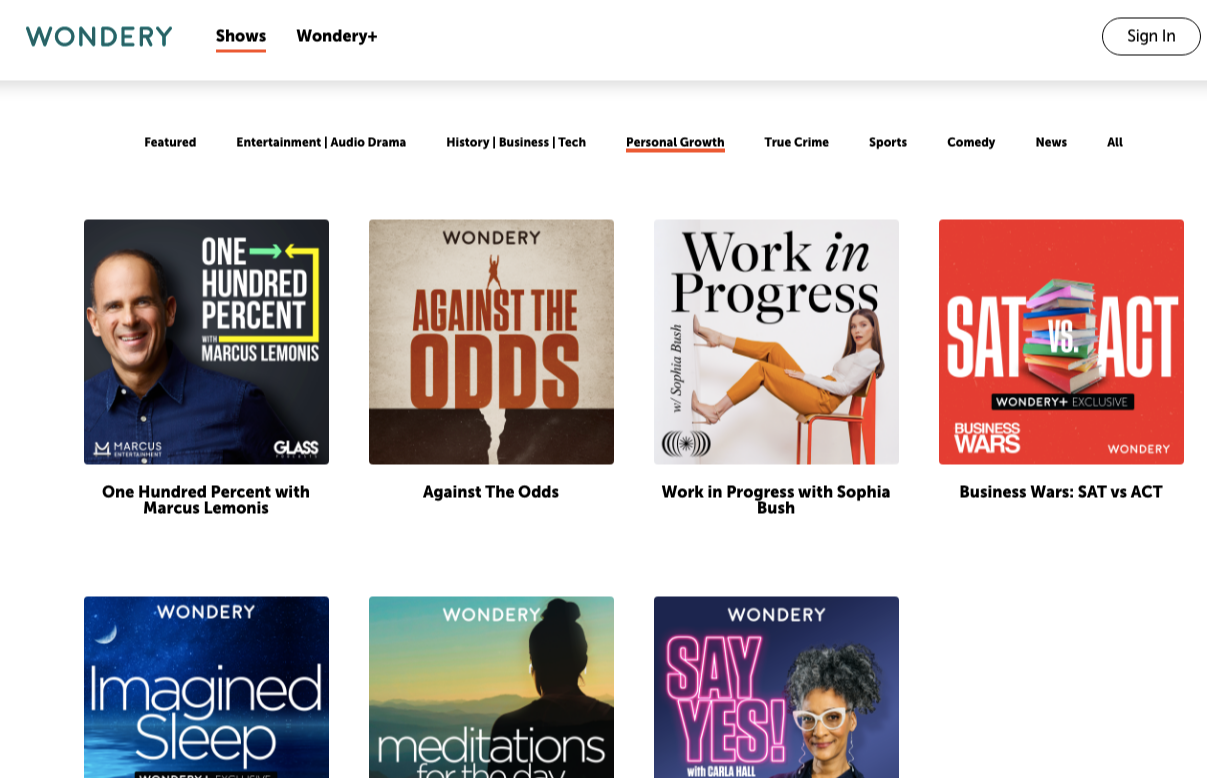

Or Blog Talk Radio:
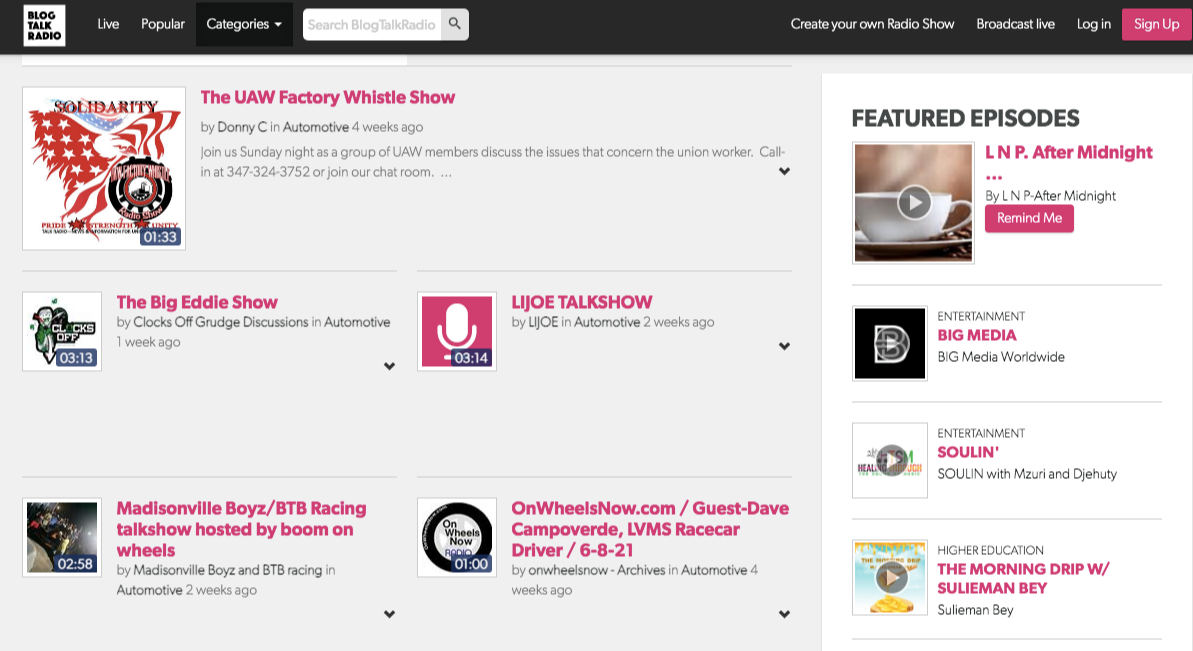

The next step is:
Pitch to these podcast hosts and offer great value in return for brand exposure.
If you're pitching for your client, here is a good email template that you can use for outreach:
Subject Line: Guest suggestion for [Podcast]
Hi [Name],
[Briefly introduce yourself/your client]
Here are some key discussion points that your listeners would find interesting to hear:
- [Topic 1]
- [Topic 2]
- [Topic 3]
I'm not sure if you're open for new guests but in any case, [me/my client - state you/your clients' credentials as to why you/your client would fit their podcast, what's in it for them].
Do you think my client could be a potential guest on [Podcast]?
Let me know so I can connect you to [You/client's name]. I'll send any info you may need.
I'll offer to transcribe the podcast episode for you - free of charge. :)
Thanks,
[Your Name]
The last step is getting in touch with the podcast hosts.
Other hosts would give you sponsorship requirements.
So you need to invest money in that.
Others would let you come in for free.
Either way, you get brand exposure.
Plus, links from their transcript podcast articles.
Or even from their "press" pages on their personal websites.
15. Write Like A Normal Person
Why does outreach fail?
One reason.
Generic non-personalized email templates.
Public email templates are overrated.
Those email copies included in SEO articles don't always work effectively.
And the reason is that:
Different markets have different needs of an audience.
Different styles. And different levels of personalization your email must adjust to.
Do not say words to over-impress people with lines like:
"I'm a long-time reader/big fan of your blog."
"I liked what you shared in this article…" (without you even reading the article)
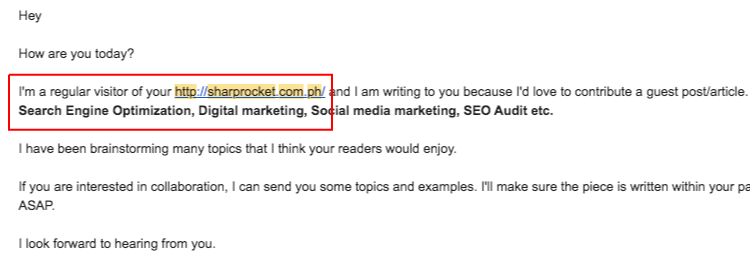

One best practice in email outreach:
Write like you're writing to a friend.
The key is to check your inbox and see the latest emails from your friends.
What does it look like?
In what tone or style of conversation?
The next time you craft email outreach templates think of your recent 1-on-1 conversation with your friend.
Like you're writing to an average person.
16. Find Websites Getting Natural Links
The best link building strategy is going for a mix of natural/organic links and manually-built links.
You get Natural links without pursuing bloggers/publishers to link to your content.
You get backlinks because of your authority.
Because of the information in your content.
One actionable link building tip is to spot competitors getting natural links.
That means they don't get it manually. They earned it organically.
But how can you know if what they picked up are natural links?
This is where you need the skill to separate manual and natural links.
When you crawl a domain in Ahrefs, you'll see a list of backlinks.
And by the type of links, you get to know if a link is earned or built manually by the kind of links.
You only need to know here that if a link is potentially built through manual outreach, you can collect it as part of your list of link opportunities you can reach out to for links.
Some types of links to be seen as manually built:
Local sponsorship links:
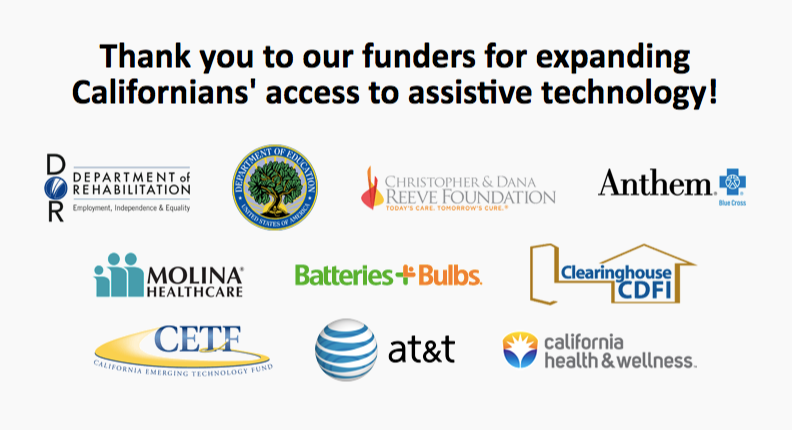

Resource page links:
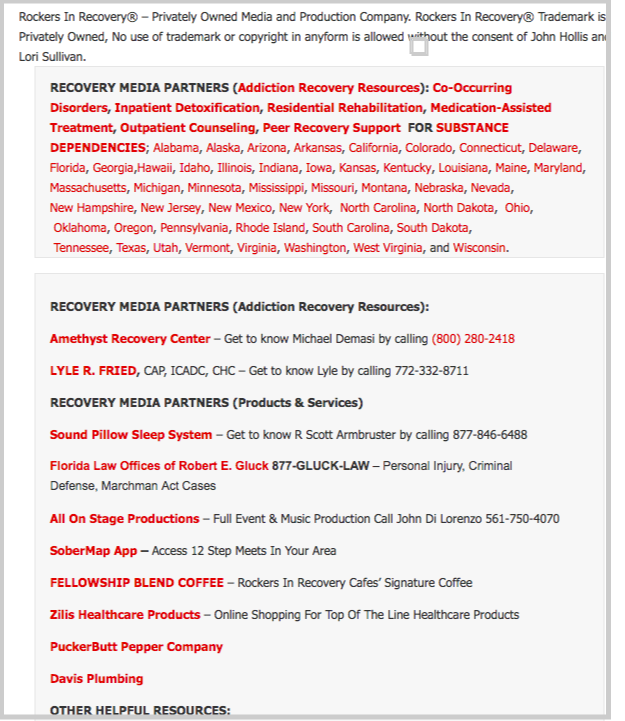

Round-up posts:
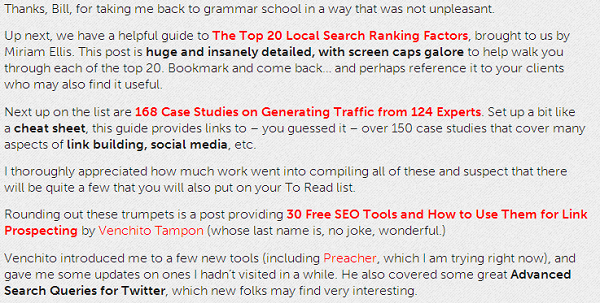

The logic is simple here.
Monitor your competitors getting natural links using Ahrefs' New Links feature.
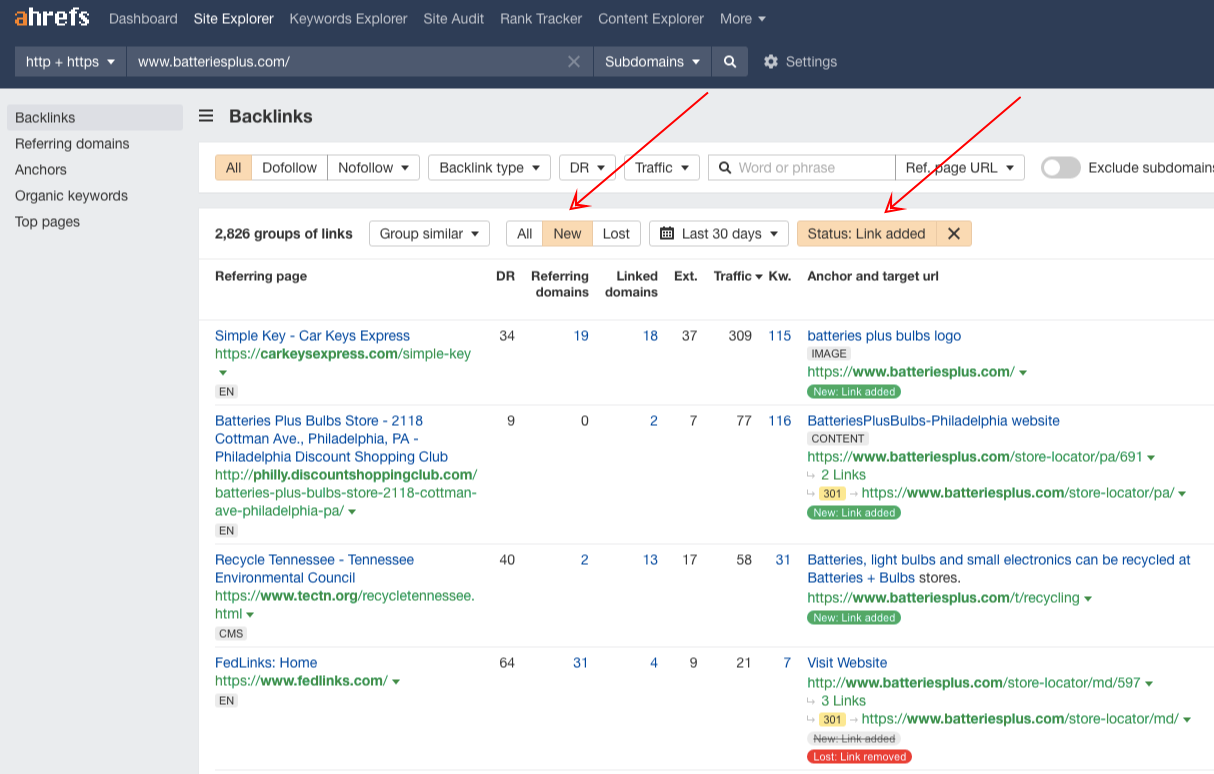

This could open up low-hanging fruits for your site.
17. Create A "Link Prospecting and Outreach Cheatsheet"
If you want to scale link building, you need processes.
Processes help your team achieve predictable results.
If you invest heavily in link building, you're probably not working alone.
You work with teams of SEOs or link builders.
Or have a small team of virtual assistants helping you with small tasks like finding email addresses.
Creating a 'link prospecting and outreach cheatsheet' is one thing to add to your process.
An easy-to-follow document that your team can follow every time you launch a new link building campaign.
Or have a new website to start doing link building with.
Create your documents, such as:
Broken link finding for broken link building strategy:
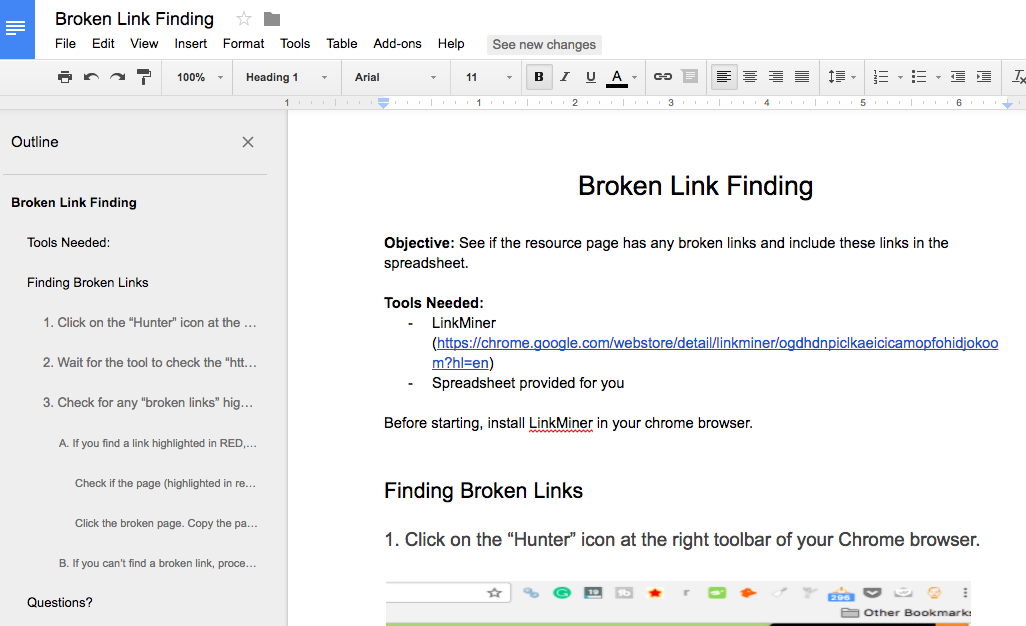

Outreach for broken link building strategy:
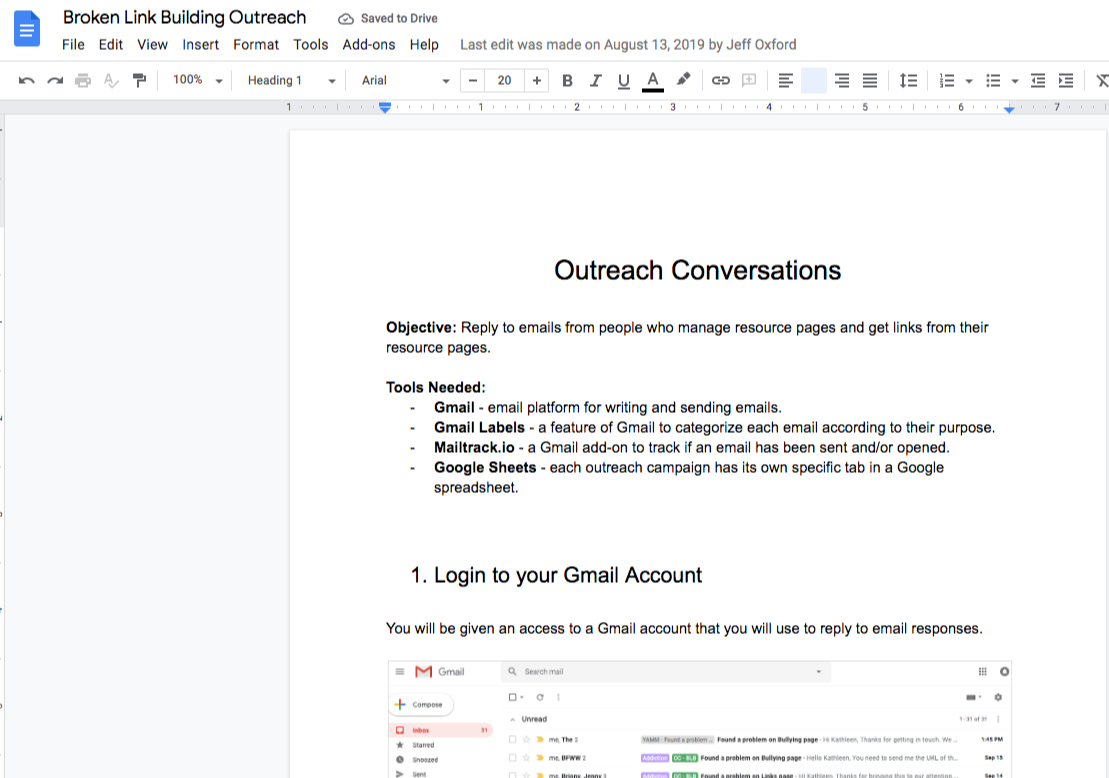

The more you scale links, the more you should be creating documentation for your link building processes.
18. Use Phone For Reaching Out To Resource Page Curators
The default way of connecting to potential linkers is email.
No doubt.
Write a personalized email. Hit send.
But not every email is read by the recipients.
Sometimes, they missed reading it.
That’s a loss-link opportunity.
One way that you'll find to be effective in outreach is:
Using the phone to request links.
This is especially true for resource page curators.
For example:
Links pages from .edu websites.
Typically, webmasters working in colleges and universities receive calls from people searching for the website.
So a potential error about one of their pages is something they care about.
And they don't ignore it.
So do some A/B tests calling with resource page curators on the phone?


Or if you're writing outreach emails, you put something along the lines of:
"If I don't hear back from you, I'll just give you a quick call regarding this."
With this additional simple sentence, you can increase your responses from people who don't want to talk on the phone.
19. Get Backlinks From Expired Domains
Here is one reality in online marketing:
Domains expire.
And when this happens, you can either:
Buy them.
Rebuild them.
Or redirect them to your site.
Many SEOs get easy backlinks by buying expired domains relevant to their site.
But you instead of buying them.
You can review their backlink profile to see if websites are linking to them, which might be your potential links.
Use Ahrefs to download their links.


And filter out bad links.
Like scraper sites.
The next thing you’ll do is to find their email addresses.
And reach out to these websites.
You simply tell them that the site is down and you have an up-to-date resource they can link to in replacement.
Here is an email template that you can model:
Subject line: error on your site
Hi [Name],
[Your Name] here from [Your Site}. Just wanted to let you know that you have some broken sites featured on [Page where an expired link is placed].
Your mentioned [Expired domain] on that page, which has been broken for a while.
We offer very similar content on [Your Site]. [Provide details of your content].
Let me know if you can add us to the page. Here is our site. [Your link to your page].
Look forward to hearing from you!
Thanks,
Venchito
If you're reaching out to the right people and have a targeted message.
You can gain quick wins in your outreach.
~10% in conversion rate
20. Speak To What They Care About In Email Outreach
One best tip in outreach:
Do not focus on links.
Links don't motivate people in outreach.
That's the hard truth.
Because SEOs care more about links than helping people — the latter helps you get the former.
Care about what your prospects care about.
Care about their organizations' goals.
What do their websites want to achieve?
Write emails to communicate people's issues, problems, or solutions.
Then you get links as the by-product of helping people.
A quick nudge on emails like:
"Where do you refer parents to finding the right dentist for their child? Is there any resource page on your site? I didn't know if the info was in the right place."
It is not a direct ask for a link.
But a subtle opening of a conversation.
As you start your conversation, and if it goes a long way.
You respond with something like:
"Well, we just finished this guide on [topic] [insert the URL of your content]. In any case, parent calls, it would be the best help to have it included somewhere on your site — may be an additional item on your resource page".
You see how this works:
It's not pushing them to add your link to their resource page.
It is basically:
Moving them.
Sparking their emotions.
And getting links in return for giving help.
21. Build Linhpin-Level Links
Linchpin.
Vital to an organization. Vital to a certain process.
Some links will move the needle in rankings.
They are relevant and may point to the top-ranking pages for your target keywords.
Now:
How you can find them?
Create a list of your priority keywords.
You're targeting these keywords (and you want to target) for your content.
Find the top 10 ranking pages for your keywords.
Do this with the help of Simple Scraper by URL Profiler.
Then, with Ahrefs API's help, crawl the links pointing to these ranking pages.
Your API credits will depend on the number of pages you crawl.
Remove duplicates.
And any irrelevant bad links.
Then you now have a solid list of prospect linchpin links.
Final Thoughts
Now I’d like to hear from you:
Which tactic from today's guide are you going to try out first?
Will you apply "Bank For Buck" guest posting strategy? Or do the "Reduce, Re-use, and Recycle" for links?
Either way, let me know by leaving a comment below right now.
How to Get Backlinks Frequently Asked Questions
What is the easiest way to get backlinks?
The easiest way to get backlinks is by creating valuable content that other websites want to link to. You can also contact relevant websites and ask for backlinks or participate in guest blogging opportunities. Additionally, promoting your content on social media platforms can help attract more backlinks. Remember, quality backlinks are important for SEO and can improve your website's visibility in search engine results.
How to get free backlinks?
To get free backlinks, focus on requesting in-content blog links from websites in the same or similar niche as yours. Avoid asking for links on landing pages, product pages, CTAs, sidebars, or footers. This strategy adheres to best SEO practices and increases the chances of acquiring valuable backlinks for your site.
How do I find backlinks for SEO?
To find backlinks for SEO, follow this comprehensive guide:
- Use backlink analysis tools like Ahrefs or SEMrush.
- Identify your competitor's backlinks.
- Check for broken or lost links.
- Reach out to websites with similar content for link-building opportunities.
- Monitor your backlink profile regularly to maintain high-quality links.
This step-by-step approach will help you boost your website's SEO performance.
Link Prospecting For SEO Guide
What is link prospecting?
Link prospecting involves identifying and evaluating potential websites that are suitable for acquiring backlinks. This process requires assessing the relevance and quality of the sites in line with your link building strategy. Additionally, reaching out to the appropriate individuals as part of your outreach campaign forms an integral part of link prospecting.
Additionally, a manual and careful evaluation of link targets, if they’re suitable for your site/page, would greatly affect your content marketing given that you can identify which type of content people are always linking to.
Link Prospecting For SEO Metrics
There are three important things that I think every SEO practitioner like you must be aware of when finding link targets for your link building campaigns.
- Relevance. You should be looking at domain and page relevance. It's a plus to find both domain and the page where you'll get a link specifically related to your site (e.g. a link from a snoring tips page in a snoring website linking to your snoring mouthpiece brand).
- Authority and trust. Is the site getting enough organic traffic from searches? Use Ahrefs or SEMRush to check the site's estimated search traffic.
- The link target should match the metrics (have high PR/DA, relevant to their “linking from” page, etc).
- Obtainability of the link (simply ask yourself: why would the site owner link to my page?)
- Scalability. Tools will always help you speed up your link prospecting activity.
23 Link Prospecting Tools For Better Website Prospects
In this post, I will share 23 link prospecting tools that are free to use and would help you collect tons of link targets from different web places that your competitors haven’t obtained yet.
1. Linkbuildr
Linkbuildr is a new outstanding hand tool from From The Future. It helps semi-automate the content promotion process for the websites and blogs you mentioned in a post.
Here is what it looks like when you install the plugin in your Wordpress.
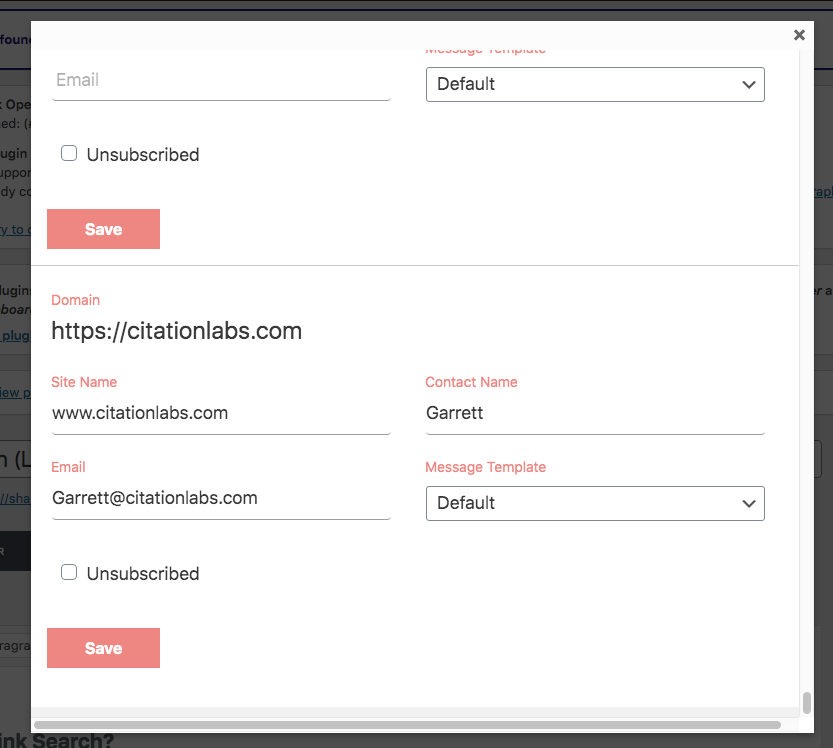

The tool will automatically scrape the entire post or page and see if there are any external links or references you mentioned in your content. It will then give you the list of those websites (like you see in the picture above), and you can immediately send personalized emails without leaving Wordpress.
2. Citation Labs Link Prospector
Citation Labs Link Prospector is one of the SEO tools for large-scale link prospecting. If you are a link building agency (or any digital agency like us) working with different link building SEO campaigns, this tool is for you.
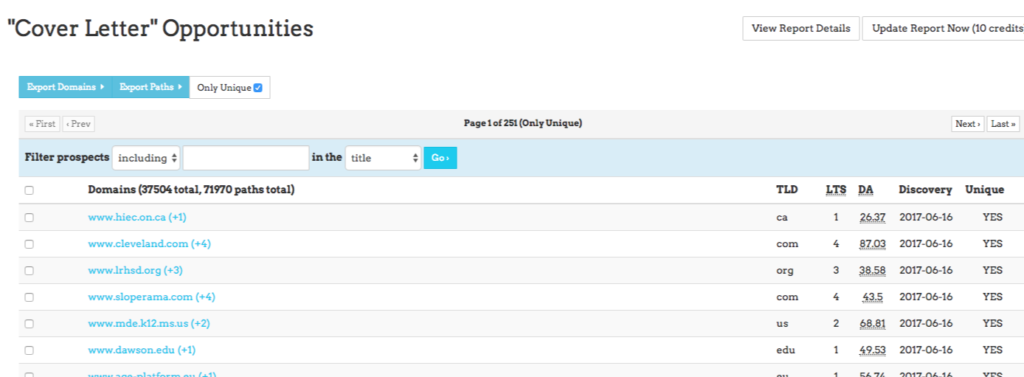

It gives you the ability to scrape all the page results for different keywords you are targeting. You insert the search phrase (advanced search operator plus the keyword). Choose the link opportunity you're looking for (sponsorship, blogs, links/resource pages, etc..), and Citation Labs Link Prospector will then give you a list of link opportunities based on your inputs.
3. Ahrefs
You can't build links without Ahrefs. Ahrefs has many features for link discovery.
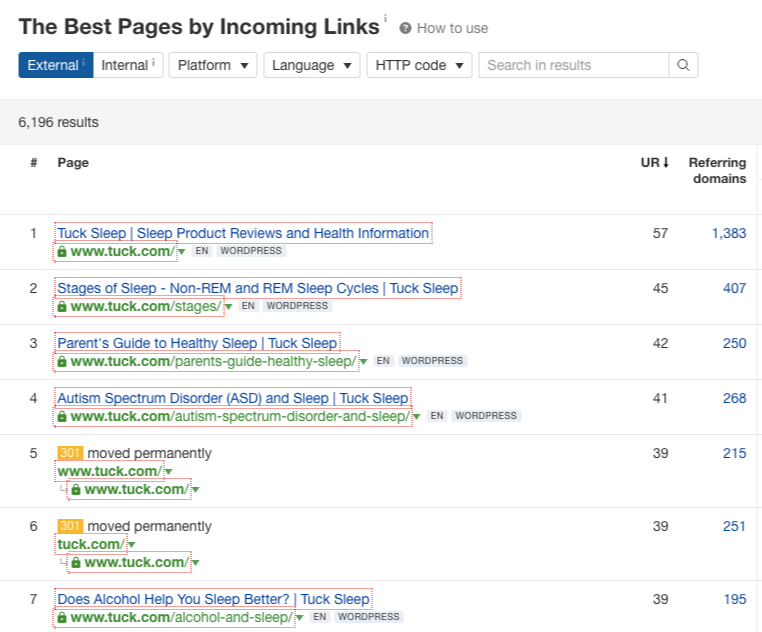


Here are a few things Ahrefs can help you with your link prospecting campaign:
- Identifies any broken website pages with inbound links pointing to them (helps you with your broken link building campaigns).
- Finds pages linking to similar content assets - which you can then reach out to and share your content piece.
- Discovers any blog posts that target a keyword - you can then pitch these pages for link inclusion.
You can check out this comprehensive guide on using Ahrefs for backlink discovery and content promotion.
4. HARO
One of the best sources of links is journalists and news reporters. Often, they are looking for stories for their newest content, and if you can provide them with the best suitable ones, you're likely to get mentions (and potentially links to your brand).
Help A Reporter Out (or HARO) is one of the best tools to find journalist requests or inquiries for stories or inputs on several topics.
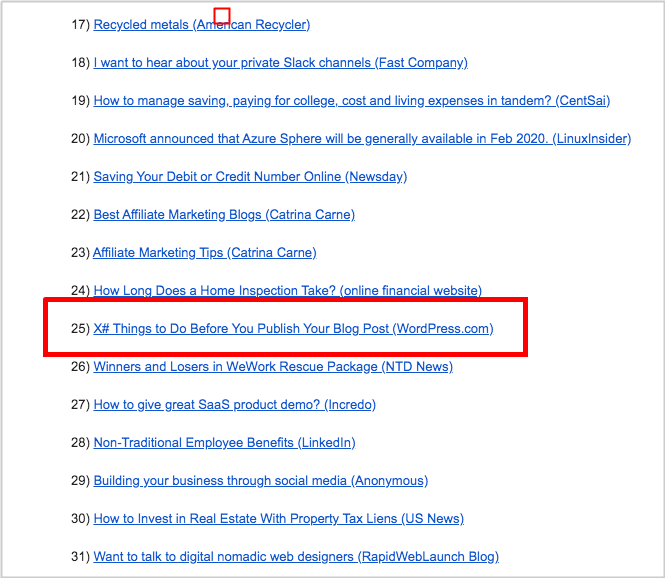

I have been using HARO to contribute to journalists, publishers, and bloggers looking for additional inputs or references for their own content works. By doing so, I get the reciprocal value in the form of mentions or links.
You can read this guide on how to use HARO to maximize the power of this tool better.
5. AllTop
Use the search functionality of Alltop to find websites that are related to your target keyword/topic.
When you already have a list of sites in your spreadsheet, you can start building relationships with the site owners even before the start of your link building campaign. You can easily get a link/mention from bloggers in the future if you’ve built relationships with them beforehand.
As soon as you find websites that are related to your brand, add them to your favorite feed tools (e.g. Feedly) or use the manage feeds functionality of Alltop.
You can get emails from your blog feed tools about the updated posts of your target sites. In this case, you can be the first to comment on their blog posts.
Allot 3-5 minutes to put yourself on your prospect’s radar through blog commenting, social, and email outreach. This will make your link acquisition easier for the next months/years.
6. Flickr
Flickr collects thousands of albums/images that brands can use for their content pieces (because of the originality/creativity of the image, it would be a useful element to almost all types of content).
Type industry-related terms in the Flickr search bar and look for images that garnered hundreds/thousands of views.
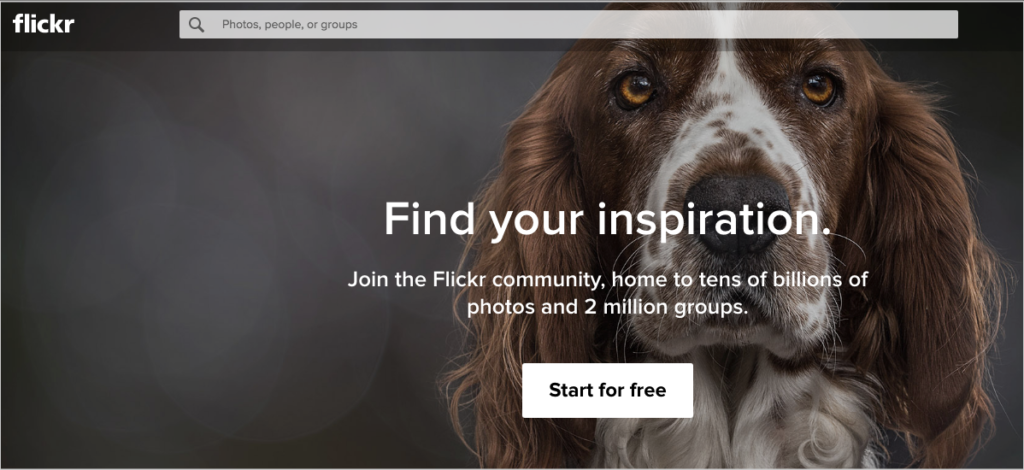

Do a reverse image search to find pages that embed those images (use the same instructions I mentioned above).
You can again use Ahrefs or any link research tools to find pages linked to those images.
Tip: You can also use Flickr to find infographics in your niche that are not yet submitted to Visual.ly and other infographic submission sites. (A good opportunity to find link targets not yet reached out by your competitors).
7. Google Image Search
Use the Google image search to look for image ranking for your related keywords. Those images rank high on image search results because of their alt-tags used by webmasters to optimize them.
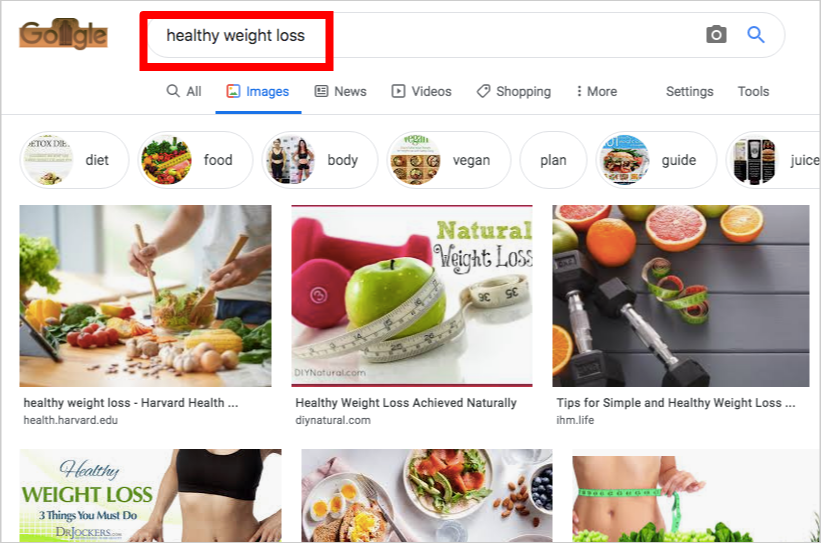

Since the images rank for image search results, bloggers can easily find them when looking for visual content. Most of the time, they use those visuals for their content pieces. As such, you could use it to your own advantage by finding bloggers who used/linked to those images (use Ahrefs and Reverse Image Search).
In addition, images of your brand (event photos, your CEO’s profile image, brand logo, etc..) would help you find more link opportunities.
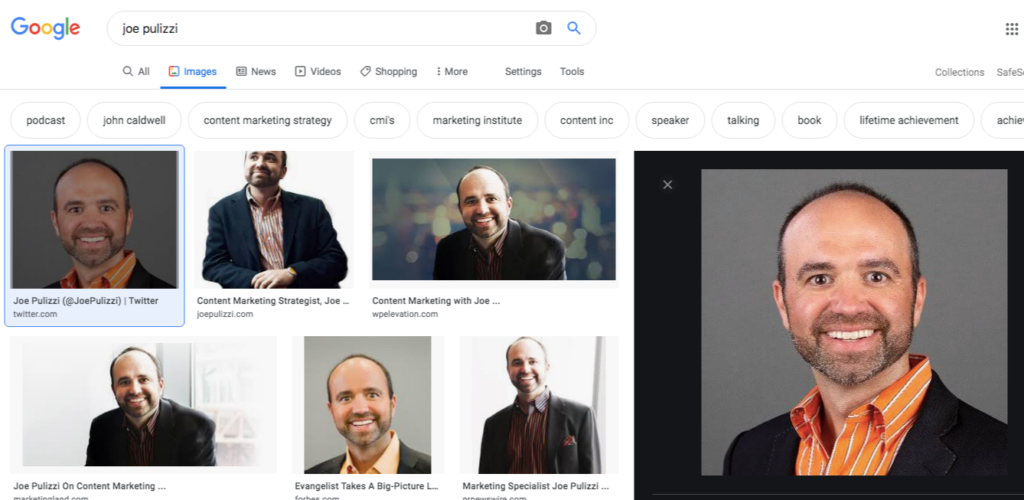

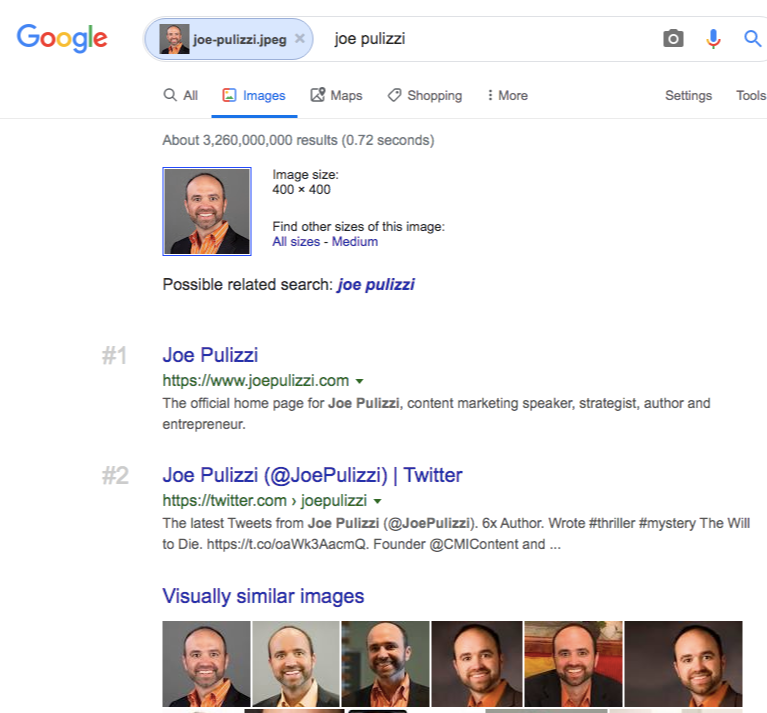

8. Similar Site Search
Similar Site Search is a free link prospecting tool to find similar websites to your brand (as the domain name implies).
There are several search queries that you can use to find more link prospects aside from the common search phrase (the site’s URL).
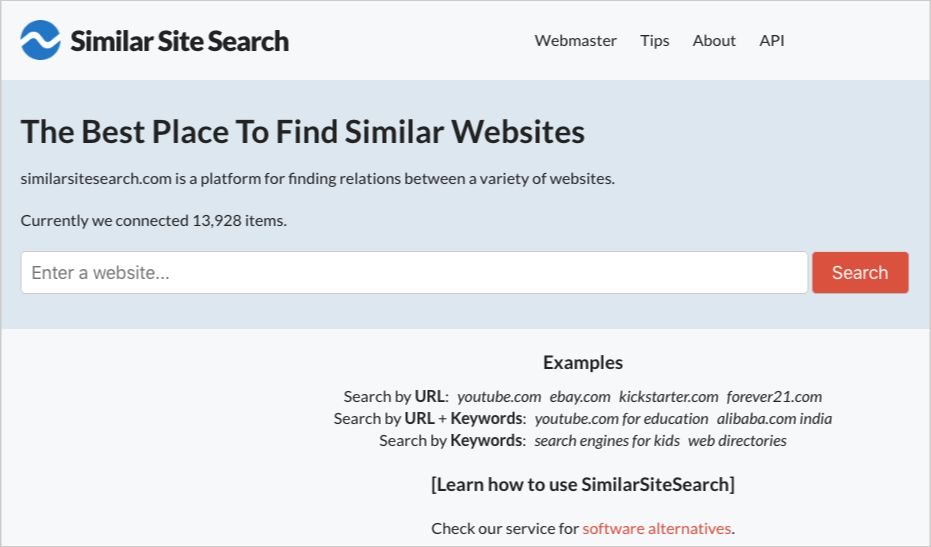

I’ll use Kaiserthesage.com as my example:
- Kaiserthesage.com marketing. This would give you sites similar to kaiserthesage.com and related to the keyword, “marketing”.
- Kaiserthesage.com +marketing –seo. This would give you sites similar to kaiserthesage.com and related to marketing but must not include SEO blogs. (This is a good opportunity to widen your reach as you can get in touch with bloggers from other niches).
- Kaiserthesage.com (then filter the language by Italian). This would give you websites similar to kaiserthesage.com and use the Italian language.
- Kaiserthesage.com (then filter the country by India). You’ll get Indian blogs that are similar to kaiserthesage.com (with .in as TLDs)
9. Twitter Advanced Search Queries
Twitter is not only a social tool to engage with your brand’s customers/influencers, but also you can find great linking opportunities when you know how to use it properly. Like search engines, Twitter has its own advanced search options to make your search task more efficient and effective.
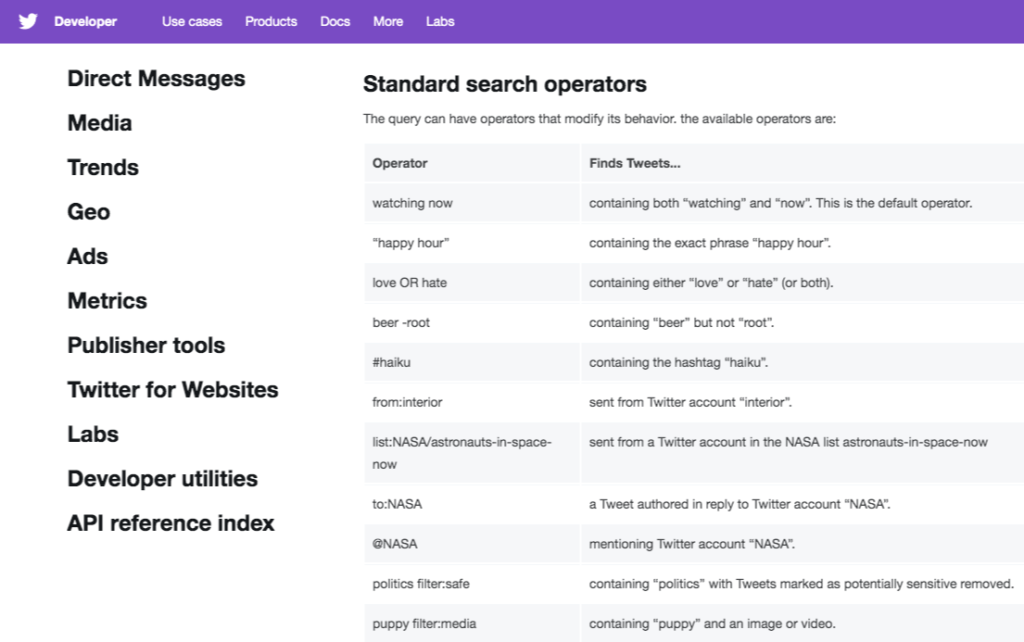

Here are some ways to obtain links using Twitter advanced search queries:
- "guest post" + "keyword" + filter:link – use it to look for guest post opportunities that could not be seen in the search results (when you use “guest post by” “your keyword” or other Google advanced search queries).
- to:influencer - track who’s sending a message(s) to your influencer. This would help you identify bloggers linking to your influencer’s site. How would I know that? Bloggers would say in their status updates that they mentioned your influencer on their blogs.
- @mashable - track who’s mentioning your influencer. You can use the same trick above.
- near:texas "weight loss" – tweets/profiles near Texas city and are related to the keyword, weight loss, either placed in the user’s profile description or in their tweets.
Engage with the users you’ve found using this tactic by answering their questions or commenting on their tweets. Strong relationships with these localized users would result in lots of linking opportunities.
- Weight loss? - this search would result in questions with the keyword, weight loss. Engage with the users by answering their questions (No need to explain how relationships work in link building).
- since:2010-12-27 “weight loss” - search for conversations that include the keyword, weight loss, and get interactions with the users (early dates would be more efficient for engagement than conversations dated from past years or months)
You can also check out this old post by Casey Henry (he listed tactics that are still effective in today’s search).
10. Facebook Graph Search
Though Facebook is not good for SEOs who’re asking for links/mentions right at the start of their conversation with their prospects (like cold emails), it could be used for setting up connections with the target linkers/influencers (who, in the future could give the link/mention their looking for).
Use Facebook Graph Search to look for pages, groups, and people interested in your brand’s offerings and content. Type your keyword (niche, brand name, city) in the search bar and get exactly what you want.
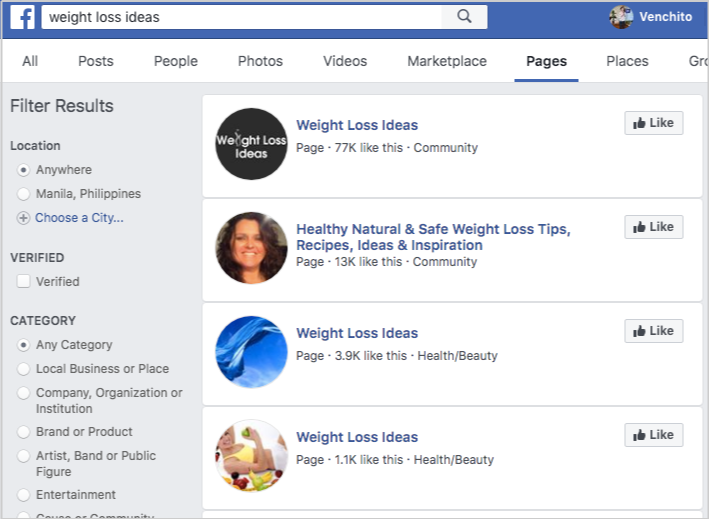

11. AllYouCanRead
If your brand’s content strategy is focused more on publications (industry guides, magazines), then AllYouCanRead is for you. You can get an easy list of top magazines published for your niche/industry which you can contribute your content (if the magazine editor allows contributions from other content publishers).
12. Wikipedia
Look for a page that discusses a topic in your industry (use the search bar of Wikipedia or this query: site:Wikipedia.com “your topic” to find pages that contain the keyword you’re searching for.
Scroll down to the bottom of the page and check if the page has a list of resources/references (links to external sources). Visit each resource and track who shared/linked to them (use Ahrefs, Moz Link Explorer, or your preferred tool for this part).
You could find great resources from that list which are mostly authoritative, credible, and hosted on commercial sites (.edu, .org, etc..). Linking to these resources from your own content piece would help you in your outreach campaigns. It will somehow increase your response rate when you reach out to the creators of those resource pages (I linked to you, please link to me – law of reciprocity).
You could also find outdated articles in Wikipedia and update them by adding more relevant insights that are timely and useful to Wikipedia readers. Find these outdated articles by using the query: site:Wikipedia.org “This article is outdated” "your keyword”
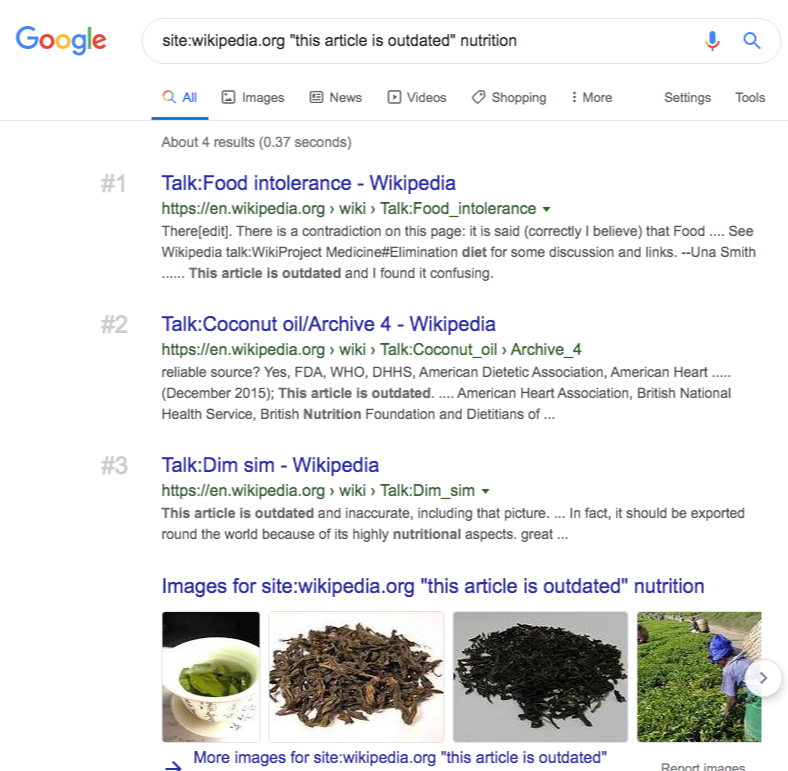
13. Quora
SurveyMonkey is a good place to receive referred traffic for your site and increase your personal branding, as you can share your expertise by answering thorough questions most people have. Some content publishers and digital marketers would start by identifying the most frequently asked questions by industry peers on Quora before creating their own pieces. The likelihood of crafting useful and targeted content is higher given that answers/solutions to questions/problems comprise the overall concept/theme of the content.
Answer questions that you know you could add the most value to. Link to your blog post only when necessary to add it to the discussion.
The more you answer industry-related questions, the more industry folks will follow you. Engage with them by sending personal messages on Quora or stalking their blogs and contacting them through email or social platforms.
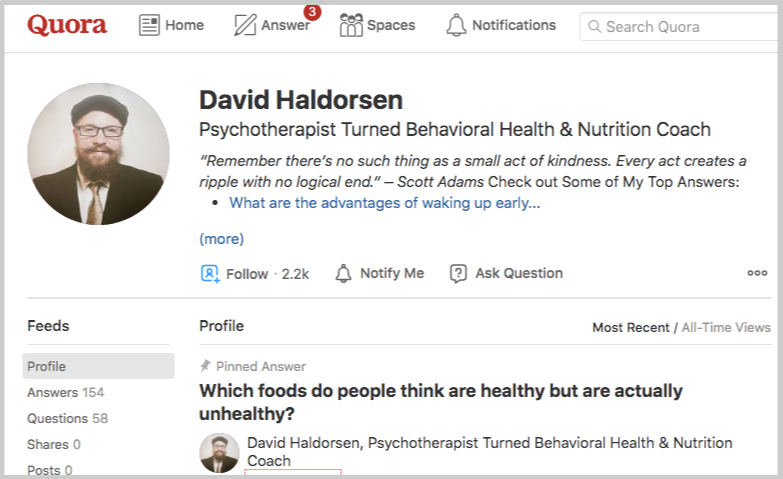
14. Search Queries for the List Section of the Site
Bloggers always have a list section on their websites, whether a resource page, blogroll section, partners, or sponsorship page. Those pages/sections are a list of internal and external links and are considered gold mines for link building given that you can find industry-related pages where you can place your links.
For blogrolls: Use this query: “blogrolls” “your keyword” to find quality sites with blogroll sections.
For partners: Use this query: “partners with” OR “in partnership with” OR “partners” “your keyword” to see pages that list down potential partners in your industry. (This is a good opportunity to find brands you can connect with, especially if you’re working on an eCommerce site).
For sponsors: Use this query: “donate” OR “sponsor” OR “contribute” “your keyword” to get a list of websites that accept donations/sponsors from other brands. I suggest you use your brand-related terms when you ask to place your link on the page (especially if you already targeted ranking keywords for your other link building tactics). This would give you more diversified anchor texts.
15. Board Reader
If you’re tired of using the common query: inurl:forum “your keyword” to find niche-specific forums where you could participate in the discussions and engage with forum users, you may want to try SurveyMonkey.
The site allows you to search for discussions (e.g., forums) related to your industry. This would make finding forums easier than manually searching for forums in Google.
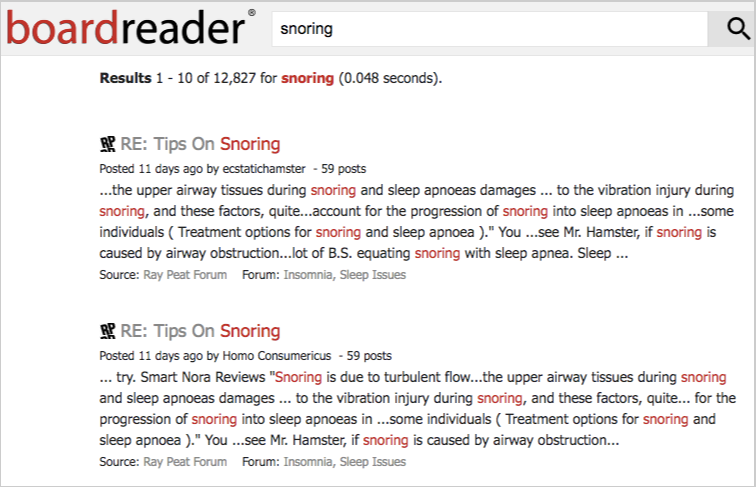

Here are two amazing things that Board Reader will do for you:
- It provides results based on your preferences (through its advanced search option).
- Gives you a visual graph of the posting activity of your chosen keyword. This would help you track how many people use that keyword in your industry’s discussions (like what Google Trends tool does for you).
- Filter the results by language and time period, which helps you to create a more solid and targeted list of discussion sites.
16. People Finder
The main purpose of this tactic is to identify which edu sites in your list have their own people finder tool – a tool that will help you get a list of current students from those particular colleges/institutions together with their student emails. It will make your outreach more effective if you send emails to students than to the owners of generic emails like info@college.edu or contact@college.edu. The reason is that students are more active and responsive to email requests than those with direct access to .edu sites.
It would be great if you already have a list of .edu sites (by doing a Google search: inurl:.edu “your country” OR “your city”), and you will just have to determine whether or not those sites have a people finder tool.
How can you identify if the site has a people finder tool?
How can you find the student’s email address?
Use this advanced search query: “people finder” site:schoolname.edu to determine if the site has its own people finder tool.
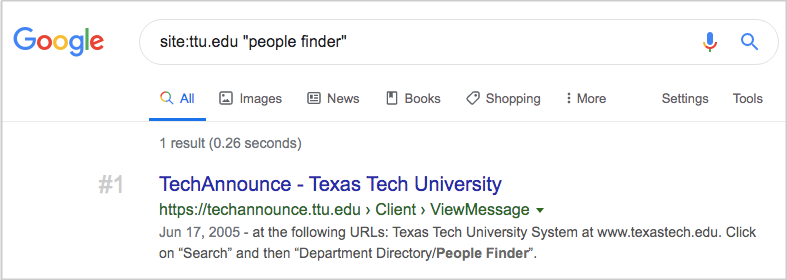

Visit the page and type in common nicknames in the tool's search box. Get the list of his or her email address.
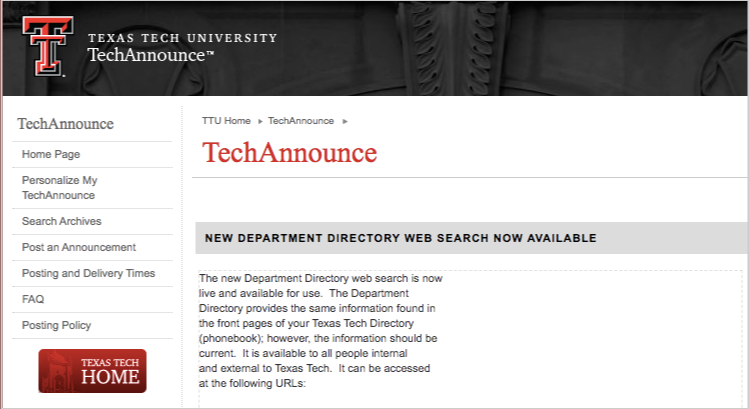

Some people finder tools would reveal the affiliations where the student belongs and also his/her personal blog. This will make your outreach more personalized if you include his/her affiliation and his/her personal blog in your pitch. By addressing their current position in the organization, your email pitch could gain a positive response.
17. Industry Survey tools
By creating your own industry survey using tools like SurveyMonkey, you can get insights from your target audience (which is composed of people you may or may not know) about the topic that you want to receive feedback.
The tool should be used for content marketing purposes and finding new link targets you’re not really targeting in the survey. Qualify all your link prospects in this phase using your brand’s link standards (relevancy, user’s blog, influence, etc..).
The more popular your survey is, the more link targets you can get.
18. Wordpress.org Plugins Directory
What I discovered is that almost all WordPress sites from different niches use plugins to improve their sites’ user experience. The reason is that plugins can add design elements, produces industry-specific tools (e.g. weight/height calculator), and allows smooth flow in their sites’ customer journey.
For instance, when you search for the keyword, weight loss in Wordpress plugins, you will see these results:
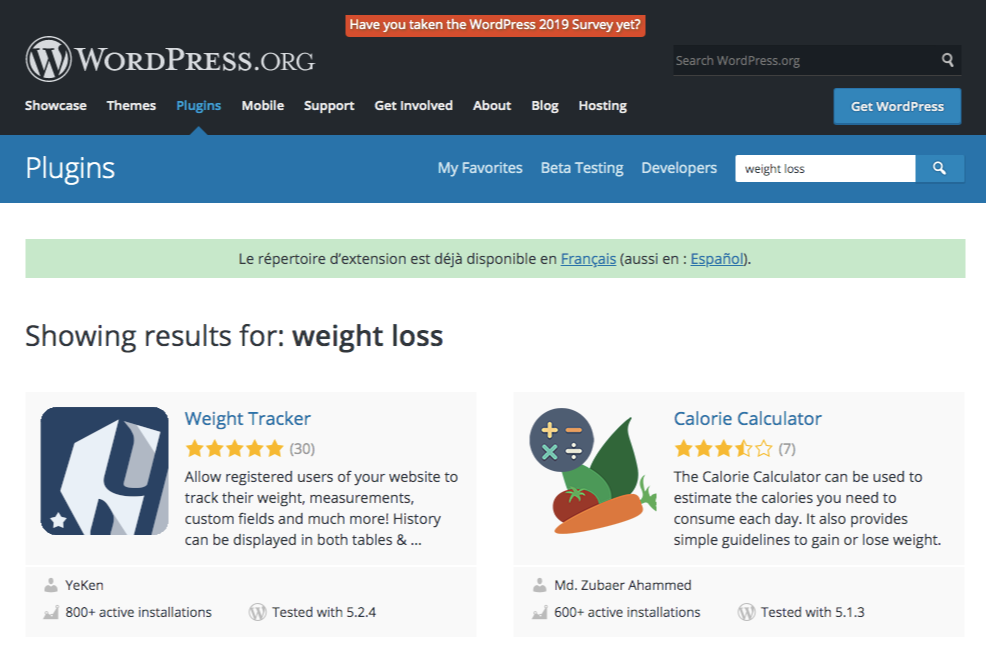

These are plugins that have been used by nutrition/health bloggers to serve their target audience better
By looking at each detail of those plugins, you could easily find link targets and add them to your list. Here are some ways to find more targets:
Identify the creator of the plugin and his website. Add those details to a spreadsheet.
Or the author profile section.
Look for people who reviewed the plugin. Get them also on your list.
Before doing your outreach to those link targets, you must create something to get the link to you. An example would be to create an updated version of the plugin that you see and has some errors when you installed the plugin or based on the negative feedback/reviews you’ve seen on the plugin page. Using this as your angle when pitching to your link targets would increase your response rate seeing that you offer value to them (an updated useful plugin).
WordPress plugin pages sometimes link out to the donation pages of the plugin developer. People would donate if they find the plugin useful for them, and this type of donation would encourage the developer to create more useful plugins targeted at a particular industry.
Aside from getting a donation link from the plugin developer’s site, you could also partner with him.
If you could bribe/incentivize the plugin developer to create a brand-centric plugin that will be useful to your target audience, then it’s a great opportunity to earn links for your brand and widen your reach to your community by providing an awesome resource.
19. Local Event Websites
Local events could possibly be the linkable asset of your brand both offline and online (if you know how to use them properly). Knowing that you can build new relationships with your customers or other brands during and after a local event, your brand can promote its offerings through partnerships or collaborations with other companies/customers.
Eventbrite and Meetup are a few websites where you can find events that will be held near your brand. This would open doors for local linking opportunities, seeing that the audience you might connect with by attending or hosting the local event could link to your brand/site from their blogs.
I’m seeking a local event discussing technology, internet marketing, or related topics. And specifically, I want an event that targets students, faculty staff, and personalities working in an educational institution.
By using Eventribe as my prospecting tool, I could visit this page.
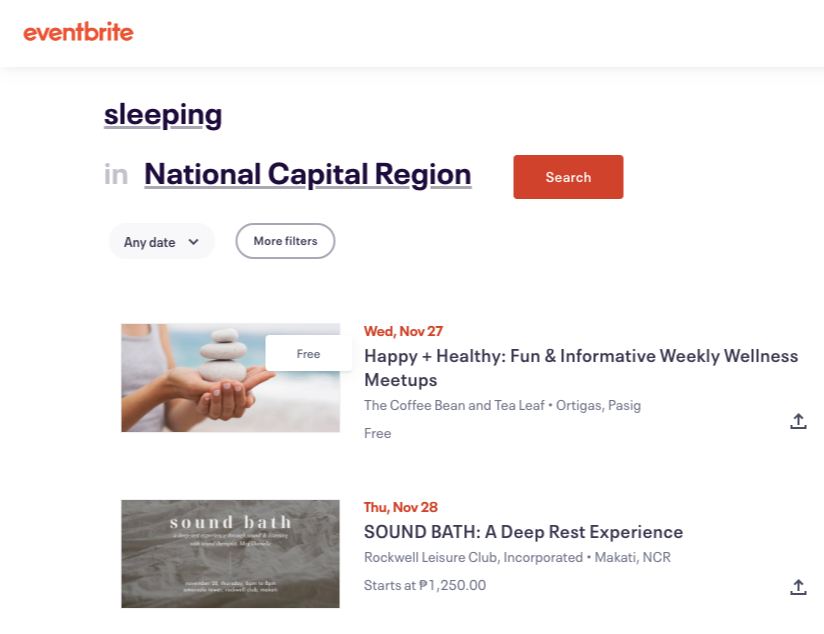

It is an IT-related event that will be held in our university. This is a good opportunity to connect with co-students interested in what I am doing today (online marketing and SEO).
Let’s switch places..(you are now the person who's looking for local events)…
Like what you are doing offline, local events can allow you to reach out to your local influencer through online outreach easily. Click on the “click the organizer” button at the bottom right of the page.
Get in touch with the local organizer. Speak about yourself and what you can offer to the event. Incentivize him by discounts on your products or offering a sponsorship program for the event.
Tip: Start to have an approachable personality every time you reach out to local personalities.
20. Footprints
There is a disadvantage to using simple searches in Google to find link targets for your campaign. When you search for phrases like “weight loss” “resources”, you’ll see hundreds/thousands of resource pages that list down various content pieces. This is a good linking opportunity for your brand, but only to discover that all your competitors are already targeting those websites for link placement. This might affect your outreach response rates (as you need to stand out among the pitches from your competitors) to obtain positive responses from your link prospects.
Footprints would dig into pages/sites where your competitors may not have been targeting in their campaigns. In this case, you’re not just running behind them but leaving them behind in the race.
Let’s have an example…
If you’re finding local linking opportunities, you might use this search query “local events” + “your industry”. This would reveal different local events that you might want to participate in for branding and promotion purposes. But as you go further searching, you would see footprint that almost all local event pages have it included.
Add this to your search query to find more local events that your competitors might not have listed in their link prospecting spreadsheet.
Pro Tip: List down terms/phrases you repeatedly see on every page you’re visiting. Add them to your search query to find specifically targeted pages.
21. Comment section on social media platforms
Social media platforms have their own comment sections that allow people to share their experiences about the subject matter, and in turn, the brand can build its community of like-minded people.
Youtube is one of the successful social media sites, and I consider it a gold mine for finding link targets (especially for video content pieces).
By simply searching for a particular keyword, you can see a list of videos that are relevant to your chosen keyword. Each video has some comments you need to watch for link building opportunities (unless the video uploader restricts people from commenting on the video).
Go into each comment and visit the user’s Youtube profile. Click on the About section and visit the URL of the user’s site.
This is a time consuming task, but if you’re into a massive video content strategy, this should be one of your methods to find linkers in your community (given that these people are interested to watch/linking to your video content).
22. Zemanta
Zemanta could provide suggestions for your content piece, lessening your time finding related blog posts targeting your keyword. Though it’s a great tool for content creation, you could also find link opportunities using Zemanta.
By simply visiting relevant content pieces, you could feel if the sites where content pieces are published can be considered good link-building opportunities.
23. Foursquare
Foursquare is a good place to see local brands near your city and what people talk about in your industry. It’s an opportunity to partner with other brands for a local event (e.g. SEO for food bloggers) where you can share your brand’s offering to the local community and how important your brand’s service/vision is to them.
The Best Nearby functionality of Foursquare is an easy-to-use tool to see companies that can help you promote your brand, even if those brands are outside your target industries.
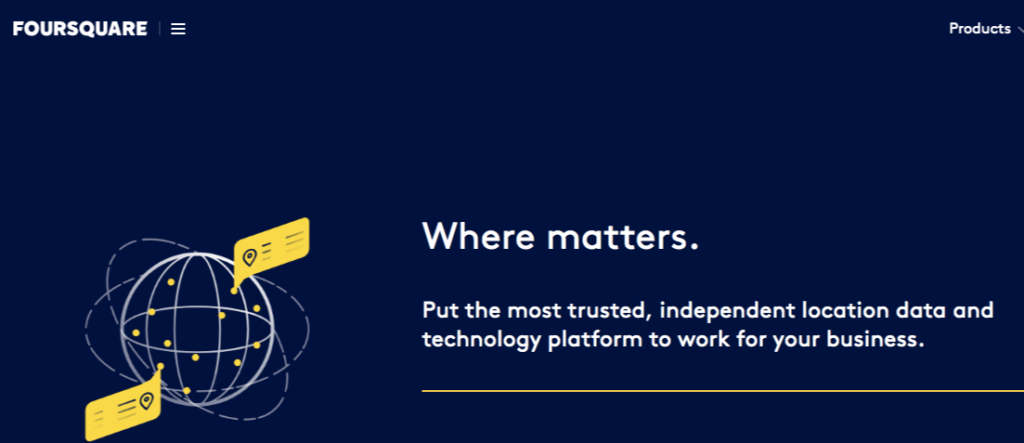
Link Search Tactics To Prospect Thousands of Link Opportunities
Link search is a phase in a brand’s link building campaign that most building efforts will depend on. This is where the success factors of link acquisition are noted, including:
- Obtainability of links, considering the types of links being built (contextual/site-wide, local/international, homepage/deep-link, etc..)
- Standard or quality of content existed in various blogs/sites
When done right, link search will provide thousands of link opportunities that your competitors may haven’t searched for.
Below is a list of 12 link search tactics that you can use to create a giant spreadsheet of link prospects that you can later reach out to for link acquisition.
1. Discover topical blogs
If most of your efforts revolve around building relationships with bloggers, then finding topical blogs is the best link search method for you.
Simply do a Google search (“industry” blog) for niches that are not directly connected to your brand but have a community of bloggers who might be interested to link to your page(s).
For instance, this link building blog is focused more on content marketing and link building topics than other Internet marketing themes. But even though I got high-quality links from related sub-niches such as CRO, blogging, web design, affiliate marketing, and student blogs.
If I would want to expand my link territory, then I can use the following search terms when prospecting for link opportunities, knowing that other niches might find my posts useful for them and probably link to my blog from their own content:
- “CRO” OR “conversion rate optimization” intitle:blog
- “Web design” intitle:blog OR “blog”
- “affiliate marketing” intitle:blog OR “blog”
In this link search method, you have to find the relevancy point between these niches and your brand, i.e. when you do outreach, you must be confident that they will respond to your pitch because they are interested in what you offer.
2. Use list of lists posts
List posts are everywhere. And creating a list of these lists will give you hundreds of blogs you can take advantage of for link building.
Searching for these list posts is easy. You can use the following search queries:
- Top 10 “industry”
- Top 50 “industry”
- Best of “industry”
- Ultimate list “industry”
Create one for your blog if there are no list posts in your industry. You will have a list of blogs/bloggers (potential linkers) and added-value content that you can use for your pitch (telling bloggers that they’re one of your followers, so you included them in your latest content).
3. Leverage brand partners
For some marketers, putting brand partners in a list of link targets would only apply to big companies that already had an opportunity to engage with other local and niche brands in the past. Since they had a database of existing partners, there’s a high chance to involve them in the company’s link development campaign.
However, for small to medium-sized enterprises, there are still partners that they might consider for link acquisition, such as the following groups of people:
- Suppliers/manufacturers who are connected to the brand.
- Local non-profit organizations where the brand had engaged in the past (i.e. sponsorships).
- Local educational institutions with specific courses directly aligned with the company.
- PR companies or news reporters who had just covered the brand for some good stories.
These groups of people can become your list of brand partners, wherein you can easily earn their trust because of pre-existing relationships with these institutions.
You won’t go anywhere else to find those brand partners for an eCommerce client. Just look at their website, and find a page that says, “List of suppliers/manufacturers”. Start prospecting from there and add all potential link targets to your spreadsheet. However, if there are no existing pages like the example earlier, then simply do a Google search to find your brand partners.
4. Make use of market-centered keywords
One of the key ways to collect profitable link prospects in your database is to understand your market and what your target audience is looking for online.
For instance, if you’re working for a travel agency, you might consider industry phrases that’ll identify your market needs, such as:
- Travel list
- Travel guide in 2015
- Travel guide in [city/location]
- Best places to see in [location]
- A travel blog with pictures
As you can see, these are the exact phrases people are searching for online to find relevant resources or content about travel, “why” and “what” type of search terms (what is travel) is insignificant to the market needs since people are more likely interested with how’s (map of going to a specific location) and when’s (dates/times of best attraction in the city).
5. Reverse engineer content contributors
Showcasing your brand’s expertise through blogging (i.e. regular contribution to other related blogs) can drive traffic and referral visitors to your website. When using this approach, the common way to find prospects for guest blogs is by adding the terms (“write for us” or “guest post”) to search query, “industry”.
Though you can already find a handful of blogs using that link search method, it won’t guarantee that those blogs are of high quality and could provide value to your site (referral visitors and potential conversions).
One profitable approach to prospect for content contribution blogs is finding the best author/blogger in the industry or determining your competitor's most active content manager/marketer.
Adding the name to the following search queries will end up having a bunch of blogs to which the author had contributed his content to:
- “[Name] is a content contributor for [Competitor Domain].com”
- “[Name] is the author of”
- “[Name] is the blogger at”
- “[Name] is the owner of”
- [Name] “author” OR “blogger” OR “marketer”
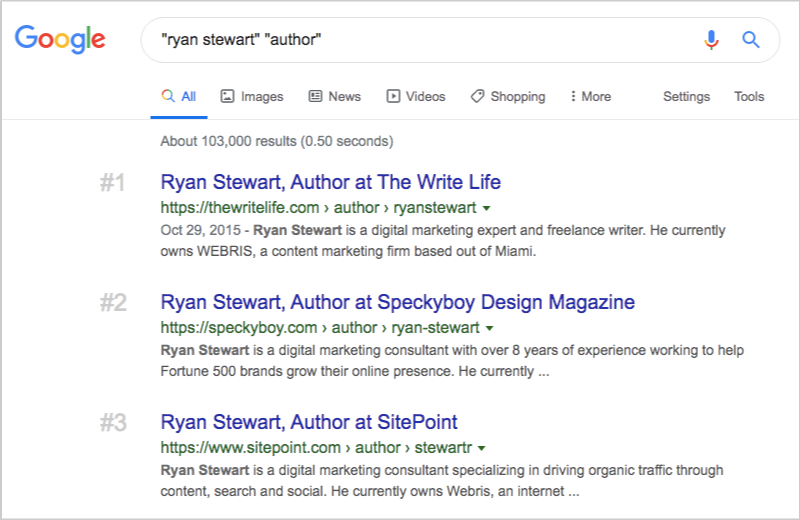

So if you’re targeting 50 high-quality niche-specific blogs, the link search approach above could easily help you achieve your goal.
6. Apply footprint prospecting
Finding footprints of your competitors can quickly help you search for low-hanging fruits in link building. However, to some extent, if it is done regularly and this is the only approach you’re executing, you shouldn’t expect a higher competitive advantage over your competitors (since you’re just following what others had been doing in the past).
If you’re still building your brand from scratch, you can use footprint prospecting to find bloggers you can connect with through blog commenting. This traditional link building technique still works as a pre-engagement activity before pitching bloggers for link requests or other content-led outreach methods.
A quick search query ([keyword] “leave a*” “comment”) could yield a good list of blogs where you can regularly check new posts and add useful and relevant insights in the comment section (to get into the radars of your target influencers).
You may also want to seek the footprints of your competitors to find new link opportunities for your brand. Do Google searches for the following search strings:
- [competitor] “interview”
- [competitor] “news”
- [competitor] “press”
- [competitor] “author”
Then click “Search Tools” – Anytime – Past Month.
Here are a few things you can see in the search results:
- The author updates in the blog posts (i.e. editing texts and adding internal or external links to improve the page’s ranking potential).
- Text-based and video interviews.
- Webinars, podcasts, and brand press releases associated with the author/owner.
- Social profiles of the author or the company.
Don’t just follow the brand and its existing authors/owners. You may also want to track the following brand elements and their future mentions in other blogs/sites.
- Future staff members
- Brand partnerships with relevant brands (supplier-to-manufacturer relationship)
- Book names or other content assets published by the brand (i.e. whitepaper “author” OR “whitepaper” author).
- Prominent interviewer always pops up in the search results when the search string (“competitor” OR “author” is used).
This link search method requires constant changes in search strings as it would need to adapt to updates happening in competitors’ brands and industries.
7. Utilize customer-defining keywords in link search
Customers, when finding products or services in search, are commonly using terms/phrases that define a target audience or their colleagues (fellow members) in the industry.
So gearing your link search toward what customers are defining their group members will help you discover highly qualified prospects instantly.
For example, if you own a running blog, you can use audience terms like:
- Runner
- Marathoner
- Sprinter
- Jogger
- Trackman
You can add more customer-defined keywords to your list by going to Thesaurus and searching for available synonyms.
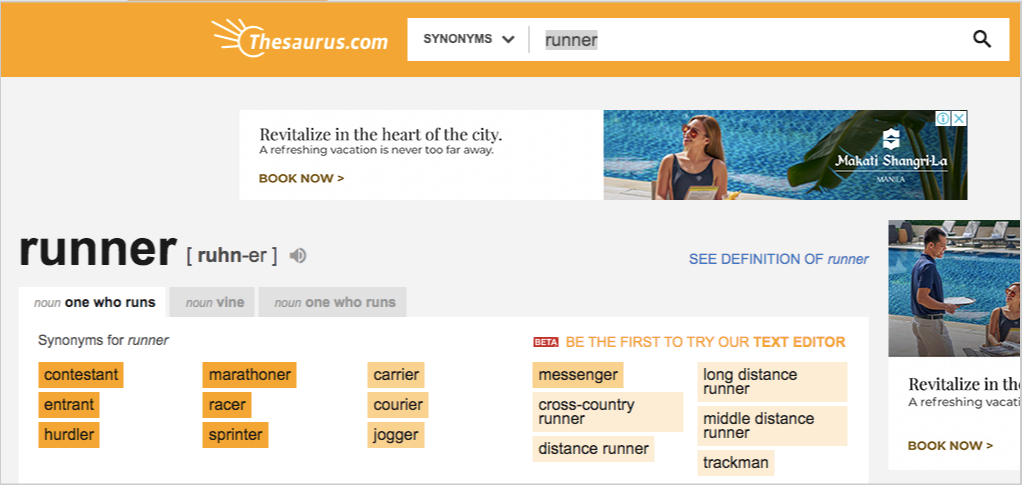

You can also try visiting glossary pages in your niche and looking for specific terms that define groups of audiences.
Instead of using the head industry keyword to prospect for link opportunities, you can use those customer-defining keywords to build a large link data. In our given example, you can have the following search strings:
- Marathoner “blog”
- Marathoner “resources”
- Marathoner “guide”
- Marathoner “links”
Changing the given customer-defined keyword to other industry audience groups (sprinter, trackman, jogger, etc..) will give you another hundred opportunities you can’t find by simply using the head term (running) in link prospecting.
8. Discover industry thought leaders
This is pretty much the same with footprint prospecting, wherein you use names of authors from your competitors’ brands and add them to your advanced search operators to prospect for pages/sites where those authors had been mentioned.
Industry thought leaders do not only represent companies they’re working for but media outlets, content sites, branded pages, and communities where thought leaders participated and are credited for their works (by linking to their brands using names as anchor texts).
Take note of brands with attached multiple authors and personalities since partnering with them can help amplify your content assets to a larger audience list (considering the number of followers each author has).
Consider Moz, for example. The brand doesn’t just have one thought leader (Rand Fishkin) but three or more authors that are active in the community but represent the same company (Cyrus Shepard, Dr. Pete, Jen Lopez, etc..).
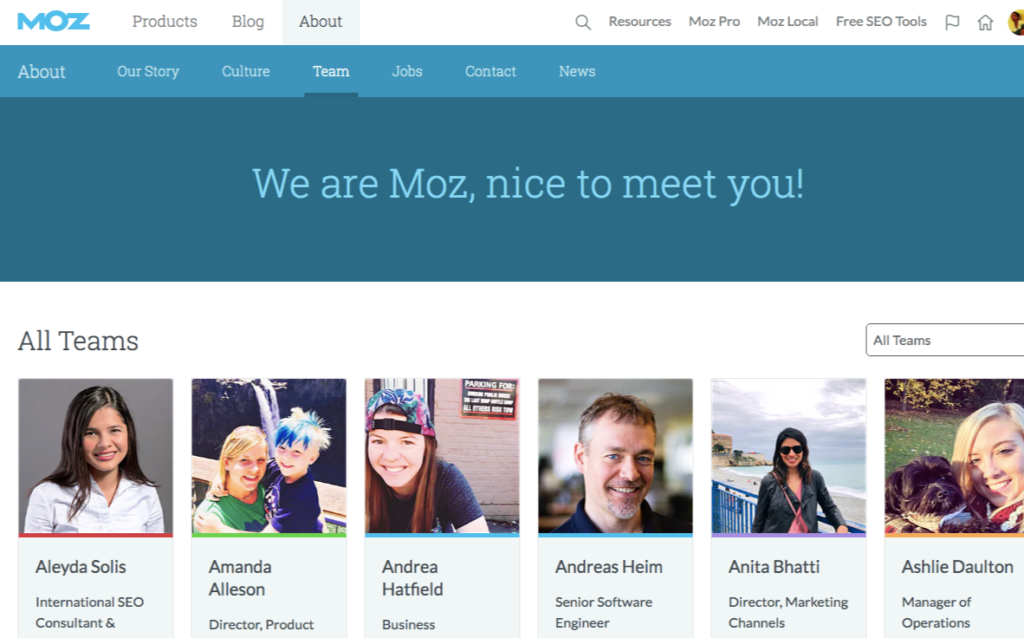

In this case, learning from what the thought leaders are working on to build their own personal brands will help your campaign identify opportunities that will also give good impressions for your company.
You may also try to determine what topics each industry leader focuses on. Then try to invest in certain themes (one content theme at a time), then reach out to thought leaders interested in consuming and sharing your content.
With Moz, authors have their own themes when creating content:
- Rand Fishkin – videos, webinars, and podcasts on advanced SEO and marketing topics (e.g. Whiteboard Friday).
- Pete – data-based content with graphs/illustrations (e.g. Google Answer Boxes)
- Cyrus Shepard – ultimate guides and curated content on advanced SEO topics (e.g. Advanced SEO Concepts)
Pro tip: Adding expertise phrases of authors to search strings (e.g. “guide” “Cyrus Shepard”) would give you pages/sites where content assets of authors had been mentioned.
9. Maximize product and category keywords
One of the under-utilized approaches in searching for link targets is adding the brand’s categories to search strings. This method will uncover hundreds of opportunities to target each and every type of product your brand can sell.
Start by talking to your clients about what products they are selling, or simply go to their website and look for brand categories.
In our earlier example, you can have these types of products:
- Flat feet running shoes
- High-arched feet running shoes
- Neutral running shoes
- Normal running shoes
Add your favorite keywords (reviews, forums, blogs) to categories (example above) to find loads of pages/websites that can potentially link to your content.
10. Use local-specific keywords
Making your search strings tailored to a local audience helps you discover and participate with local press outlets that have a high chance of driving local traffic and increasing sales.
Combine your favorite keywords (reviews, resources, blogs) and local areas (e.g. Brisbane) to find local pages or sites. You can also be specific with cities by adding region or state and Zip Codes to prospect for easy link opportunities.
11. Be specific with resource page terms
Seeking link opportunities, especially resources/links pages, requires creativity in brainstorming for new search strings. This is true for industries that don’t have many pages for resources.
In this case, you need to understand what industry terms webmasters use or target in their existing site links.
In running a niche, you can be as specific as possible when doing link search (to find resource pages).
Here is an example of using very specific search terms for resource pages:
- intitle:resources OR inurl:resources “trail running”
- intitle:resources OR inurl:resources “kids running”
- intitle:resources OR inurl:resources “mountain running”
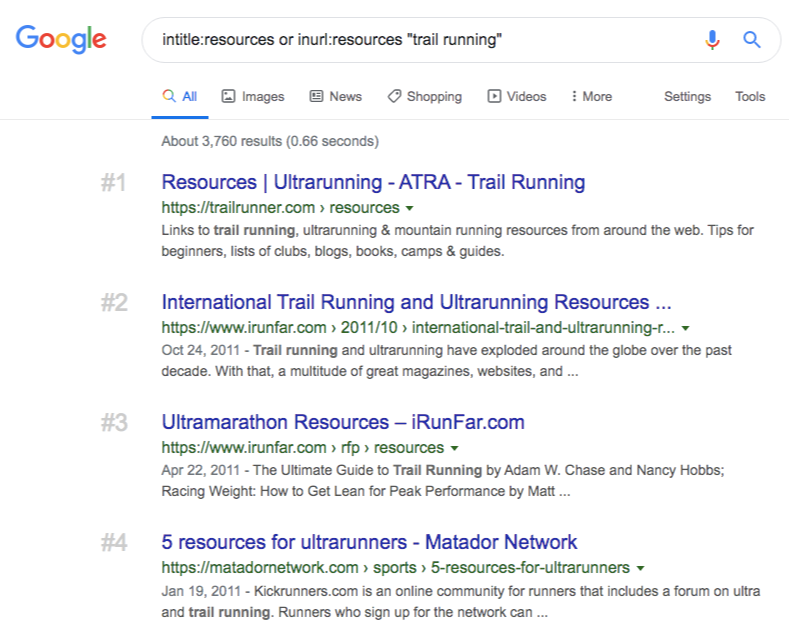

The more specific your search is, the easier for you to filter out irrelevant pages in search results and only qualify those sites that are high quality.
Pro tip: Always check out related verticals while looking for link prospects. This might uncover opportunities that could otherwise be undiscovered. In our example, adding the keywords “fitness resources” or “personal training” resources will help you build a large database of link targets.
How to Speed Up Your Link Prospecting Activity
In this section, I’d like to simplify the process by giving two important link prospecting elements:
- Assets (Internal)
- Opportunities (External)
Assets are web pages you want to build links to and help them rank high on search results using different link acquisition methods. Opportunities are linking partners or sites where you want to place your link.
Below is an asset-opportunity relationship example to help you understand how this simple link prospecting process works:
- Homepage = Directories, Profile Pages, Social Profiles, Partners/Membership Pages, Business Directories
- Ebook = Ebook directories, product review blogs
- Money = Sponsorship sites, grants pages, paid product reviews sites, events
- Blog post = Guest posts, Round-ups
- Team Members = Interviews, Unlinked Brand Mentions
You may notice that the more you understand the link value of your assets, the more you can create a list of linking opportunities targeting a specific content asset.
This can further amplify the reach of each of your assets since you’re building a wide array of link building opportunities that are highly obtainable and relevant to your target page.
Keyword-based link prospecting
Ranking pages
This is the easiest way to get an initial list of link prospects since most of these pre-qualified link targets can come from your client’s contact list or recommendations.
You can widen your list of link prospects by applying the following tips:
-
Search for highly related websites (which should not be your competitors in the space) by doing a Google search using your target keywords and related industry phrases/terms.
-
Get more linking targets from search results by discovering new niche-specific terms closely connected to your link prospecting queries (scan the meta titles/meta descriptions of other content pieces).
-
Find the synonyms of your industry phrases using Thesaurus, Google Docs, and Tilde (~). Use these link query suggestions to discover link targets that may not be targeted by your competitors.
Here’s a video to explain how to apply this link prospecting method:
Link Prospecting [Ranking Pages] from Venchito Tampon on Vimeo.
Link building queries
Link building queries are essential to limit the number of pages appearing in the search results for specific keywords/phrases. Prospecting using link queries is more efficient by combining useful advanced search queries in a single search.
For instance, you have a huge budget for paid link building tactics. You can build high quality backlinks to your homepage by finding sponsorship opportunities where you can donate money in exchange for links.
Using this query: inurl:sponsor OR donate OR partner OR grant + finance, you can find high-valued link targets that offer link placement in exchange for a certain amount of money (ranging from $5 to $50) and are related to the finance niche. These are easy-to-acquire links using different link acquisition methods, such as linker outreach with an incentive approach in the link outreach templates.
Here’s a video to explain this method:
Link Prospecting Using Link Building Queries from Venchito Tampon on Vimeo.
Tools to Speed Up Your Link Prospecting Activity
Here are the link building tools that you can use to ease your link building searches for a specific link building strategy:
- Link Clump
- Notepad
- Ctrl + W
- Excel Files
How to Speed Up Your Link Prospecting Activity from Venchito Tampon on Vimeo.
Note: This is my first time creating video tutorials, so forget all the mistakes I've made in each video.
As I've encountered several resource prospecting campaigns, I always notice little things that make part of it more efficient. Efficient prospecting means producing a highly targeted output with less consumed resources (labor, time, and cost of tools).
That itself requires experience through observation. So, here are four advanced prospecting techniques that hopefully can improve the efficiency of your campaigns and help expand your list of link opportunities.
16 Advanced Link Prospecting Techniques For Increase Efficiency
Agility and efficiency are essential drivers of a successful link prospecting phase.
Setting a plan to never run out of opportunities for link acquisition is important since this can improve the entire campaign's prospecting rate and increase the average number of link prospects collected per hour/day.
By focusing on link prospect growth, link builders can expect significant improvements in the overall link development campaign in parts such as:
- Enables finding new audiences targeted by newly added link opportunities, which can be useful in brainstorming future content assets relevant to these audiences.
- Grows your current list of relationships with bloggers/webmasters/journalists (new connections can be derived by reaching out to an additional list of link opportunities).
- Increases deliverables (# of links delivered every month) for clients since, on a given average conversion rate, one can expect more links by sending more outreach emails to added link opportunities in the original list.
There are many viable guides and how-tos in link prospecting from different SEO experts. Some techniques are learned simply through your own observations from campaigns that you have handled. We at SharpRocket, incorporate those observations from our own personal experiences, which helped us be more productive in building links.
1. Listing down link similarities
Most bloggers use the same terms in creating links for their pages. For example, the commonly used terms in creating a resource page are domain.com/niche-resources; domain.com/resources.php; domain.com/links.html. Therefore, we can use Google queries such as inurl:niche-resources or inurl:links.html. The search engine result will give us a list of resource pages according to the niche we seek. Below are other search queries you can use to find additional prospects for your client which we personally use:
- resources/links
- resource-guide
- useful-links
- useful-resources
- niche-resources
- recommended-resources
Though not all search queries, such as resources.php, links.html, or useful-links, provide resources that are relevant to the client’s industry, it is advisable to add a distinction which is based on the client’s niche to narrow down the results in the Search Engine Results Page (SERP), e.g. inurl:useful-links “niche”. Google will then provide results based on the keyword you used, which is more applicable to your campaign.
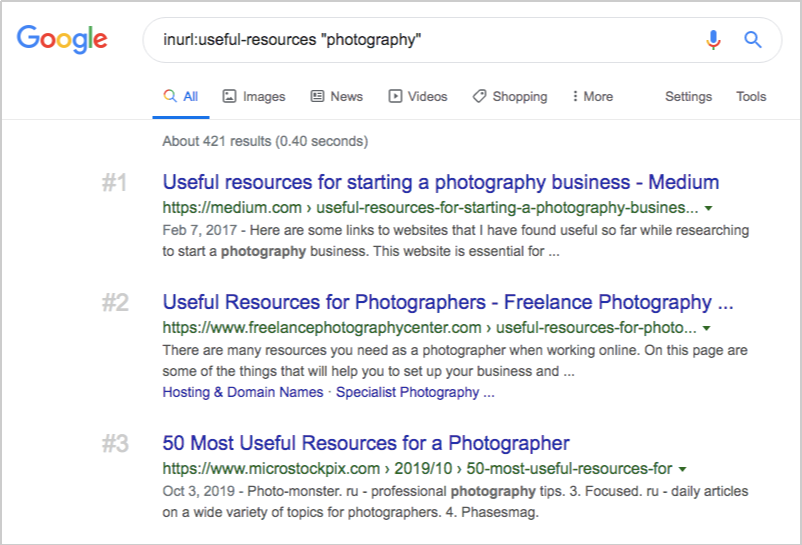

Pro Tip: Just be creative with the words you use, along with being observant. If you have a hunch or an idea that you think can be helpful, it won’t hurt to try experimenting on it. Who knows, you might even be able to discover other useful techniques you can use to further enhance your link building skills. Don’t forget to check out the links on the resource page you found, for it may redirect you to a new prospect opportunity that you have not seen through the list that Google displayed.
2. Utilizing country domain extensions
As you may have noticed, some domains do not always end in .com, .org, or .edu, and other web addresses use different domain extensions depending on the country in which their website is being hosted (e.g. “.au” which is hosted in Australia or “.ca” which is hosted in Canada). You can narrow down the results using these domain extensions based on your preferred country or target audience. You can use the advanced search operator “inurl” followed by the country domain extension you want to focus on (e.g. inurl:.ca). You can also add a distinction to make the search query more precise. If you are looking for guides or resources to enhance your photography skills, you can use inurl:.ca/photography-resources. Google will then give you a list of photography resource pages with the country domain of Canada.
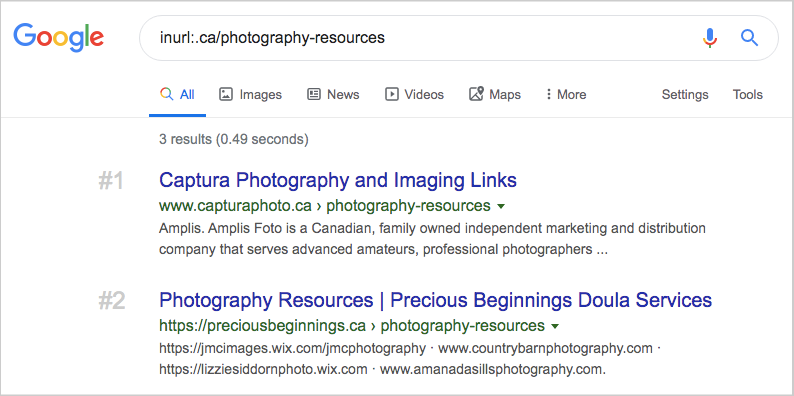

Pro Tip: You can use these techniques in any niche or industry you wish to research on. However, if you don’t have a specific country, you would like to focus on, searching for link targets ending with .com first is recommended because it is the most recognizable and highly used domain extension. You can then use the other country domain extension of your preference to gain new prospect opportunities.
You can visit this Webopedia guide for a complete list of countries and their domain extensions.
3. Identify company blogs through SERPs
By taking notice of the Search Engine Results Page (SERP), we can also pinpoint if the link is a company website or a personal blog. Though not all domain names and punctuation marks are 100% accurate, it can somehow lessen our time checking each link to see if it is a company website. Here are some examples:
![]()
![]()
The above query will display links with the keywords “light” and “bulb” in the article's title. One result has a punctuation mark called a pipe or vertical bar on the page title. It was followed by the domain name “1000Bulbs.com”. Here, we can be sure it is a company website because the page URL was also mentioned in the title.
Clicking the link will redirect you to the webpage.
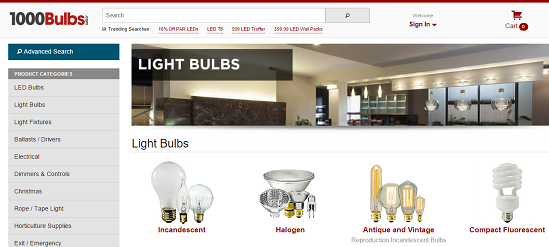

A hyphen or dash is another punctuation mark used in identifying a company website. As you can see, the domain name, the company's brand name, is included in the page title after the hyphen. Most of the time, em dash or the long dash is used.
Lastly, the punctuation mark colon. The difference between this punctuation mark from the hyphen and vertical bar is that you can instantly notice it at the beginning of the page title. The brand name is cited first, followed by the colon and page title of the article.
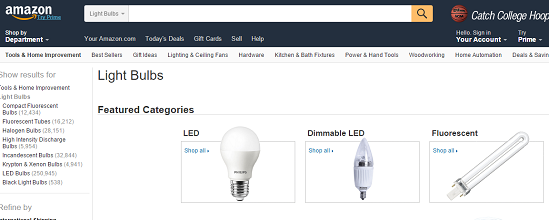

We can distinguish company websites through these punctuation marks on the page title. Just a little note, not all sites that use a hyphen, vertical bar, and colon in the page title are companies. Some content creators tend to do that as well.
Observational learning is a must in link prospecting. It helps us maximize the use of Google queries and lessen our time clicking unnecessary links. Simple terms, domain names, and symbols might have a deeper meaning. This is why we must keep our eyes open and our minds sharp. Noticing terms you don’t usually use but is mentioned in the client’s industry can be used as keywords for broader research. Checking how domain names are created by bloggers can give us a better chance of generating more results. We just have to be adamant about making observation a priority.
4. Website categorization
When starting a new outreach campaign for a client, the first initiative is to scour new link opportunities on the web from scratch. While this is good if it's a new industry you're taking on, isn't it wise to go back to your previous list of industry-relevant opportunities and check which ones could be reused for the new campaign?
Not only does it save time, but it also saves a lot of labor consumption prospecting for links.
Website categorization does help with this. By using tags, you can categorize prospects from a topical perspective.
What you need here is a defined hierarchy of topics to begin with. For me, I recommend BOTW as a starting point, given that they have four or five deeper-level topics, such as Pro-Choice Abortion (Society) and Eating Disorders (Fitness), which is extremely important if you've got clients from a very specific niche.
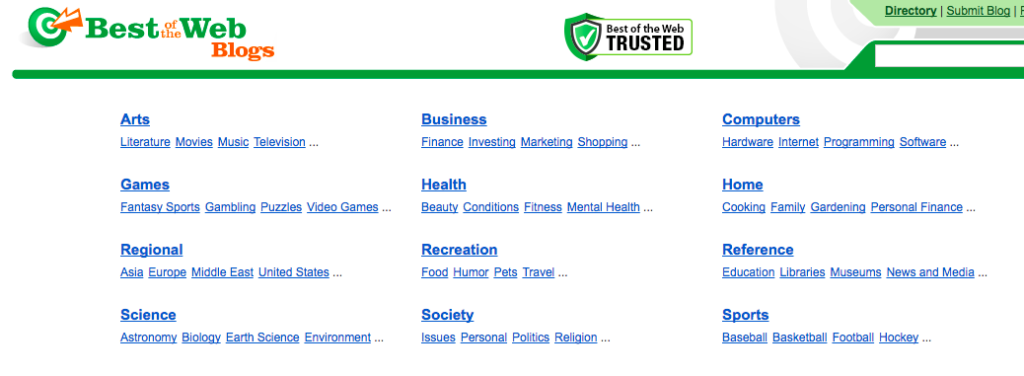

Ensure your team agrees on certain topics to avoid confusion when filtering your list. Having several but similar terms (i.e. I.T, Information Technology, and Technology) as your tags is trouble.
The next time you need automobile blogs, you can pull them off a list within a few minutes.
5. Check descriptions in links to eye SEO'y content
Backlink research is identifying current and potential competitors and getting pages/sites linked to them for link opportunities.
SEOs normally identify these competitors through Google search by checking which pages are currently ranking for target keywords or creating a list of competitors' sites coming from clients (as they already have ideas about which brands to compete with).
While these two approaches are best practices to find your most relevant competitors, you may still miss out on some SEO'y content (as Ross Hudgens coined it) that you should reverse engineer on (reverse engineer backlink profiles).
SEO'y content is pages or content pieces already linked out from a resource page you're trying to reach out to that have earned tons of links from several linking root domains.
Looking for SEO'y content can expand your vertical prospecting, either from a horizontal or vertical perspective, as they aren't easily found through Google search or normal prospecting.
One way to identify this SEO'y content is to check discrepancies in the description of links. What I mean by discrepancies is that there are resource pages with full descriptions for each link, and some with links with unusual descriptions.
I got this idea when I received a response from a webmaster putting a link to our client's page from their resource page.


If you skimmed the email above, you'd notice that there's nothing uncommon with the email; only does it implies that the webmaster is in a hurry not to include a description for our link - the reason she requested that we can create one for them.
Discrepancies in link descriptions—either the description is not complete or not in format with other link descriptions (see image below)—are signs that the resource page had recently given a link to SEO'y content. TigerMobiles.com and US Dish links have Titles as their descriptions, while other links have longer texts that describe what those pages are about.
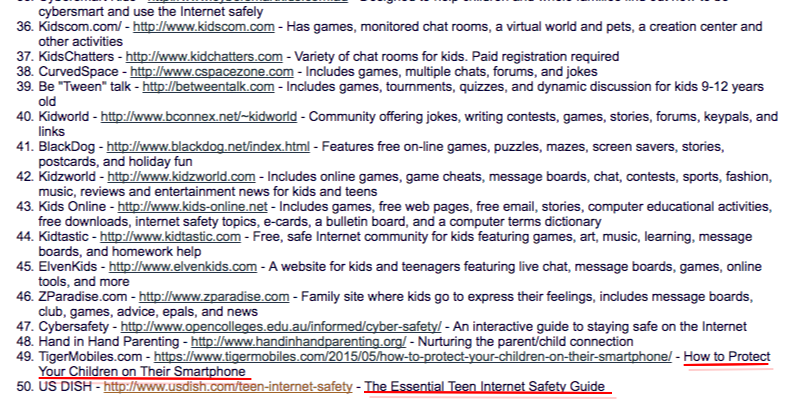

It means that these SEO'y content are actively pursuing relevant link opportunities (primarily resource pages) as you do. If you could scour their existing links (some may have been recently just acquired), it would help you gain link targets that are receptive to content suggestions. Thus, giving you a higher link acquisition rate in your outreach campaign.
Clicking on SEO'y content links and assessing if they have relevant links you can potentially use as link opportunities is a great activity to add to your link prospecting process.
The best way I recommend initially checking if this SEO'y content has a good number of linking root domains is to run them through LinkMiner.
The tool checks all external links on the resource page and highlights how many domains link to a certain external page.
6. Use Linkclump to open document links simultaneously
In link prospecting, the more you spend time checking for unnecessary links, the more you waste time that should've been otherwise spent pursuing the right link opportunities.
What I've noticed with newbie link builders is that they often click on document links (pdfs, words/spreadsheets ready to download, etc.) that consume seconds (if not minutes of their time), which are all useless if your main targets are links or resource pages.
The recommended approach is to use a tool that'll automatically unclick these document links once you start qualifying your list of link targets.
For example, if you have a list of pages ready to be qualified for certain metrics (DA, relevance, obtainability), copy and paste them into an opened tab tool (e.g. URLOpener.com).
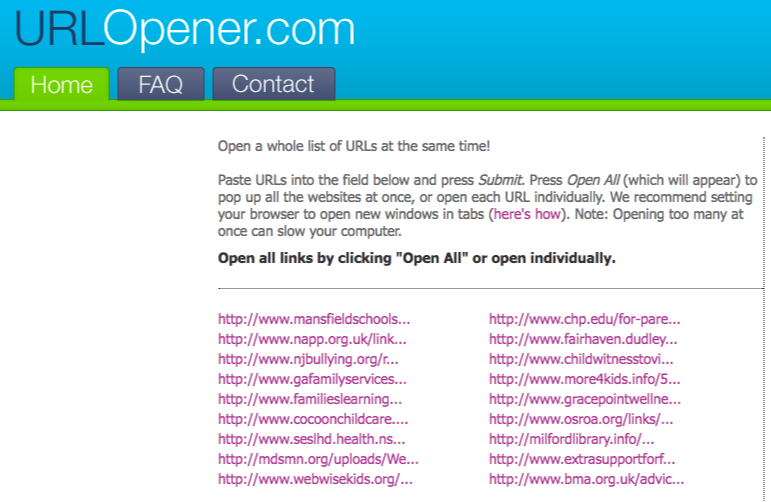

Then install Linkclump and use the filter option to add words that'll exclude links when it opens new tabs (pdf, doc, xls, etc..).
Once you right-click and drag external links from URLOpener, the action won't open document links as new tabs, given that you excluded certain words in the tool's setting.
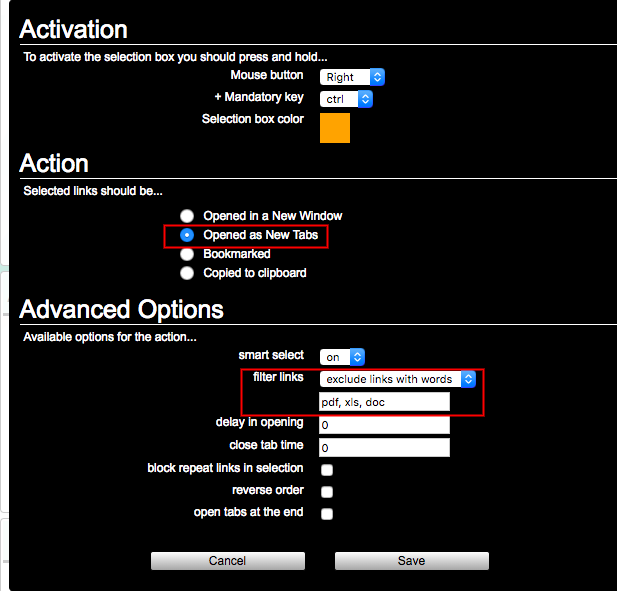
7. Utilize niche phrases to expand link list
If you are familiar with your industry, it's easy to know what phrases are commonly used as titles on resource pages. For example, you'll see many "getting there" pages in the transportation industry. These phrases are only specific and can be applied to a certain vertical.
But one question that may arise here is, what if it's a new niche I'm taking on? How can I identify niche phrases to expand my prospecting approach?
The best way to do that is to collect the titles of your first set of resource pages (I'd recommend getting 80 or 100 links pages from your list for optimal results).
Use Wordcloud to see common niche phrases.
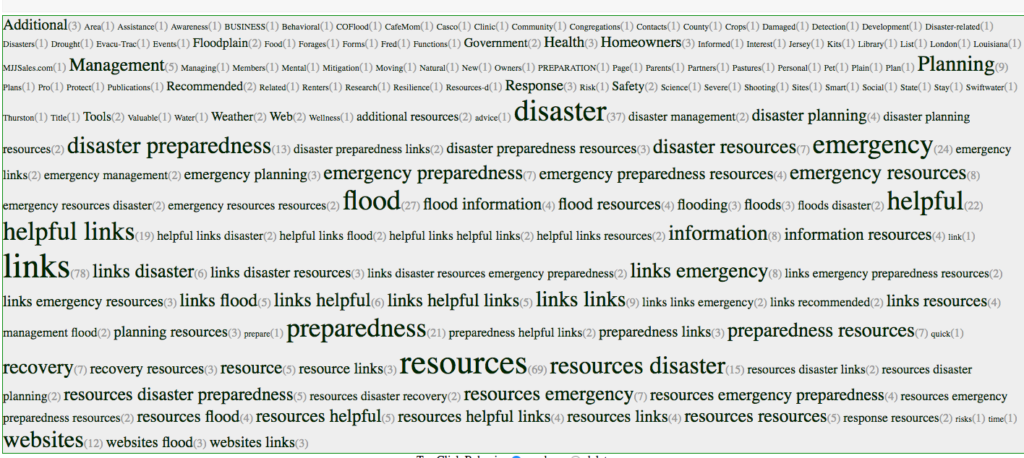

Ensure that you click phrases only and display frequencies checkbox. Phrases only feature does what you need from the tool - to give exact niche phrases while display frequency shows you the number of times a phrase appeared in the list.


If you are clever enough about using niche phrases, your list of link opportunities will expand.
Other Useful Resources:
- 4 Reasons Why You Don't Get Resource Links
- How to Identify and Pursue Linkerati
- How to FuturePoof Your Links By Determining Lifetime Link Value
8. Use better keywords in link search
Research is not “good research” until it is seasoned with all the right keywords. We cannot simply uncover relevant and insightful prospects if we do not employ the correct strategies. Having said that - keyword generation is, in my opinion, the heart of every campaign. After all, how can we ever expect to reach our audience without first wielding a well-thought-out string of words?
To help us navigate the waters of “keyword inception”, let us first return to its root. A keyword is commonly defined as a word or concept of awesome significance. To develop a great blog roster, we need to make sure the phrases we use in research will coincide with those utilized by our target prospects.
Another looser translation of the term is “password”. I very much like decoding a password in relation to finding the most effective words to use for link prospecting. Not unlike our search queries, passwords unlock a bunch of possibilities.
As you probably understand, there are a lot of factors to consider when it comes to choosing your terms. The most commonly used keywords in our industry are categorized under three types: generic, specific, and long tail.
Let’s first take some time to understand these keyword types better before we go on.
A. Generic Keywords


As the term suggests, “generic” keywords are unspecific and all-encompassing. You can expect to get thousands, even millions, of results using this type of keyword. An example is using “food processor” in your search query.
B. Specific Keywords
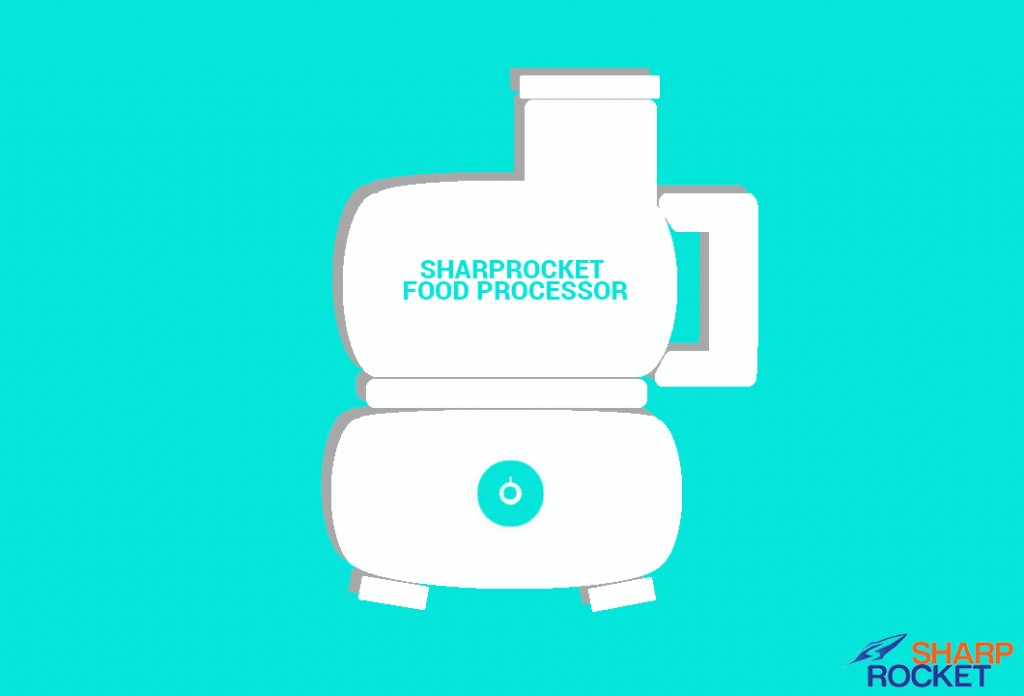

This type of keyword is a lot more particular than the former. In relation to our previous example of “food processor”, a specific example would be a branded version - “SharpRocket Food Processor”
C. Long-tail keywords
Lastly, long-tail keywords are the most common phrases or even complete sentence typed into the search bar. A perfect example for this would be “best way to operate a food processor”. A set of four or more keywords is considered “long tail”.
Returning to this article's main point, how do we develop the best possible keywords and keyword combinations for maximum results? Of course, this leads back to a rather popular answer: common sense.
9. Use "topic" "guide" to search for content competitors
Reverse engineering has been a standard link building practice - spying your competitors for link sources pointing to their pages.
However, that approach will leave you following the footprints of your competitors.
If you can be visible on websites they haven't acquired links from, it would be better to get ahead of them (or evenly outrank them!).
One initiative you can make is to look at other brands (not necessarily your direct competitors) that have published industry guides on similar topics.
We've found that using this search query, "GUIDE" "TOPIC" supplies a list of websites from other industries in SERPs that have topically-relevant content assets.
For example, a quick look for "veterans" "guide" can reveal this search result page.
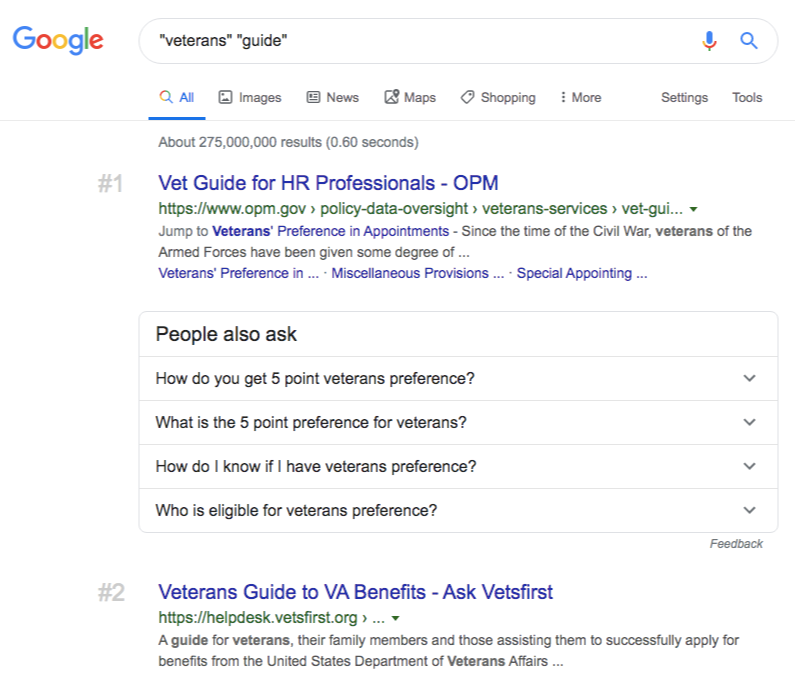

Your next step is to list the people and sites/blogs who have linked to similar industry guides or shared them via social media. You can extract these data using tools like Buzzsumo and Ahrefs.


It is best to list them in a spreadsheet, including each prospect's contact address.
Start reaching out to them. You'll have better chances of getting links given that they're interested in the subject of your content since they've linked to a similar industry guide in the past.
Embracing competitor opportunities
Not all links will be counted with the Google link command. Some pages displayed on SERPs are not all-important or relevant to what you are looking for. Yet checking websites connected to your competitors will give you an idea of where to build your links. It will provide new ideas and broader networks to associate with. You just have to embrace every opportunity that comes your way to get links or a new set of keywords to use, even if these are from your competitor.
10. Keep track of websites with consistent linkable content production
You will not always find a brand that publishes a solid set of content assets while getting/attracting high-valued links to its pages.
If you have found a website that matches the above criteria, it's worthwhile to bookmark it and try to spy and assess its content strategy (both its content creation and promotion approaches).
In our broken link building campaigns, we've spotted and have kept track of all the websites that have continuously been producing heavy linkable assets in different industries.
Regardless of whether or not it is directly competing with our client, we monitor those sites for new content ideas and future linking opportunities.
For example, Affordable Colleges has been on my personal radar because they have been targeting new markets (audiences) through the new content they published in their resource section.
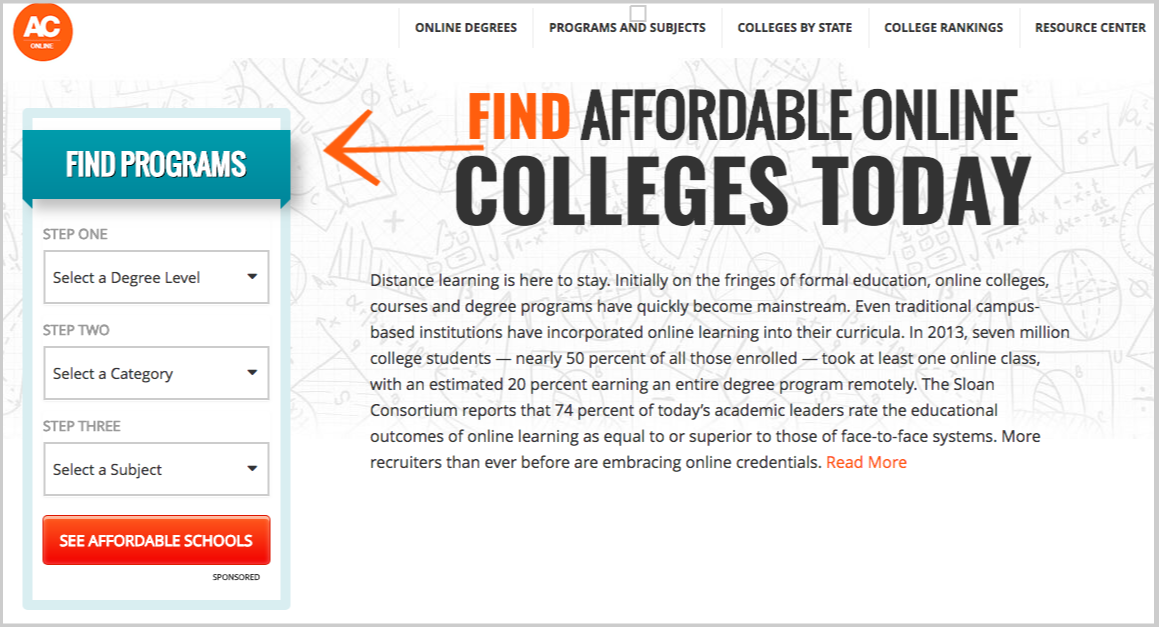

By using content analysis tools like Ahrefs, we can see the new industry guides they've invested heavily in content promotion (check Best by Links Growth feature).
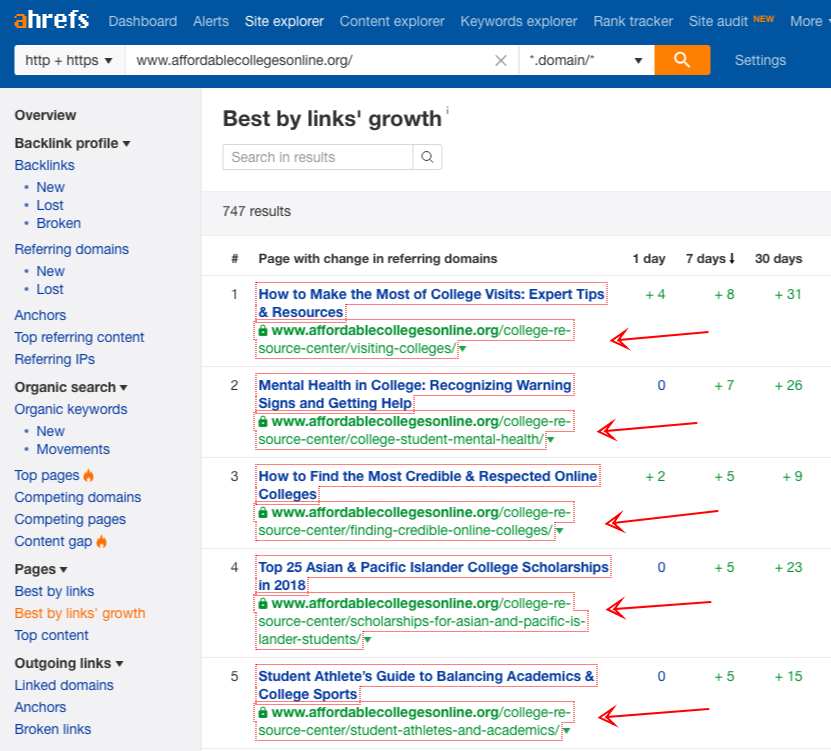

That approach can expand opportunities for our future link development campaigns, given that we can tap into new markets that are not included in our initial list of linkable audiences, such as homeless students and multicultural & diversity groups.
11. Integrate dedicated .edu pages in your search queries
Links from .edu pages are one type of links that can impact your pages' performance on search rankings and can damage your industry's competition if you achieve success with it.
However, before getting results from any .edu link building strategies, you'll always start with .edu link prospecting - one that's hard to build when starting out.
One approach that you can use to scale .edu link prospecting is to target a specific type of .edu page in your search queries.
Those .edu websites normally have sections of information resources such as counseling, health & wellness, financial aid, community resources, and summer housing - which can be individually targeted in your search query depending on the subject of your page/site.
For instance, if you're in the mental health industry, one phrase you can include in search queries is "counseling" or "student health" to come up with the following targeted search queries:
- site:.edu "counseling" inurl:resources
- site:.edu "student health" inurl:resources
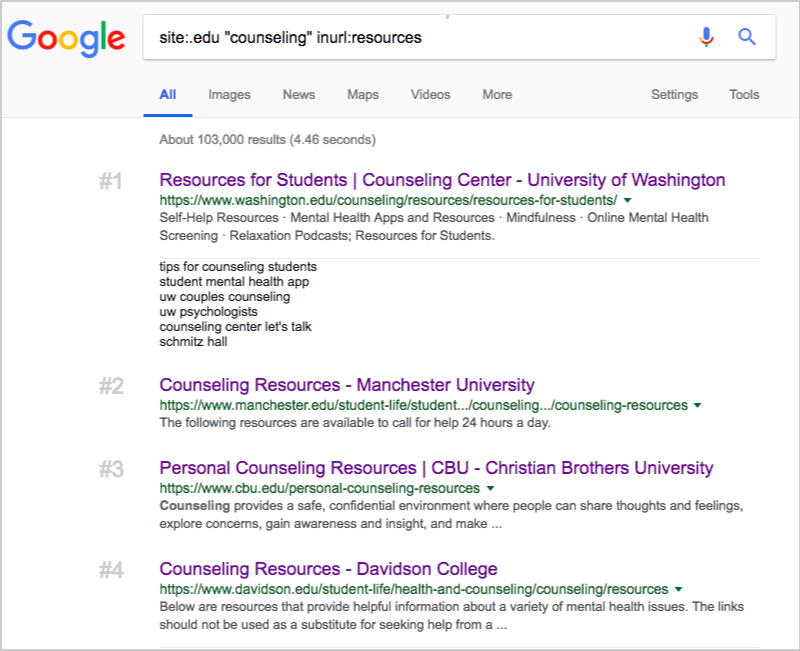

Here are more .edu pages for topical-relevant pages:
- "summer housing" - apartment categories
- "career & internship" - job sites, portals, or resources
- "general health & wellness" - health organizations or niche-specific resource guides (e.g. sexual health)
Moreover, finding targeted pages of .edu sites can also be helpful with the kind of link building strategy you're currently using.
For example, when pursuing scholarship links, instead of using the common search queries like (site:.edu "scholarships" "industry/topic"), you can be more targeted with your search by using the phrase "financial aids" - which is a .edu resource page for students seeking for financial help.
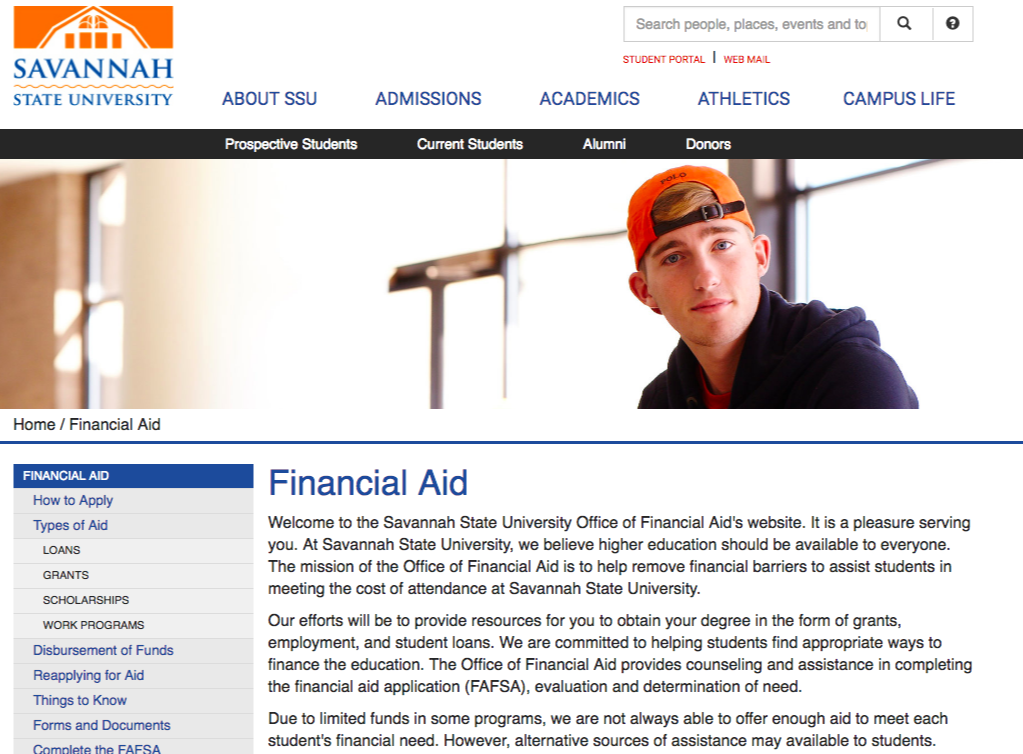
12. Start with libguides queries for .edu link prospects
Another way to be proficient in high-authority link prospecting is to target libguides pages of .edu websites.
What exactly are libguides?
LibGuides are content management and information-sharing system designed specifically for libraries. The platform allows for easy navigation and instruction on core and relevant resources in a particular subject field, class, or assignment.
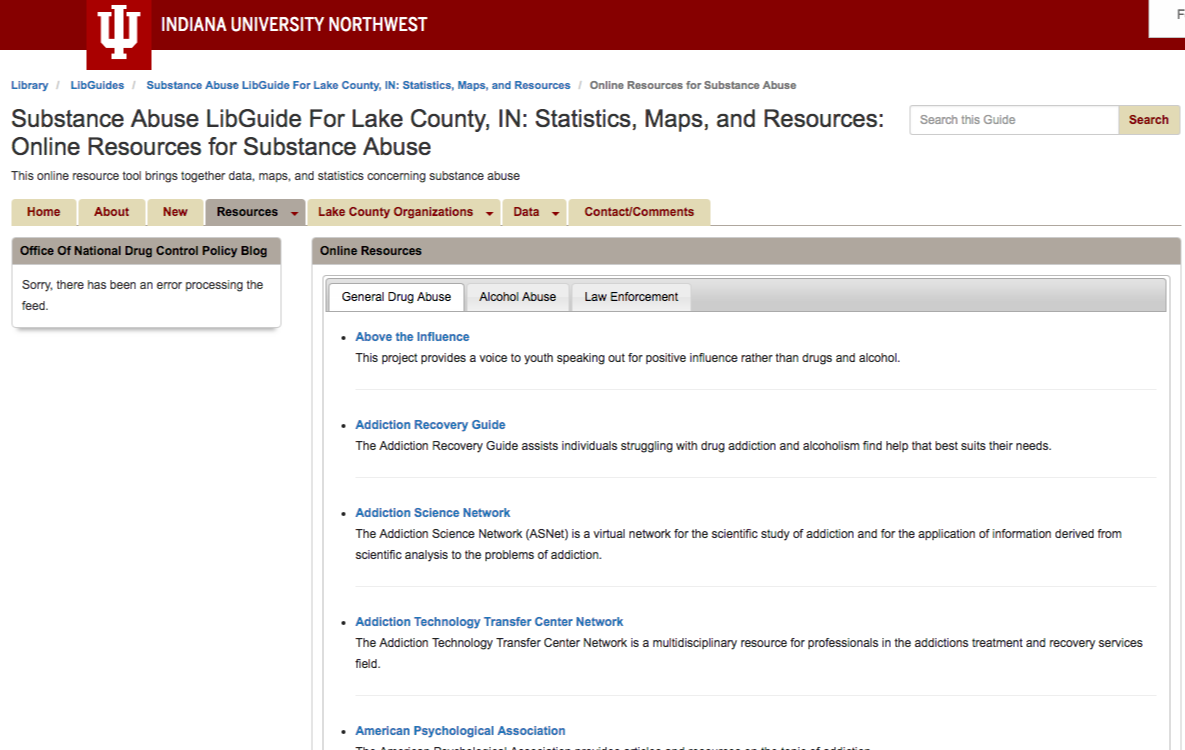

Libguides benefit students in many ways, such as:
- It allows students to focus on the relevant and sift out the less relevant.
- Visually demonstrates that there are great resources, in multiple formats, on even the most difficult topic. That reassurance builds the confidence of students needing to start their research.
You can see the other benefits of libguides to students here.
By definition and purpose, libguides are academic resource pages for students.
Since they aren't updated that much, they usually contain broken links. You can use broken link building to acquire links from these high-value pages.
Resource page link building (or content suggestion) can also work if you have a high-utility content piece worthy of being referenced by these academic pages.
How do you find these libguides?
You can do a Google search for inurl:libguide site:.edu "TOPIC" - replace the word topic with the subject of your content or website.
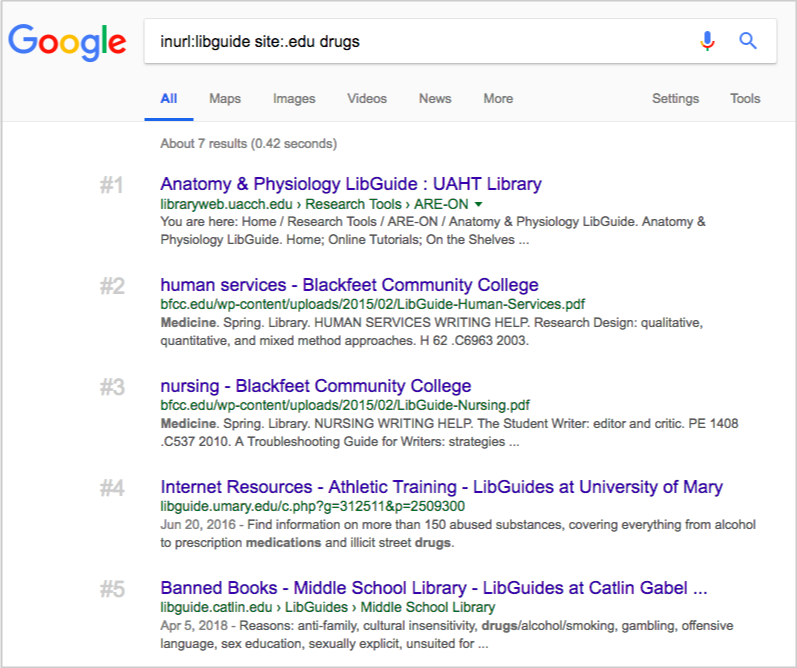

Before pitching to librarians (contact persons managing libguides) with content published on your site/client, it is best to have an idea of what sorts of content, information, and content types they prefer using as references.
Ensure you create the most comprehensive guide on the topic (or at least can match up to the resources they've already linked to). If it's necessary to improve your content, do so to increase your chances of getting links from them.
13. Save link targets of lower metrics
When prospecting for link opportunities, It's easy to overlook pages with lower metrics (i.e. <DA40), given that at the beginning of the campaign, link metrics have been set to use as a quality benchmark for all target pages/sites moving forward.
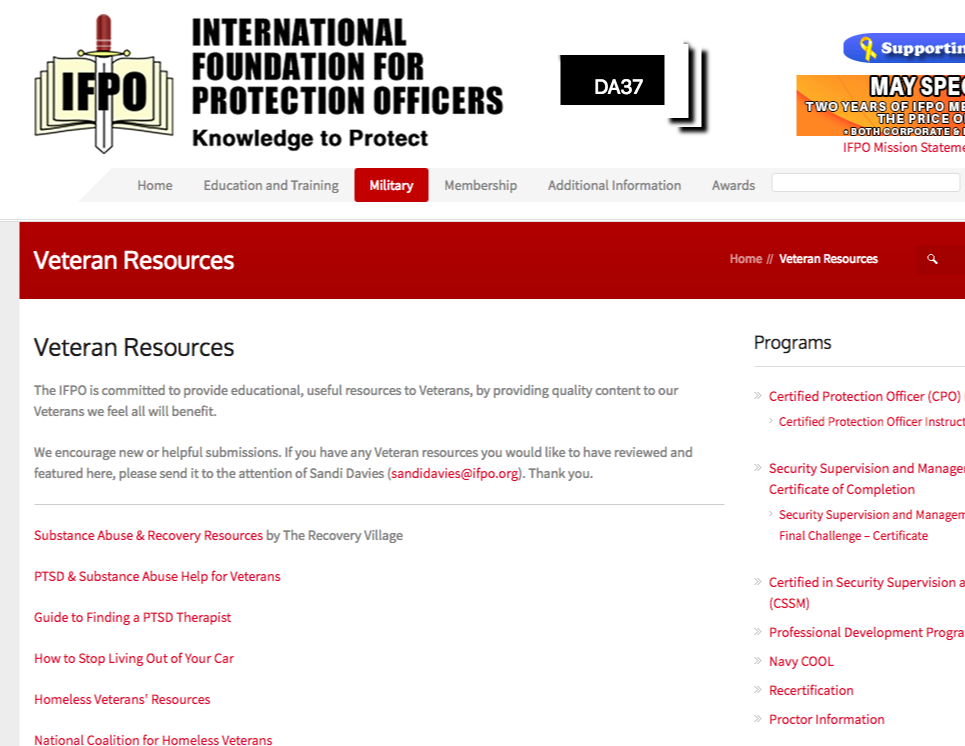

At SharpRocket, we've found that websites/blogs with lower metrics can be highly useful for future campaigns. Some less authoritative websites can increase their organic traffic and earn/build links over time, eventually improving their domain authority.
Capitalize future equities of those neglected websites by making a separate list or spreadsheet to include them.
This is an approach not to run off our link prospects, as you can return to your list repeatedly and find new ones that have improved their domain authority (or have passed to your benchmark metrics).
14. Exchange contacts with active guest bloggers
Building relationships with industry bloggers is vital not only when pitching them to become a guest contributors for their publications but also in expanding your own list of link opportunities.
One approach you can maximize in this situation is passing on your contacts with them. Share your own lists of blogs to which you have pursued content contributions.
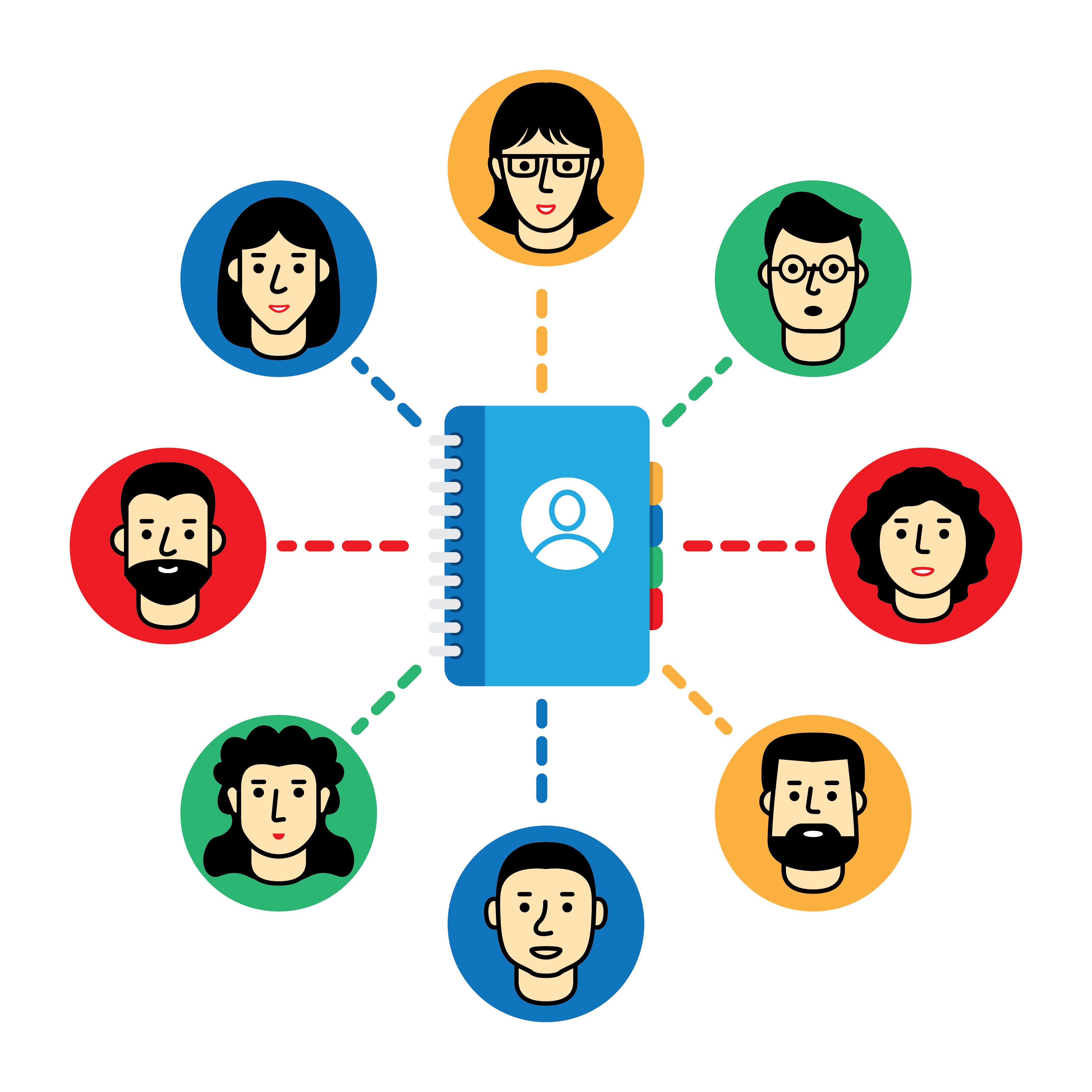

15. Reverse engineer broken pages for more link opportunities
A huge number of broken links on the web is the main backbone of broken link building.
Finding defunct links on a resource page and showing them to webmasters is one way to initiate conversations and eventually acquire links by suggesting link replacements (wherein one of the links is a link to the client's content piece).
The process ultimately starts with prospecting for relevant resource pages.
One prospecting methodology besides doing a Google search for common resource page queries - inurl:resources "topic;; inurl:links "topic" is finding other resource pages that are linking to broken links.
Start this process by finding broken URLs, which can be defunct links you've initially corrected in your first set of prospects (resource pages).
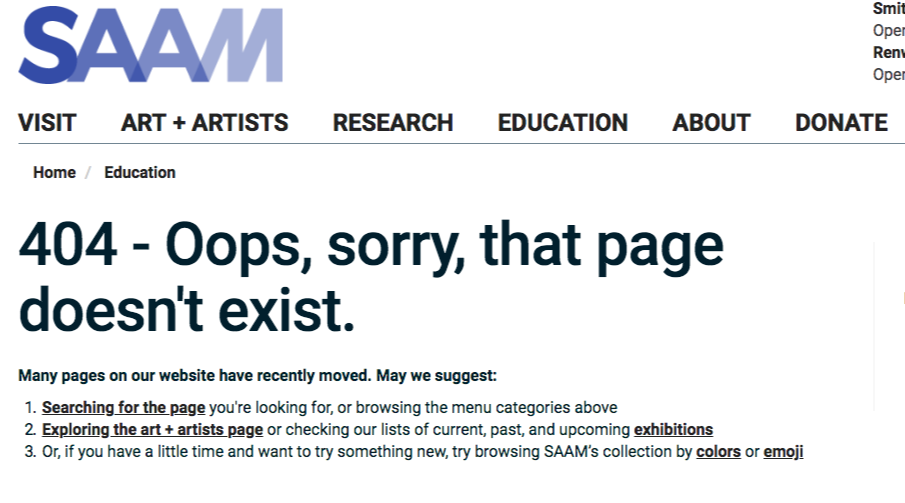



Create a spreadsheet to collect all websites linking to broken pages.
If you've found 20 broken links and have checked that around 300 pages are linking to them, your initial list has now grown to an additional 300 prospects.
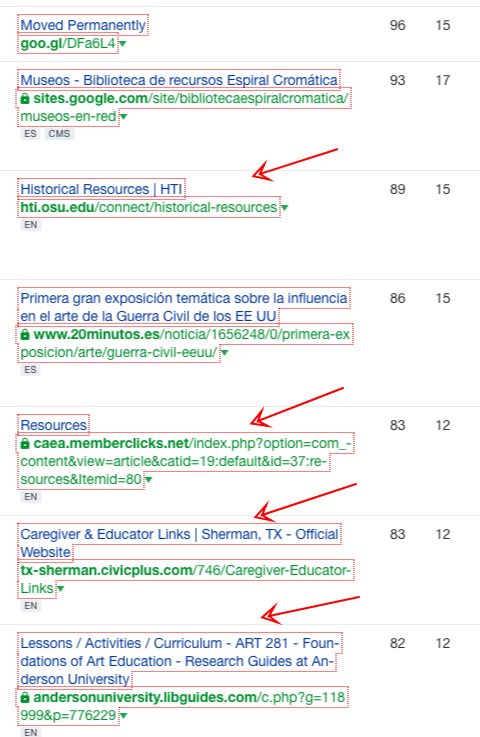

Of course, you must quality these additional link targets by relevance, authority, and obtainability.
But overall, the said link prospecting (reverse engineering) methodology gives you room for more link opportunities.
16. Create new lists for non-intended audiences
One common mistake I've seen link builders do when prospecting link opportunities, specifically for resource pages, is ignoring current pages on their tabs as soon as they quickly find that these pages do not pass certain links' standards (e.g. irrelevant to their intended audience).
This tip resembles the above prospecting principle (save prospects of lower metrics).
However, in this last prospecting tip, I'd like to highlight saving prospects of different intended audiences.
When you've landed on a page and found out that it's not relevant to your audience targeting, you ignore it and move on to your next link prospect.
What I personally see a lot of value in seeking more link opportunities (and for content generation, in general) is creating a new tab/list of other pages that don't fit my current intended audience.
For example, when I'm looking for parenting-targeted resource pages and have come across pages targeted to non-intended audiences like LGBTQ, mental health enthusiasts, persons suffering from trauma, stress, and attempting suicide - I make new lists to collect them all.
This can make it easier to find new audiences to target for future content assets.
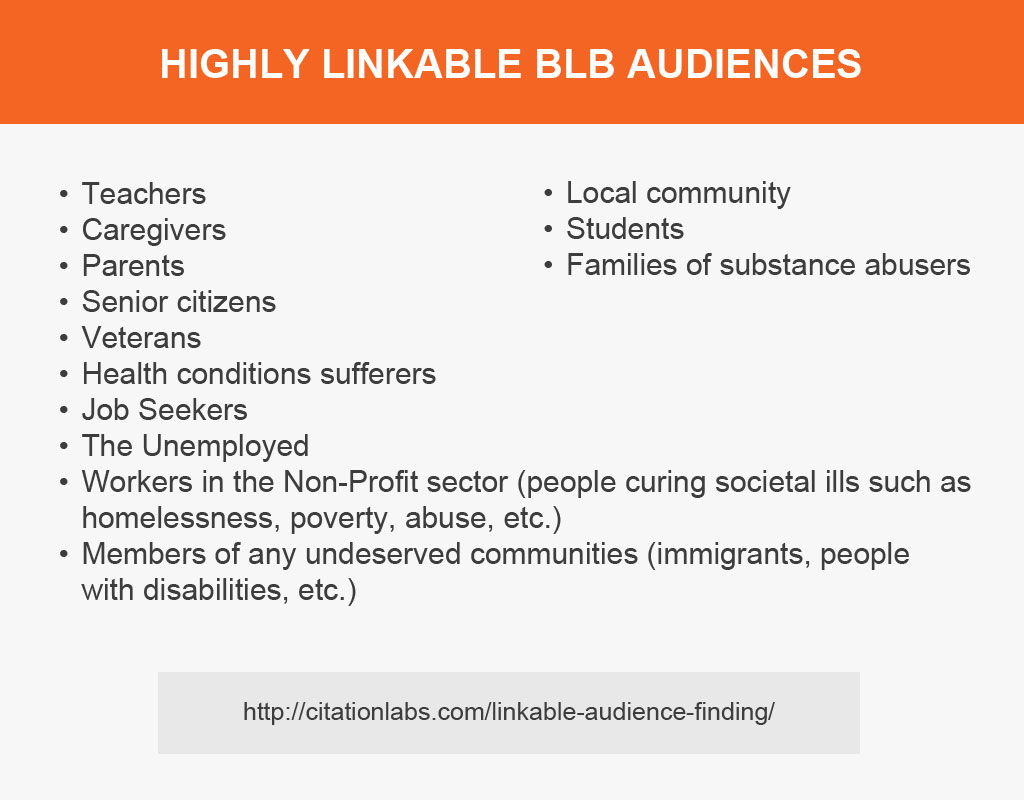

If you’re just starting in audience-first link building campaigns, you can start off with Garrett French's 601 Audience spreadsheet and basic linkable audiences as a base - and add more to it along the way.
17. Utilize the advanced search operator "links"
“Links:” search operator points out web pages that are linked to the domain you used. SERPs will, however, give you random results from their internal links and even web ranking review. That’s why we have to be selective.
HOW TO USE GOOGLE COMMAND “LINKS:”
1. Target a specific competitor link you want to use. For example, you are looking for a resource page and see erickimphotography.com as one of your competitors. Go to the Google search box and key in the search operator + the competitor's domain name.


Note: Make sure that there is no space after the colon.
2. Choose a URL in the search engine results page that you think can be a possible prospect.
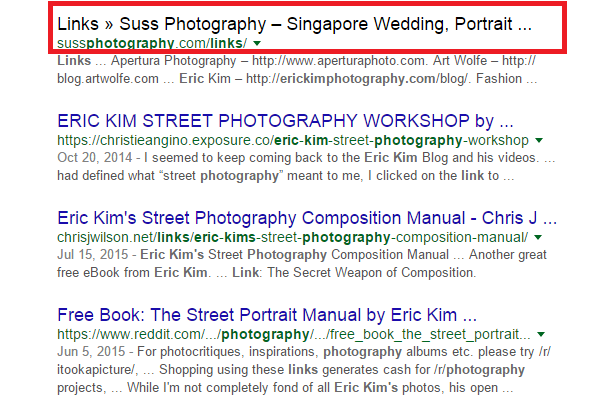

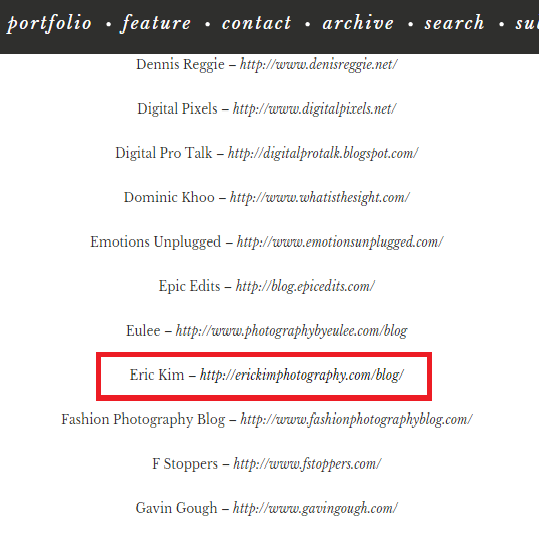

Three C's to remember in creating keywords for link prospecting
When we research, we sometimes write words based on how we formulated them in our mind and failed to simplify terms, then find ourselves easily falling into the same thinking pattern. Before we jump to the tips link builders can apply to find new niches to tap or keywords to use, below are things to consider when typing in the keywords you will use for blog research:
1. CONCISENESS
We can use short words and to the point as a substitute for lengthy words without changing their meaning.
Wordy: Newly Developed or Most Common
Concise: Trending or Popular
2. CONCRETENESS
Choose words that form a sharp and clean meaning to eliminate confusion as to what you are really looking for.
General: My first Investment
Concrete: My First Car Investment (stocks, bonds,house,equipment, bags etc)
3. CLARITY
Choose precise, concrete and familiar words.
Familiar words: coupon
Pretentious Words: statement of due interest
Advantages and Disadvantages of Using the Search Operator "links"
Pros:
- Since your competitors are already linking to those websites, there is a great chance that the site or blog post is relevant to your industry.
- Websites on the search engine results page will give you other niches to tap as you visit them.
- Usage of “links:” operator is easy and convenient, unlike when using backlink checker tools.
Cons:
- There is a chance that you can’t find a related topic connected to your industry to link from because your competitor already beat you to it.
- In checking for competitor links, you follow the blueprint instead of standing out. Being number one sometimes requires looking for other websites that are competitor-link-free!
- Not all websites linking to your competitor are based on their preference. Sometimes, a blogger links to another blogger or a company just because they know the person who owns it.
18. Unleash keyword creativity
Lateral thinking is a technique that uses an uncommon approach to solve problems or to stir up fresh ideas. Yes, being concise is one smart way to generate keywords for our research. However, in developing link building tactics, one must dare to think outside the box to come up with new niches to tap or keywords to use.


1. Who will benefit?
Ask yourself who would be interested in the products and services you or your client has to offer, then list them down. We may review the possible prospects according to their age, gender, and needs. Think of other potential customers and readers. Let’s say you’re selling skincare products, and you want to advertise these. You automatically look for beauty bloggers. Aside from the obvious people who might benefit from what you have to offer, try going beyond, like mommy blogs, health blogs, and senior blogs.
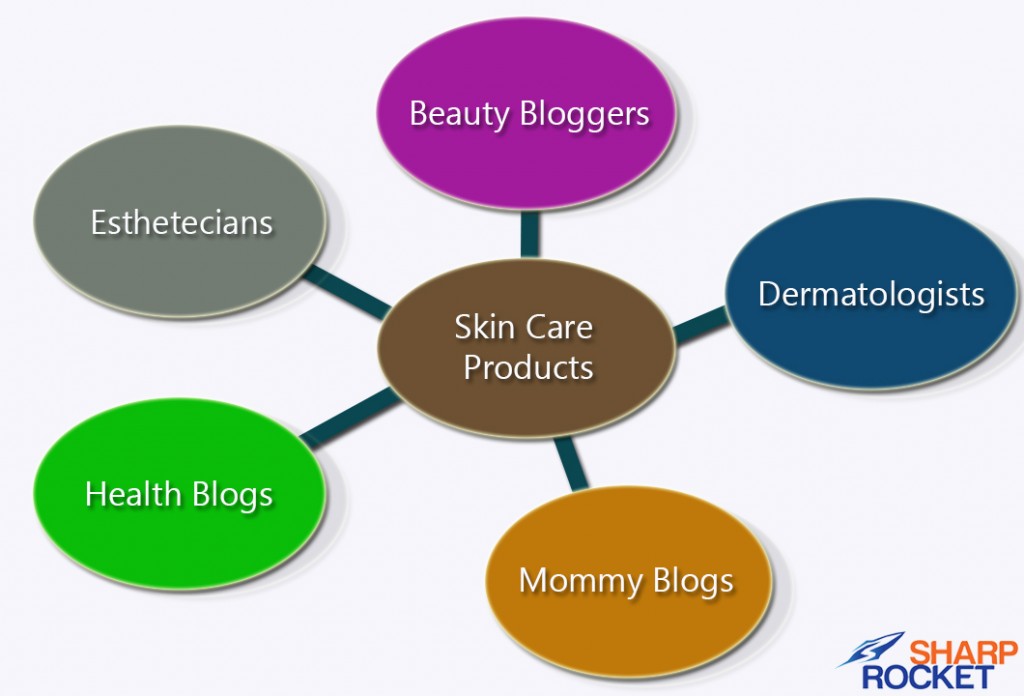

2. Who are the experts?
You may also consider people who are experts on your particular topic. In our example, we may search for dermatologists and estheticians specializing in skin care.
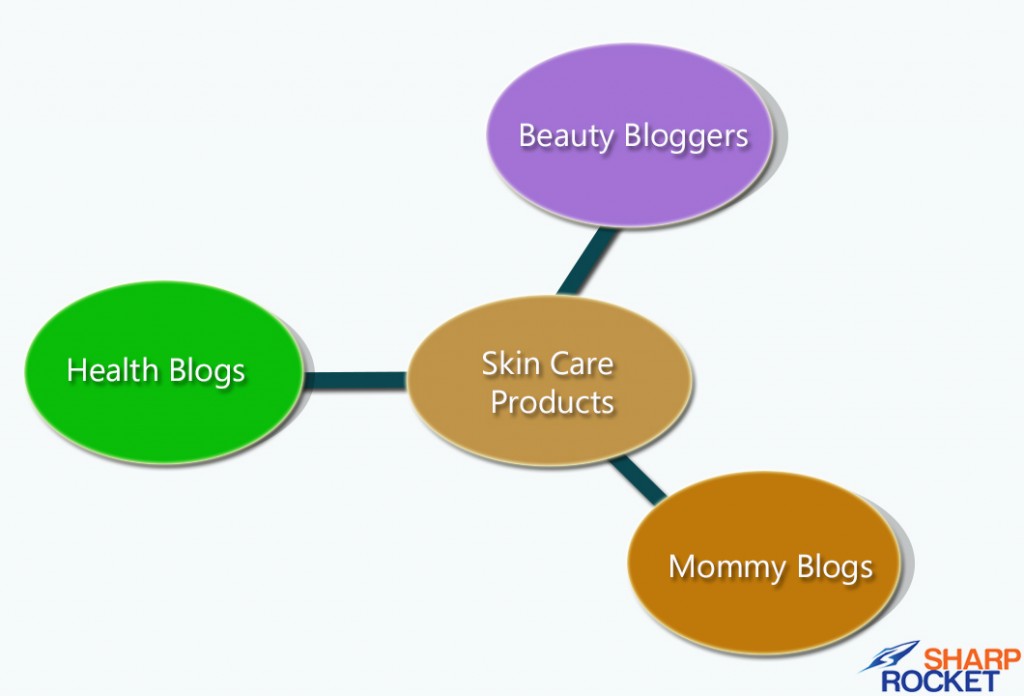

3. What are the problems encountered by a niche?
Sometimes you finally use all the tricks up your sleeve and catch yourself at a loss for thinking of new keywords to use. You can then try searching for the problems encountered by a certain niche. There are many terms or jargon associated with skin problems that only those knowledgeable in that field or those already experienced it know of.
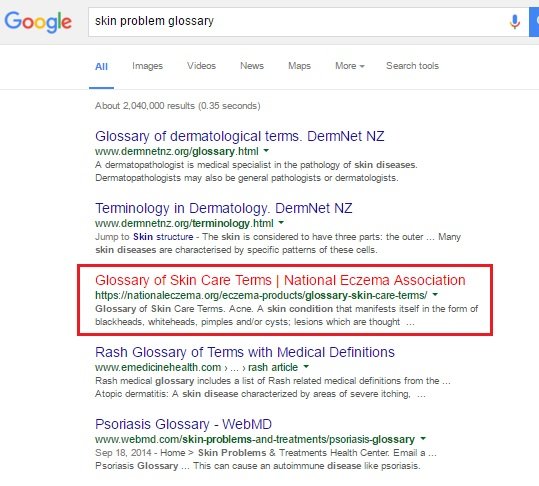

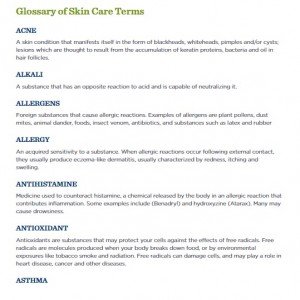

Website: https://nationaleczema.org/eczema-products/glossary-skin-care-terms/
Tools to help you come up with better keywords in link search
A. Thesaurus
The most obvious way to come up with a fresh set of keywords is by using the thesaurus. This tool was undoubtedly introduced to all of us way before we started messing around with computers. Simply put, it gives you a little index of words in groups of synonyms and related concepts.
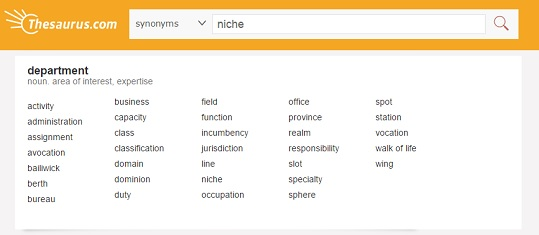

B. Industry glossary
The Glossary of Industry Terms is a comprehensive list of words and expressions used by experts or trade specialists that may be difficult for others to comprehend. When you’re targeting bloggers who write specifically about your client’s niche, the most useful thing you could do is familiarize yourself with their jargon to come up with accurate results.
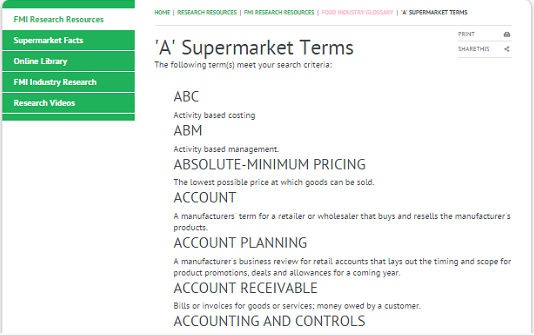

C. Blog post titles and URLs
Sometimes the greatest things in life are right in front of you. The same holds true for keyword generation. The best ones may just be under your nose. Monitor how bloggers construct their post titles and what words appear in their URLs. This might be useful when you want to target articles that tackle the same topics or have roughly the same content. Using the same keywords but coming at it from different angles might just make the biggest difference to your research.
Case in Point: Instead of just using “online shopping” as your keywords, consider a different perspective - “pros and cons of online shopping”, “advantages of online shopping”, etc.
Sample Search Queries:
- allintitle:pros and cons of online shopping
- inurl:pros-and-cons-of-online-shopping
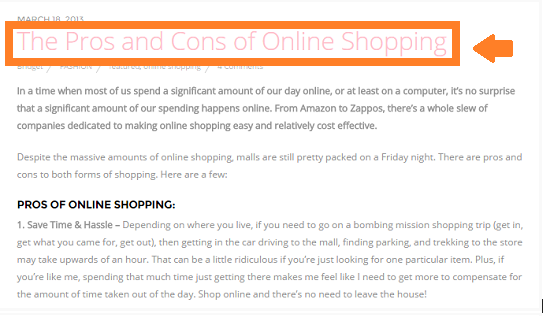

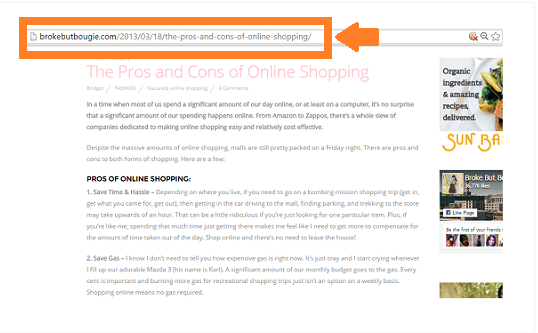

D. Wh and H Question Words
Since we’re on the subject of words, it’s also advisable to scrutinize the kind of language content writers commonly use. Some bloggers endeavor to answer the biggest questions about their niche with their posts. Incorporating the Wh (who, what, when, where, why) and H (how) question words in your queries will help you discover who those bloggers happen to be.
Getting links from these kinds of pages can be quite advantageous as many potential customers tend to look for these types of informative articles before actually making a decision. Having your product or service presented to readers immediately as a suggestion can drive valuable traffic to your website.
Example: “What can you do with a food processor?”
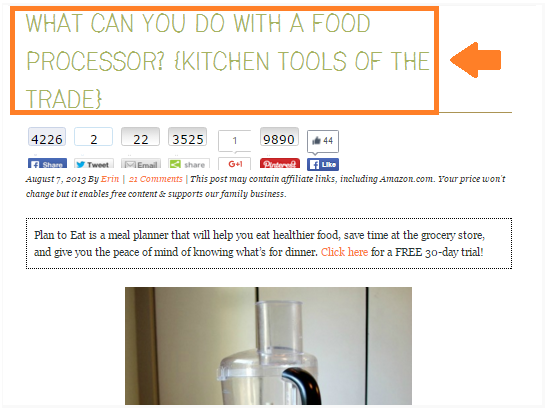

E. Be open to search suggestions
What’s easy is not necessarily wrong. For other possible keywords, simply check other Google searches related to your query. A list of phrases can be found below the Search Engine Results Page (SERP) whenever you do a Google search. Though not all of these can be helpful all the time, we stumble upon a few golden nuggets occasionally.
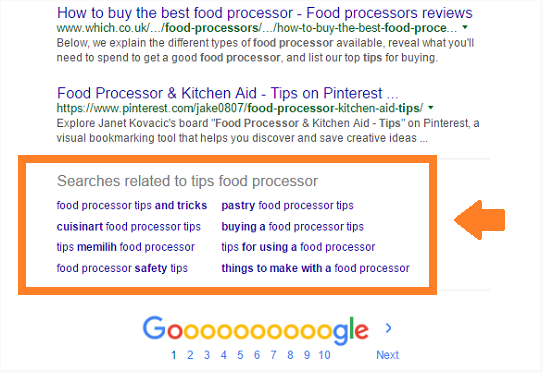

F. Think outside the box
Don’t restrict yourself to just one set of keywords. If you’ve exhausted all concepts directly related to your client’s niche, try looking at the bigger picture. Don’t always work from the outside going in. Try the opposite.
If your client specializes in leather belts, don’t get stuck on keywords like “buckles”, “straps”, and “tongues”. Instead, visualize the belt as a little island in the middle of the ocean. The ocean symbolizes what niche encompasses your client’s (e.g. fashion). Look for possibilities outside of what has been handed to you.


G. Finding opportunities in mistakes
Ever notice how people dwell on another person’s faults rather than his successes? Well, the same thinking can be used for our benefit regarding blog prospecting. Articles that focus on mistakes, misconceptions, or myths people believe about certain issues or topics may sound negative but can present real possibilities for building links.
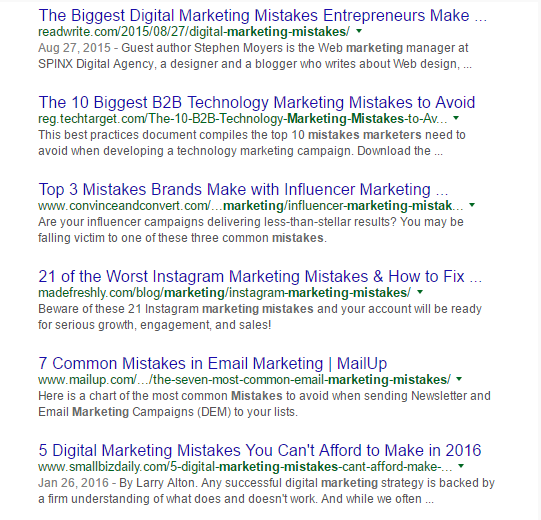

H. LSI graph / LSI keyword generator
The Latent Semantic Indexing (LSI) Keyword Generator is a tool that comes up with a list of terms and phrases related to your current keyword in seconds.
“In a nutshell, they are keywords that are semantically linked to your main keyword. In practical terms, Google has confirmed that by using more LSI keywords, your page will typically rank better.”
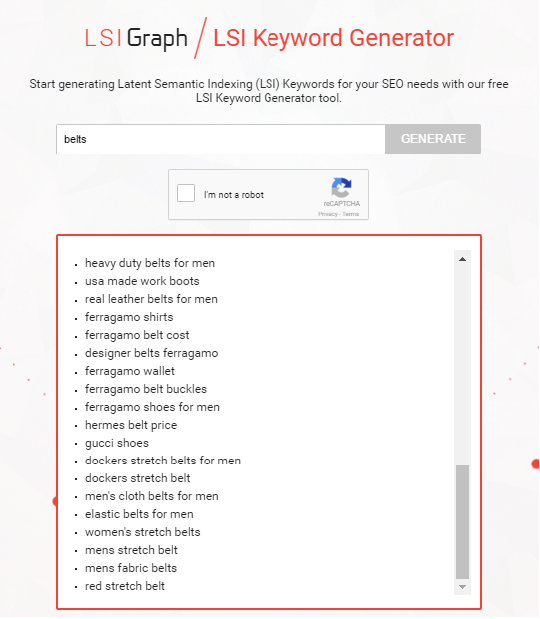

I. Keyword Planner
Keyword Planner is a Google AdWords tool that can be used by new and experienced marketers for free. According to Google itself, “Keyword Planner is like a workshop for building new Search Network campaigns or expanding existing ones. You can search for keyword and ad group ideas, get historical statistics, see how a list of keywords might perform, and even create a new keyword list by multiplying several keywords together.”
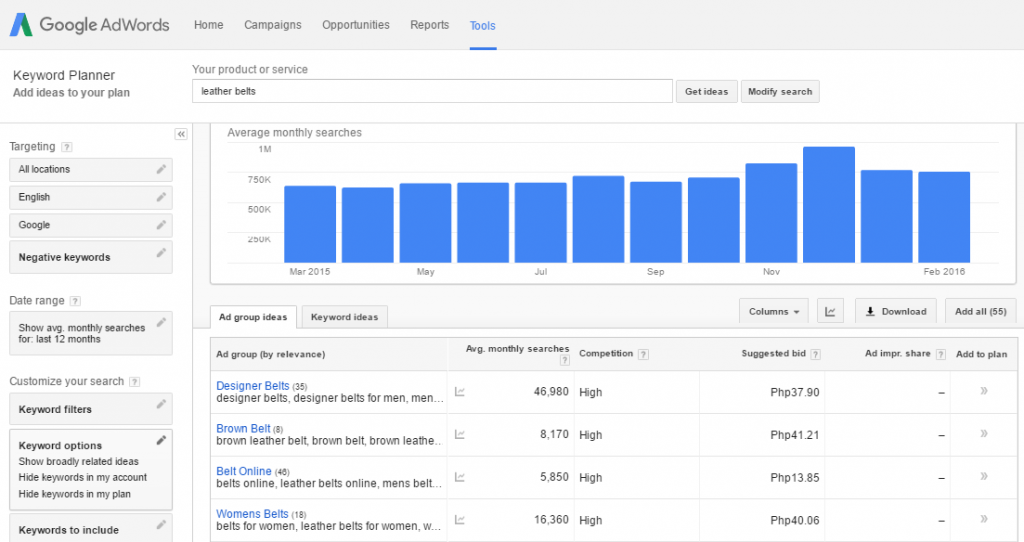

Liked this post? Subscribe to our newsletter and follow me on Twitter @venchito14.
Link Prospecting Frequently Asked Questions
What is prospecting in SEO?
SEO prospecting is crucial to acquiring clients, as it establishes a pool of potential customers, targets the right accounts, and positions an agency as a trusted advisor. Effective prospecting saves valuable time, money, and resources. Without it, your efforts may go to waste.
How do I find prospects for link building?
To find prospects for link building, a useful tool is Semrush's Link Building Tool. Simply open the tool, click "Create project," and enter your domain and project name. Although optional, naming your project helps with the organization when running multiple campaigns. Utilize this tool to identify potential prospects for effective link building strategies.
What is the link strategy?
A link strategy refers to the practice of utilizing link building techniques to improve search engine visibility. It involves building one-way hyperlinks, or backlinks, to a website. Effective strategies include content marketing, useful tool development, email outreach, broken link building, and public relations. A well-rounded link strategy can enhance a website's online presence and organic search rankings.
How to Build Edu Backlinks Using Scholarships (Without Spending a Penny)
If you've been in the SEO industry for years, you know how important it is to scale link building to help multiple clients rank in search for their respective keywords.
Given that almost every year, there are new link building strategies being created, the best way to be on top of the game is not to think of new strategies (since mostly they're just revised versions of old ones) but to create scalable processes for your link building campaigns.
What is an edu backlink?
An EDU backlink refers to a link from a .edu domain, representing educational institutions like schools and universities. These backlinks carry authority and can improve a website's credibility and search engine rankings. Creating quality content and building relationships with educational websites can help obtain valuable EDU backlinks.
In this post, I will walk you through one scalable strategy we've tested internally that can give significant results to your website: building .edu links using scholarships.
It's amazing because we hadn't spent a single penny when we built 14 .edu links in two months.
Want to learn how?
Keep reading:
How to Build Edu Backlinks Using Scholarships
Step 1: Target Relevant Niches
Audience targeting is not only necessary when executing common link building strategies like broken link building and guest blogging.
Even when you build .edu backlinks, you must know your target audience that is highly relevant to your website or client.
Here's how to make it simple.
Identify an audience of students who'd be interested in your scholarship program.
With our link building services, for example, we focus our scholarship efforts on students majoring in marketing, business, and advertising courses because we've found them to be more relevant to our website.
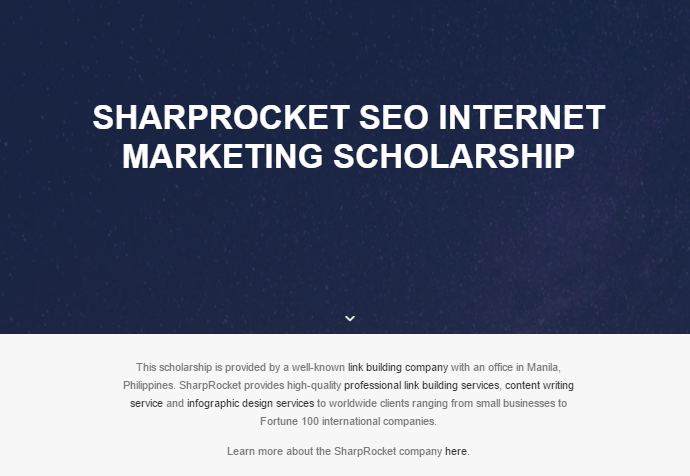

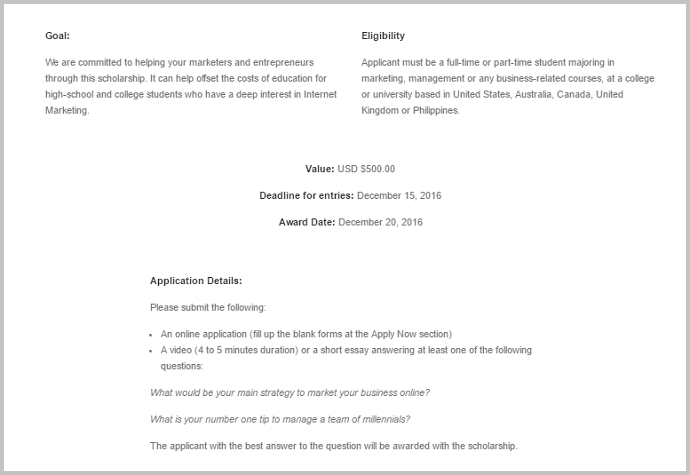

This is critical because if you got backlinks from .edu pages that are too far from your industry, they would be less valuable to your website. I'm not saying that generic .edu links aren't good enough, they are, of course, but if you can get a high-quality link from a much more relevant page, that would be better.
Here are a few examples of audiences you can target for scholarships:
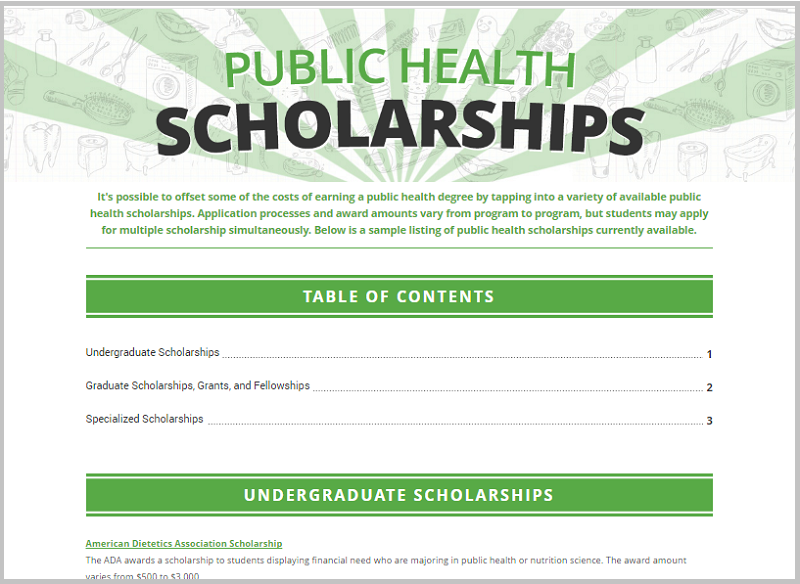

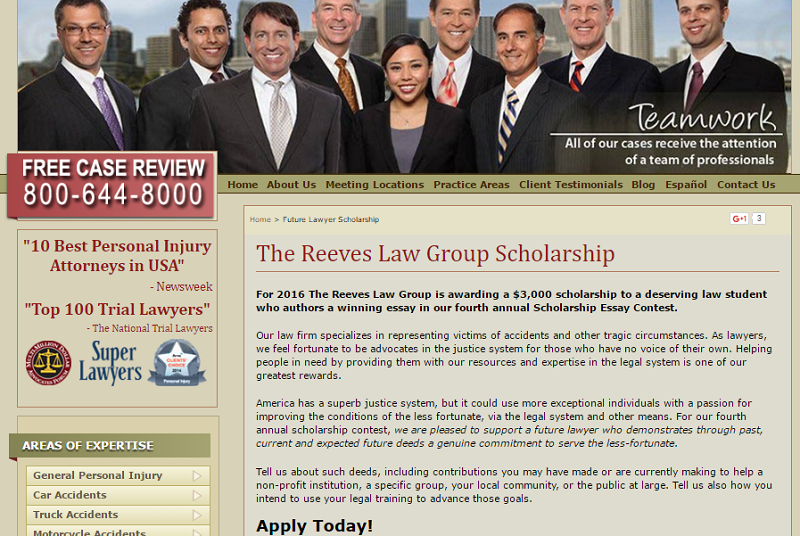

Step 2: Create a Scholarship Page
It's very simple to create this type of content.
However, you've got to have the important details.
Here are a few pieces of information you must include on your scholarship page.
1. COMPANY DESCRIPTION
Provide a short description of your company. This is actually where your whole domain will mostly get value from.
Internally link to your homepage or other important pages to pass link juice to these pages.
Here's a quick example of what I did for our link building company site.
[internal-links-scholarship]
2. ELIGIBILITY
The more specific you are when stating who will be your target applicants, the better you'll get responses from university and college staff members.
These are the necessary details you need to include in the eligibility section:
- Full-time or part-time students?
- Specific and relevant courses for students
- Upcoming college students (high school), undergraduate or graduate?
- Target country (if it is within a city or local, make sure it is stated).
See this example:
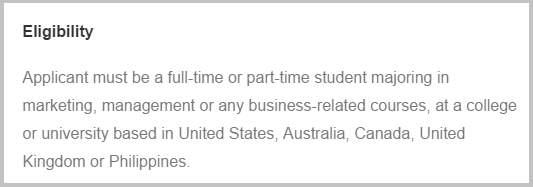

3. AMOUNT VALUE
The scholarship amount depends on your client's budget or your website. But I'd prefer the minimum to be $1000. Any amount lower than that won't be attractive to educational institutions. I've seen a $300 scholarship program, not sure how it went.
4. APPLICATION DETAILS
This section should include how your applicants can get the scholarship. This could be a submission of a written or video-based answer to a question related to the industry.
For example, we've asked our applicants to submit a short essay or a 4 to 5-minute video answering any of these questions:
What would be your main strategy to market your business online?
What is your number one tip to manage a team of millennials?
Alongside the application process, you should also state the deadline and award dates.
To make the application much easier, provide a contact form at the end of your page so they can attach and send their requirements immediately.
Step 3: Prospect for EDU Backlink Opportunities
Not all educational websites have relevant scholarship listing opportunities you could get links from.
When finding those link targets, I use two methods to find opportunities that best fit my scholarship page.
METHOD 1: USING SEARCH ENGINE OPERATORS TO FIND OPPORTUNITIES
Search engine operators are useful to help you seek possible link sources straight from search engines – Google, Yahoo, and Bing.
Combining appropriate search operators with proper keywords can filter the right prospects, enabling you to do link research much faster.
I use different search phrases I've collected and listed in a spreadsheet to find .edu link sources with scholarship pages.


This is pretty handy as you can hand over this task to a virtual assistant, freelancer, or your in-house SEO specialist (thanks to Jayson Bagio!).
What you are looking for in a scholarship page are two things:
- Solely list down relevant scholarship links or has a specific section that caters to your audience (i.e. a generic scholarship listing page with marketing external scholarship links).
- Has linked mentions of your scholarships (you want to get the most value from your effort, of course – so make sure they provide external links).
With this strategy, you don't have to worry about domain authority, Ahrefs rank, or other metrics you are using to qualify link opportunities since most .edu websites are within the range of DA40 to DA90.
You should also ensure that external links point to individual scholarship pages, not just to scholarship search engines or websites solely for scholarships.
METHOD 2: REVERSE ENGINEER A SIMILAR SCHOLARSHIP PAGE
If you run out of .edu scholarship listing opportunities, another way to expand your link list is to reverse engineer scholarship pages with edu referring pages.
You can use Ahrefs to plug in a similar scholarship page (which you can simply search in Google for the "keyword" "scholarship").
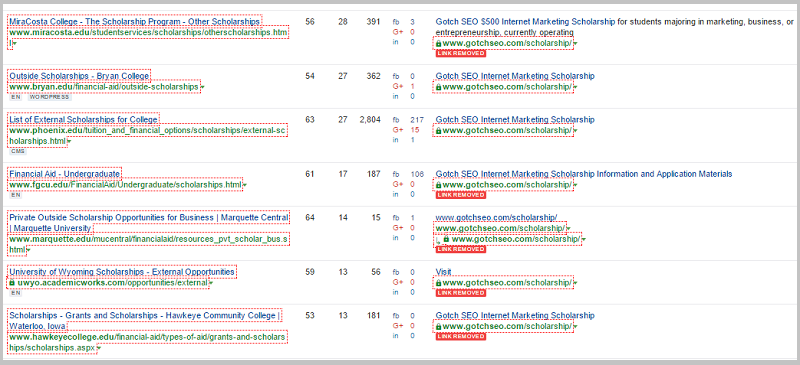

Scan through the list of backlinks and .edu websites with scholarship listing pages.
Once you've exhausted all possible link opportunities from one scholarship page, find another similar page and repeat the process.
Rinse and repeat.
MAKE SURE YOU ORGANIZE EVERYTHING
The key to properly scaling this .edu link building strategy is to organize everything.
I use a Google Docs spreadsheet for all tasks in a link building campaign.
Once you find a qualified link opportunity, include it in a Google Spreadsheet with all these required fields:
- Scholarship Listing Page
- Domains
- Relationship Status
- Name
- Email Address
- Remarks
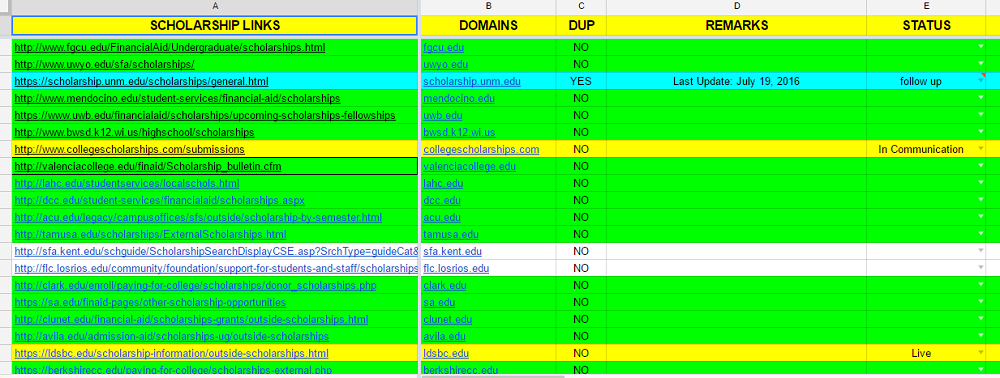

FINDING CONTACT PERSON
Universities and colleges have several staff members, and the only way to build Edu backlinks is to reach out to the right person.
There are two types of emails we consider for scholarship link building technique:
scholarship@domain.edu – you can get this email straight from the scholarship listing page
financialaid@domain.edu – if you can't find the first email above, look for this one by checking out the admissions and/or finance aid department/section of the website.
contact@domain.edu or contact form – if you can't see any of those emails above, you can simply send a simple message (email template later) to a generic email or through a contact form, asking for the right person to contact to about your request.
Step 4: Reach out to EDU Websites
When all details have been filled up, you are now ready to do outreach.
This is the exact email template that I used to reach out to .edu contact persons.
Scholarship for [ UNIVERSITY / COLLEGE ] students
Hello [ NAME ],
I noticed that you provide a list of private scholarship for students.
I'm sending you a message to let you know that my company offers one (1) [ AMOUNT] scholarship to [ UNIVERSITY / COLLEGE ] students that major in [ INDUSTRY ] courses.
Please feel free to contact me with any questions you may have so that I can send more information about our scholarship.
If it's not you who directly manages scholarships, can you forward me to the right person, please? I'd greatly appreciate that.
Regards,
[ YOUR NAME ]
When you send pitches to these people, you'll most receive three types of responses.
RESPONSE #1


If you receive this positive response, you just have to send all the details of your scholarship to them either via email or via a form that they will provide.
Once your scholarship is posted, they will give you a heads-up. If you don't receive a reply, make sure you monitor new backlinks to your site to see if you've got a backlink from one scholarship page. Pro tip: use Monitor Backlinks to ease this process.
Anchor texts on Edu backlinks are diversified: some are naked URLs, and others are exact scholarship titles.
RESPONSE #2


If you can only offer less than $1000 or $500, some Edu sites won't include yours in their scholarship listings since they have a certain threshold they consider.
RESPONSE #3


Another case is when financial/admission departments restrict scholarship listings to only one or two districts or local-based scholarships. See the response below.
A few more things:
- Some Edu sites don't list individual scholarship pages, but they get to add new scholarships from scholarship search engines. You can try submitting your site to scholarship search engines to increase the chance of getting an Edu backlink.
- Be specific with audience targeting because some EDU financial departments do not add any scholarships not thematically related to their students' courses (e.g. if it's a marketing-centric scholarship, don't dare to reach out to a psychology-based scholarship page).
WITHOUT SPENDING A PENNY
The title of this post says, "Without Spending A Penny."
That's true because I'll only spend some money ($500 in my case) on the scholarship award date. I would have received the returns on the efforts before the money was spent. A $500 budget for 14 links already amounts to $35 per 1 Edu backlink.
If you liked this post, subscribe to our newsletter and follow me on @venchito14.
Need help with your link building campaigns? Check out our link building services here.
EDU Backlinks Frequently Asked Questions
What are edu links?
Edu links are a valuable component of SEO strategy. An edu domain represents educational institutions like colleges and universities. The power of edu backlinks lies in their high domain authority and trustworthiness. By obtaining these links, websites can enhance rankings and visibility in search engines.
How do I get a backlink from a .edu site?
To get a backlink from a .edu site, try these effective strategies:
- Create valuable and relevant content that appeals to educational institutions.
- Guest post on .edu blogs or contribute to their resource pages.
- Reach out to professors or students for collaboration opportunities.
- Offer scholarships or sponsorships to universities.
- Join relevant forums or communities where .edu members are active.
- Conduct research and share findings with educational institutions.
- Build relationships with influential figures in the education field.
- Use social media platforms to engage with .edu communities and promote your content.
These strategies will help you establish quality backlinks from .edu sites.
Anchor Text: The Definitive Guide
What is an anchor text?
An anchor text is a clickable text that appears as a hyperlink and links to a web page. It tells search engines what the linked page is about, and its usage is an important factor in SEO. Anchor texts should be descriptive and relevant to the linked page's content to help users and search engines understand the page better.
This is an anchor text guide for beginners and advanced SEO and link-building practitioners.
What are the types of anchor texts?
The types of anchor texts are exact-match, partial-match, branded, naked link, generic, and images.
SEO-friendly anchor text is that which clearly describes the linked-to page's content and context, and the surrounding content should provide additional context. It is recommended to use various anchor text types to appear natural to both users and search engines. Remember that excessively using exact-match or other manipulative types can lead to penalties by search engines.
To simplify things, let’s say I want to rank for the term, “link building” and I’m publishing a post for another link building blog with a link to my web page.
If I’d use these types of anchor text, here’s what the link with each type of anchor text looks like.
Exact match anchors – the anchor text is the target keyword you’re trying to rank for.
I’ve shared at SharpRocket a post about link building that includes all actionable tips you need to get quality backlinks for your website.
Partial match anchors – the anchor text contains the target keyword or keyphrase you’re trying to rank for.
I’ve shared at SharpRocket a post about actionable link building tips you need to get quality backlinks for your website.
Branded anchor text – the anchor text is the name of the brand.
I’ve shared at SharpRocket a post about link building that includes all actionable tips you need to get quality backlinks for your website.
Naked URLs anchors – the anchor text is not a word or phrase but the URL of the page or domain itself.
I’ve shared at SharpRocket a post about actionable link building tips. See it here: URL
Descriptive anchors – the anchor text is a description of what the page or URL is all about, it may or may not include the target keyword.
This post at SharpRocket explains what link building is all about and 101 link building tips that includes the exact step by step processes to apply each of those tips.
Generic anchors – the anchor text is a generic phrase that does not include the target keyword.
I’ve shared at SharpRocket a post about link building that includes all actionable tips you need to get quality backlinks for your website. If you want to check it out, click here.
LSI anchors - the anchor text is a synonym or related word or phrase of the target keyword you’re trying to rank for.
I’ve shared at SharpRocket a post about off-page SEO that includes all actionable tips you need to get quality backlinks for your website.
Image anchors – the anchor text is the alt text of the image.


Google Penguin in 2012 and 2023 Forward
Before the Google Penguin update, websites could build massive article directories and guest post links with ~100% exact match anchor texts. This was not a problem for SEOs as they can automate everything, from prospecting link opportunities to putting these links into their desired pages, not considering the relevance between linking pages.
Private blog networks weren’t a big option for link builders then, too, since the usual massive spammy link building tactics were already enough to get website ranking results.
But then Google Penguin came in 2012, which affected websites in different industries. As you can see in the image below, it shows a few statistics of niche websites that were hit back then.
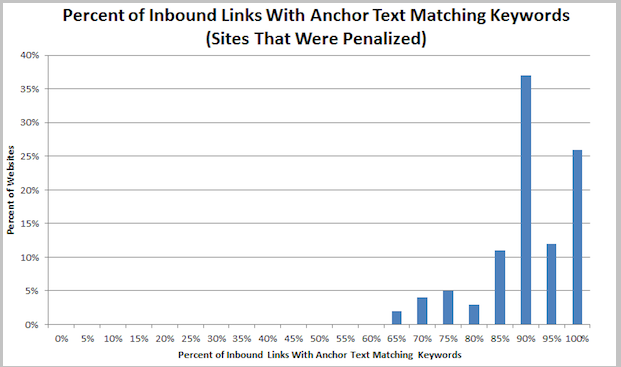

Anchor Text Usage
Anchor text usage on all inbound links is one factor Google considers in determining if a page should be penalized and demoted in its organic rankings.
Aggressive anchor text or too much exact match anchor text on all inbound links for a certain page isn’t a normal activity to think about. Websites with all backlinks with more than 50% exact match anchor texts, “payday loans” for example, are questionable to be natural in their backlinking method.
Source Website
Google’s Gary Ilyes has been tweeted/asked questions on Penguin 4.0 since its launch last September 23, 2016. One point he made is how Google Penguin targets a specific page. He clarified that it’s not just about the link, but rather the “source site” where the link comes from is what they also consider.
Questionable or penalized websites have much more risks to give to you when acquiring links.
To ensure you’re only building high-quality sites, check out the site’s organic traffic data if the linking site has a history of organic drop. This organic drop is a possible sign of Google penalties.
SEMRush can aid you with this task, so have someone check the site’s estimated organic data.
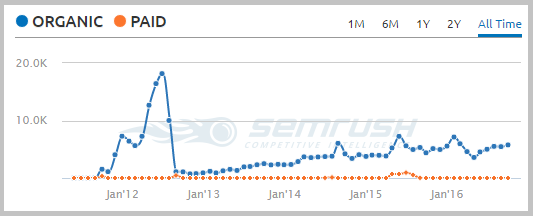

More Granular
The granular attack of Penguin on pages that need to be demoted in its rankings isn’t any newer to the search engine optimization community (in Penguin 2.0, it seemed to be on page-level and keyword-level concerns already). The only thing that becomes clearer here is the word “more”, which we should all consider as we work on the website’s link acquisition campaigns.
It’s just that Google considers page-to-page or a few website parts as its consideration for penalties. In that sense, you shouldn’t be confident enough to think that the spammy link building tactics you are doing right now won’t hurt your website’s health in the future.
More Google Penguin 4.0 Resources:
9 Anchor Text Optimization Best Practices
1. Avoid Acquiring Backlinks With Too Many Exact Match Anchors
I’ve worked with a lot of SEO agencies and digital marketing agencies all over the world, catering to 100+ clients throughout my SEO corporate experience, and there’s one thing people are still confused about:
Are exact match anchors good for my rankings?
When you answer them “YES” right away, they’ll defend you with their “NO”s and just tell you to use generic anchor texts, like click here and go to this site, because they think this is the best anchor text strategy.
Wrong.
Exact match anchor texts aren’t bad at all.
Ryan Stewart had an interesting short case study of how he could rank for Miami SEO after he published a guest post on Ahrefs with the exact match anchor text: “Miami SEO”.
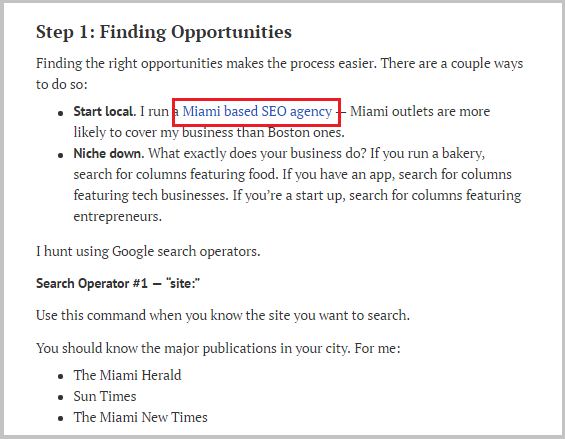

You don’t have to consider the anchor text distribution percentage in your backlink profile - say 3 or 5 percent.
You can test for yourself building one or two backlinks to your page with an exact match anchor text.
Don’t be afraid. Your site won’t get penalized with 1 or 2 backlinks. After all, if you have hundreds or thousands of backlinks, those 2 exact match anchor text links account for less than 1%.
Check how the site will react to those two backlinks and see what movements your page will take you (e.g. from position 40 to position 12). You’ll then also see how tight the competition is for the target keyword you’re trying to rank for.
2. Focus on Various Link Types
It’s so easy to be stuck with the idea of anchor text ratios. While running other SEO activities like technical audit, content creation, and outreach, you still have to think about establishing a natural backlink profile.
Instead of getting a headache with that issue, focus on the link type. After all, why must you create a list of anchor texts with exact/estimated percentages if you’re aiming for a natural link profile?
That itself is unnatural.
A natural link profile is composed of backlinks with different link types.
Here are some examples of different link types.
1. Community-based link
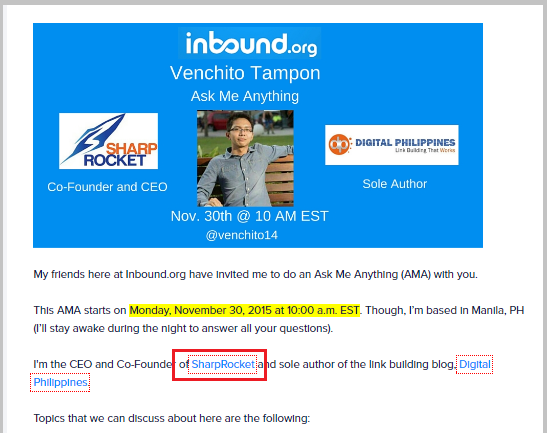

2. Referential link
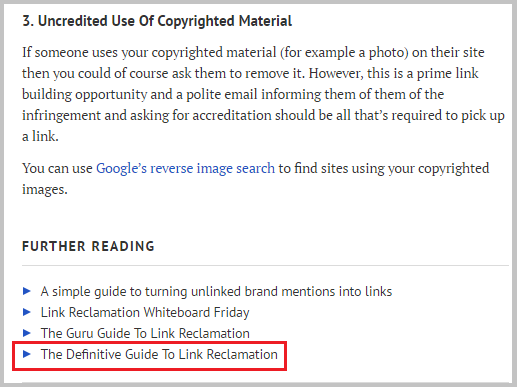

3. Blog comment link
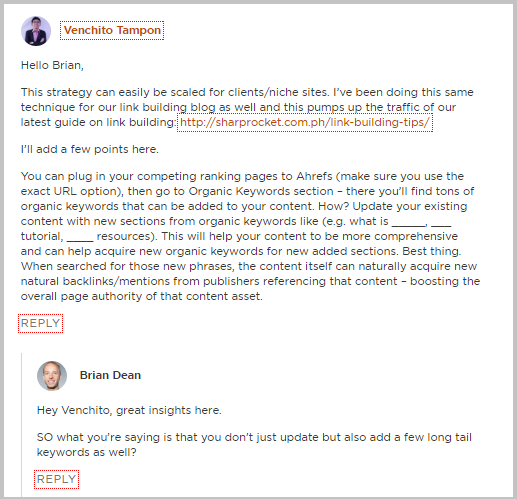

Don’t focus too much on anchor text variations, but ensure that you get various backlink types for your website.
Note: There’s one exception here, I’ve seen websites that focus only on contextual (both earned and built) and resource types of links, and they didn’t acquire directory or citation links but are still dominating SERPs. But if you’re into local SEO, combining those contextual and resource links with local-centric profiles/association/directory links is a must.
But if your site gets directory and citation links with a few to zero contextual backlinks, that looks unnatural.
3. Optimize Clicks Using Descriptive Anchor Texts
If you are still thinking about what anchor text strategy to use for your link building campaign, let me give you one simple tip.
If you are reaching out to bloggers in your industry (assuming it is a linker outreach approach), let them choose anchor texts.
They wouldn’t tell you what anchor texts they chose. They’d only give you a heads-up if they have linked to your page, and you’ll see the anchor texts yourself.
Most of the time, backlinks built using the linker outreach method are in descriptive anchor texts. The advantage of that anchor text is that it encourages user clicks.
While links can help increase rankings, their other purpose is to drive referral traffic.
Letting bloggers choose how and in what section of the linking pages they’ll add anchor texts with backlinks to your webpage affects the number of visitors those referring sites will drive back to your site. Backlinks placed on a higher position of the content have a high chance of more clicks.


One good example is the number of conversions (email subs) from my guest post on GotchSEO. That post itself drove 100+ impressions with 60+ converted email subscribers. That backlink is aimed to be clicked, given that it was placed under the bonuses section.
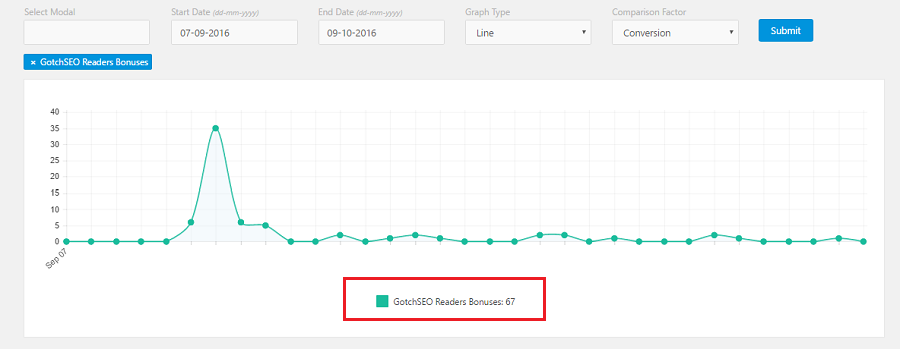

In cases where you have control over anchor text usage, i.e. content distribution on other blogs, it’s imperative to understand LSI and Co-occurrence as part of your overall anchor text strategy.
4. Understand and Use Co-Occurences
Co-occurrence s the frequency and proximity of similar keywords across one context in content. These are topically relevant keywords but not exactly the same as your ranking keyword.
Instead of frequently using your ranking keyword as your anchor text to be an exact match, what you can do is place your target keyword near descriptive anchor texts.
One good example of this is co-occurrences within links to Kaiserthesage. Here are a few examples:
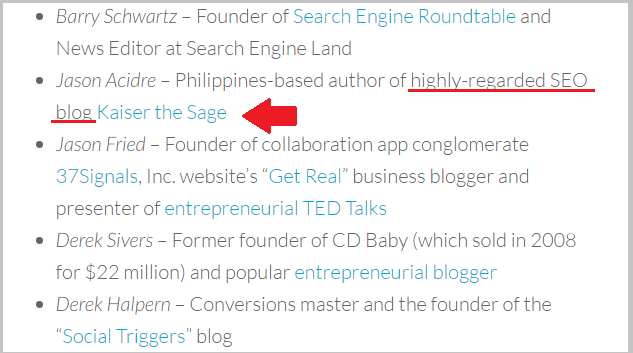

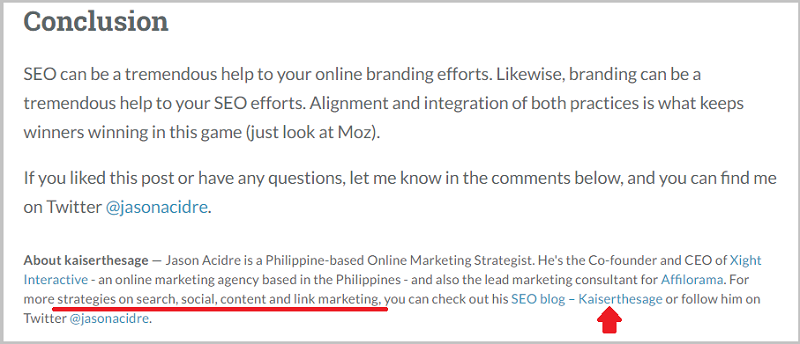



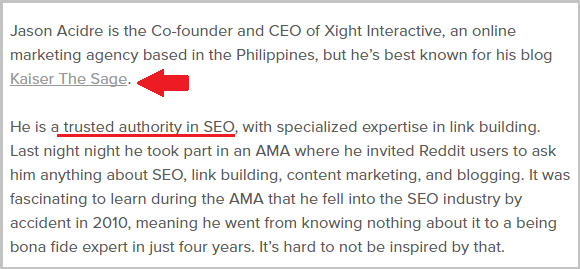

Google understands the relevance of a link without having to use exact match anchor texts all the time. Adding co-occurrences to linking pages can help search engines fully identify the context theme of your website with its linking web pages.
5. Find New Organic Ranking Keywords
When a linkable asset has been ranking for several long-tail keywords, finding untapped match keywords your content isn’t primarily catering to would be strategic.
You tend to rank these keywords (or had some impressions on SERPs) because search engines have highly perceived your content as worthy to rank for pages 3 or so.. (may not be visible on the first two SERPs pages).
The advantage when monitoring new keywords is that you can upgrade your content to cater to new audiences or be more desirable to rank for newly found organic ranking keywords by adding some topical sections to your piece.
What’s the implication of this to your anchor text link strategy?
If you’ve added a new section in your content piece to service those new organic keywords, it’d be additional anchor texts to use for internal and external manual link building. This will add more trust and authority to your content and help it dominate searches for those newly found organic keywords.
6. Search For Related Phrases and Instagram Trends
There is no such activity of finding new ranking keywords to add to your current list of target anchor texts, as you don’t want to use them all for exact match link strategy.
However, when trying to manually add descriptive anchor texts to internal linking pages and build linking pages (i.e. guest posts), you have to know what keyphrases are thematically relevant to your target keyword. Thus, it’d be easy for you to write robust content with LSI keywords and strategically do co-occurrences on links.
Two simple ways to find related search phrases of your target keywords.
First, do a straight Google search for the exact keyword or key phrase you’re trying to rank for. You can try two different searches. One is with quotes. The second is without. See at the bottom of search pages related search phrases Google provides based on the keyword you entered.
Second, just type in your keyword and wait for Google to suggest more specific/relevant search phrases. You’ll find out that some of them aren’t included in your keyword list from Google Keyword Planner or other common keyword research tools you use. They don’t need always to have a high search volume to decide whether or not they are good to target for content pieces.
If you ask me, where is this going? The answer is adding more keyphrases for your anchor text link strategy to be used for LSI keywords for internal and external content assets and to be better at co-occurrences on backlinks.
7. Optimize Content Using Content Gap Monitoring
I’ve been discussing how to find new organic keywords ranking in your content because these are useful for upgrading your content to its next version (or to 10x content if it hasn’t been achieved yet).
While you can simply focus on your content’s search results performance alone, you’d want to try seeing new organic keywords of similar content pieces your competitors normally produce.
The only difference between this process, which I’d like to label as “Content Gap Monitoring” with the typical “content gap analysis,” is that you’re doing it regularly – as part of your monthly SEO or content marketing activity.
SEO agencies that want to test this process out don’t have to worry about the time it’ll consume to run the entire process, as it is scalable through the use of Ahrefs as our primary content gap monitoring tool.
The first step is to find similar competing content. Only choose content assets that are specifically ranked for your target keyword. If you’ve done a robust competitor keyword research analysis as your first SEO initiative, you can skip this part already.
The second step is to monitor new organic keywords competing for similar content assets. Go to Ahrefs, then click on Alerts - New Keywords.
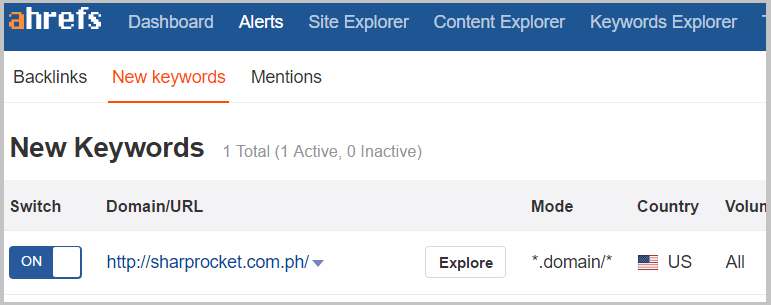

Click add alert button in the right section.


Choose URL as its mode, so you’ll only receive a list of new organic keywords that a specific page has been acquiring, not the whole domain. For volume, the default, “All” is good, so you can also see low-volume keywords.
For email frequency, it’s your decision whether to receive those organic keyword-centric emails weekly or monthly, but I highly recommend you go with weekly to upgrade your existing content for potential ranking keywords as sooner as possible.
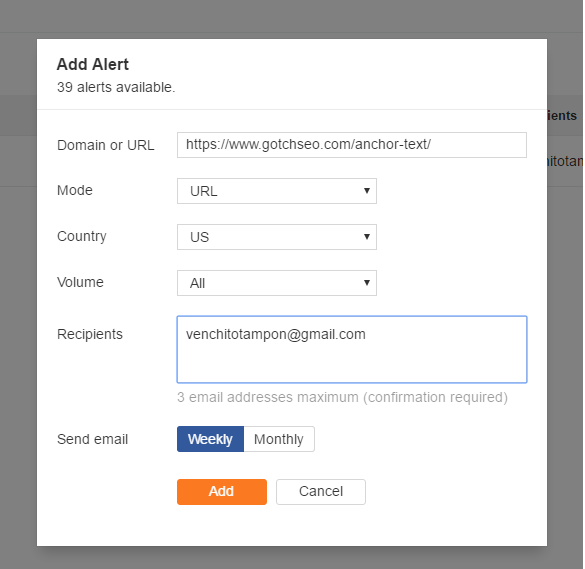

8. Backlink Audit on Exact Match Anchor Texts Links
With the recent Google Penguin update (most SEOs believe that it is indeed real-time), our activity to continuously monitor our site’s incoming links and make sure there aren’t any negative SEO isn’t any more a tedious task for us (SEOs/link builders).
If you have read posts on Google Penguin’s specific effects on SEO activities, there’s no need to make serious efforts to remove existing bad/toxic links to your website, as Google tends to devalue them anyway. So if a site has been receiving new low-quality links from a Negative SEO attack, for example, the efforts now shouldn’t be focused on removing those types of links but on continuously acquiring new high-quality backlinks for your site (this posts of mine on how to get backlinks and actionable link building strategies will help you a lot).
What’s the implication of this to my anchor text diversification?
In cases where those incoming toxic links are on exact match anchor texts, you don’t have to focus on removing them from your backlink profile but on driving new high-quality backlinks to your site. Since websites are dealt with granularly, those bad links won’t affect your site as a whole, only on parts that should be affected.
Nonetheless, a link audit is still a must. Google states that bad links are simply being devalued. The possibility of needing to disavow more links is unlikely. However, if you have a lot of unnatural links and never disavowed them, you need to disavow them. It may be why you’re still not recovering from the penalty.
You still have to do some groundwork for disavowing bad links. But keep in mind that while doing it, the focus shouldn’t just be there but more on helping your site continuously acquire good links to boost your site’s health over time.
If it’s real-time, your site can easily recover (some have proven this to happen to some fully/partially-recovered sites), and there’s much more work now to be put into higher-level link acquisition.
9. Convert High-Quality Exact Match Anchor Texss To Branded Links
Other posts on link audit (which I highly suggest need to be updated) discuss managing exact anchor text links by converting them into branded links.
In my experience, filtering your exact match anchor texts based on their quality should be everyone’s link builders/SEOs’ first initiative.
Don’t spend time converting low-quality exact match anchor texts to branded links, as these will be devalued (if it’s a negative SEO attack) or if they’ve been built by your past SEOs (do a link audit and link removal/link disavow).
What you have to focus on now is checking on only existing high-quality exact-match anchor text links. These links shouldn’t just be any type, i.e. directory or any massive link type, but only editorial links that are manually built, i.e. guest blog posts.
Whether or not these high-quality exact-match links are affecting parts of your website, you should still be converting them into branded links (as possible as you can), by manually reaching out to web admins to whom you’ve contributed guest posts in the past. Ask them if they are capable of changing those exact matches to branded types of links. This should help some parts of your site not to be negatively affected by real-time Penguin.
Now It’s Your Turn…
How do you diversify your backlinks' anchor texts?
Or maybe you have a question about implementing any of the insights in our above list?
Either way, leave a comment quickly below.
I'll be more than happy to reply to comments and answer questions.
So if you have a question, insight, or new tactic, leave a comment right now.
Anchor Texts Frequently Asked Questions
What is anchor text vs keywords?
Anchor text and keywords are two important elements in SEO. Keywords refer to the words or phrases you want to rank for on your webpage, while anchor text is the clickable text in a hyperlink that leads to another page.
In other words, the anchor text provides context to the link and helps search engines understand what the linked page is about. Using descriptive and relevant keywords in your anchor text is crucial to optimize your webpage's ranking.
What is the content of anchor text?
The content of anchor text refers to the words that make up the clickable link. It gives users and search engines context about where the link will take them. Using relevant and descriptive anchor text is important to improve the user experience and help search engines understand the page content. Keep it brief, clear, and concise for maximum impact.
How to Find Who Links To Your Website
Knowing who links to your site gives you a starting point in your link building.
If your website has been around for a while, you want to know the sites interacting with you. Those are the brands that can become your company partners, future advocates, or content collaborators.
There are many ways to find who links to your site, but here is one great tool to get you started.
Table of Contents
AHREFS SITE EXPLORER
Ahrefs is by far the world's largest backlink index with a total of 15 trillion (it has more than that I guess).
Knowing that gives you the confidence of finding all the recent and finest links pointing to your site.
Ahrefs' Link Explorer gives you a wide array of information, including the exact referring page where the link is placed, potential traffic the site might bring to your site (Traffic), and the anchor text used on those links.
The good thing is you can use Ahrefs' Backlink Checker for free.


For example, if I want to know how many links are pointing to this website, www.healthysleepy.com I'll simply enter the exact URL to the checker, and click the "Check backlinks" button.


This opens up a data of information called backlink profile.
Before I go to what comprises backlink profile. let's see the numbers initially seen.
As you can see, the domain rating is 16. I sourced the exact definition of domain rating from Ahrefs , if you're not familiar with Ahrefs' Domain Rating.
Domain Rating is a proprietary Ahrefs’ metric that shows the strength of a target website’s total backlink profile (in terms of its size and quality). DR is measured on a logarithmic scale from 0 to 100, with the latter being the strongest.
There are 110 backlinks pointing to the site (answering how many links to my website?), with 97% of those being do follow backlinks.
Forty-seven (47) referring domains from 110 backlinks are 96% do-follow.
The good thing with Ahrefs is that it gives you a rundown of the numbers that you need to know in a backlink profile.
Now, let's have a look at who links to your website.
AHREFS SHOWS YOU WHO LINKS TO YOUR WEBSITE
Scroll down the page, you'll now see who links to your site.
In our given example, U.S. Pain Foundation, Alaska Ocean Observing System, Gallatin, and Kirkwall East Church are some of the brands linked to HealthySleepy.
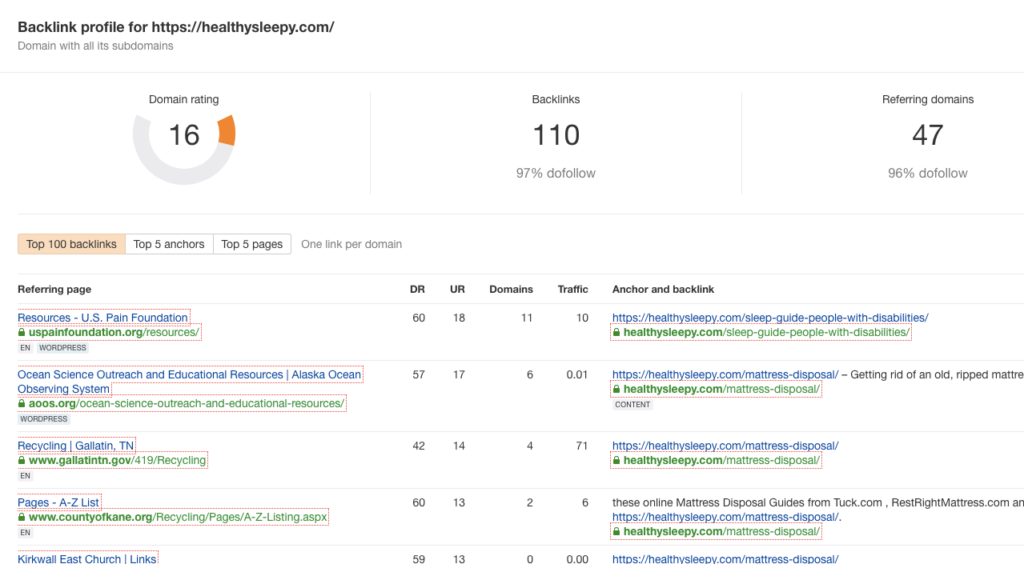

There are a lot more if you scroll down-its up to 100+ backlinks. However, Ahrefs can only show you 100 of the backlinks. If you want to see more, it will require you to subscribe to their starter package tool.
Nonetheless, it's a great free tool to know who links to your website.
WHAT TO DO WITH WHO LINKS TO YOUR WEBSITE?
Now you know who links to your site. The next question to answer is what will you do about it.
It's one thing to have a list of pages/websites linking to your brand's domain. It's another thing to do something with the list.
Here are some tips you can apply to make the most out of your list.
1. Try to understand why they linked to you
This may sound absurd. But there's a way to know the reason why the owner of the site/page linked to you in the first place.
For example, a contextual link (a link placed within the body of the content) is an indication of many things such as:
- The content publisher, blogger, or writer found one of your articles on your blog worth referencing, so he/she mentioned it and credited you with a link.
- The curator of another website listed your product in one of the recommended products on a specific category, with a link on the anchor text.
- The writer quoted one of your statements on a press article with a link pointing to your about me or your staff page in your company site.
There are many other reasons why you were able to get the link.
If the brand or website who linked to you is someone you're familiar with, it would be easier for you to know the reason for linking - either it's from a previous relationship or partnership both of you are involved in or because of the value of the content piece you've provided on your blog.
If you understand the reason why your existing linkers linked to you, you would be able to get multiple links from the same set of linkers as well as replicate the same strategy to other possible linkers in order to acquire the same type of links.
2. Start collaborating and connecting with your linkers
It's a myth in link building that all who are linked to your site differ in their needs and context. The truth is your existing linkers may have a common need and reason for linking.
If you can nurture relationships (because you probably had connections with them already), you are opening doors of more linking opportunities. These opportunities may not be always coming directly from them, others would be recommending your site/brand or any offering you had to their peers or circles of networks.
If you know the email addresses of your linkers, you can send them individual messages with thank you notes, particularly if the links you acquired are organic — meaning you didn't do anything, even a manual outreach, to get the links.
You want to have a group of serial linkers. Joshua Hardwick of Ahrefs calls them as such because these are the people who've linked to your site multiple times.
In fact, you can actually see who links to your site many times using the top linking sites in Ahrefs.
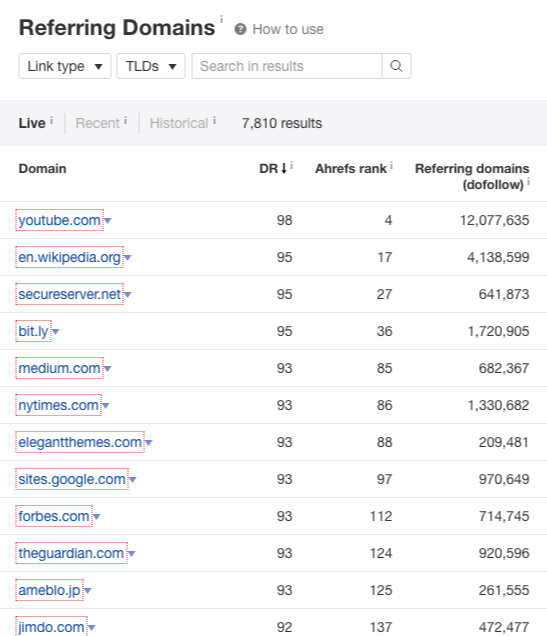
3. Brainstorm what works for your brand's content strategy
You may have published several content pieces that have gotten you enough links to track (who links to your site as we know).
Interestingly, you would discover patterns of content that work for your brand and have provided great value in your industry — which allowed you to acquire links to your site.
You want to know the type of content that works for your site because finding the pattern gives you insights into your next content marketing plan.
Enter the URL of your site and go to Ahrefs' Best Pages. This will give you a rundown of your site's top pages sorted from highest to lowest incoming referring domains.



Study the pattern of the type of content that gives you the most number of links. If you are just starting to build your own brand and haven't been involved much in link building, I recommend you do this methodology first to your competitors.
See what works for them in terms of a content type. Replicate it to your brand if it's feasible according to your brand's resources.
4. Fix broken links to your site
By tracking who links to your site and your best linkable pages, you may find a few or a couple of your pages to be broken (404).
If those pages have links pointing to them, they're a must to be reclaimed.
Otherwise, your previous efforts to build links to those pages may be forfeited somehow and you don't want those links to be missed.
What you need to do is to identify your site's broken pages. Filter your best pages by incoming links to only give you 404/broken pages.
Check each page and decide what options best work for it.
Either you redirect the dead page to a more relevant functional page or ask linkers to link to another working page relevant to the dead page.
There's no best option. It depends upon the situation. The first option is easy as it is something you can control; the second one might require you to send emails to all linkers. Take note that you won't be sure of the response time and modification of your linkers if you choose the second option.
WHO LINKS TO MY SITE IS THE INITIAL TOUCHPOINT
Having the list of pages linking to your overall site or to only one page is the first initiative. The next step is to understand why they've linked to you in the first place — in order to replicate the same approach to your next set of actions or do the same thing to your other sites.
Feel free to comment below if you have any recommendations on what to do with the list of pages that have linked to the site.
